Abstract
Eriocaulaceae is a pantropical family whose main center of biodiversity is in Brazil. In general, the family has about 1200 species, in which phytochemical and biological studies have shown a variety of structures and activities. The aim of this research is to compile the compounds isolated in the Eriocaulaceae family and carry out a computational study on their biological targets. The bibliographic research was carried out on six databases. Tables were built and organized according to the chemical class. In addition, a summary of the methods of isolating the compounds was also made. In the computational study were used ChEMBL platform, DRAGON 7.0, and the KNIME 4.4.0 software. Two hundred and twenty-two different compounds have been isolated in sixty-eight species, divided mainly into flavonoids and naphthopyranones, and minor compounds. The ligand-based virtual screening found promising molecules and molecules with multitarget potential, such as xanthones 194, 196, 200 and saponin 202, with xanthone 194 as the most promising. Several compounds with biological activities were isolated in the family, but the chemical profiles of many species are still unknown. The selected structures are a starting point for further studies to develop new antiparasitic and antiviral compounds based on natural products.
1. Introduction
Eriocaulaceae is a pantropical family, which comprises around 1200 species divided in ten genera [1]. It is easily distinguished from other families due to most of its species presenting short stems, leaves in a rosette form, and long scapes grouped in capitula [2,3].
Brazil is the main center of Eriocaulaceae biodiversity, where there are a total of 610 species, 548 of them being endemic, and distributed in eight genera, with one endemic genus. Some species, belonging to Syngonanthus and Comanthera genera, are economically important, being commercialized as ornamental objects and commonly exported as “everlasting plants.” In addition to those, in regions called “campos rupestres,” in the states of Bahia, Goiás, Minas Gerais, and Tocantins, the plants that occur naturally are one of the main sources of income for local inhabitants [3,4,5].
Among the genera from Eriocaulaceae, Eriocaulon is the biggest, with 478 species, and the only one with a pantropical distribution. It is an aquatic and wetland genus. In Brazil it occurs in all domains of the country and has 61 known species. The greatest diversity of Eriocaulon is in the Cerrado, where about 80% of species are endemic [6,7,8].
Paepalanthus is the second most expressive genus in number of species, comprising around 400 species and occurring specially in the Americas and a few species in Africa [7,9]. In Brazil, 348 species of Paepalanthus can be found, thus making it the third largest genus in Brazilian flora and the largest among Brazilian monocots [9,10,11]. Despite the many species, phytochemical studies on the genus have focused on only 16 species.
Natural products are a great source of active principles, and many molecules have potential activity for various biological functions [12]. A study by Newman and Gragg (2020) found that 68.8% of new accepted drugs are either natural products or inspired by natural product molecules [12].
Thus, natural products are widely used in the virtual screening technique, which seeks by computational tools, in silico, to identify molecules with active potential [13,14]. The ligand-based virtual screening is a computational technique that uses pools of molecules with biological activity information to build predictive models and then predict activity pools of molecules whose activity information for the selected biological functions is unknown [14,15,16]. It is a very effective tool in the search for new drugs and avoids unnecessary laboratory experiments, thus reducing the analysis cost and time [14,15,16].
Neglected diseases are a group of diseases common among the world’s poorest populations, which suffer from lack of resources, poor health infrastructure, and substandard sanitation [17,18,19]. They are a global health problem. The World Health Organization classifies 17 diseases as neglected diseases, including leishmaniasis, Chagas disease, schistosomiasis, dengue fever, etc. [20,21].
Dokkedal et al. [22] published the first and only article on compounds isolated from the Eriocaulaceae family in 2008. The authors described flavonoids, naphthopyranones, and xanthones from Paepalanthus, Syngonanthus, and Leiothrix. Thus, this study aimed to carry out a bibliographic search on compounds isolated from the family from the first paper to the current year and to evaluate their possible biological activities against neglected diseases by ligand-based virtual screening. This research found other compounds from the mentioned classes plus saponins, quinones, and others. The computational study evaluating neglected diseases showed saponins and xanthones had the best results.
2. Results
2.1. Chemical Constituents of Eriocaulaceae
Table 1, Table 2, Table 3, Table 4, Table 5, Table 6, Table 7 and Table 8 show the structures of the compounds 1–222, isolated from sixty-eight species, from different organs and fungi. The most predominant metabolites are flavonoids and naphthopyranones, which have been used as chemical markers for some taxa in Eriocaulaceae, mainly Paepalanthus genus [23,24]. Other classes such as xanthones, saponins, steroids, anthraquinones, naphthoquinones, and minor derivatives such as tocopherol, spirocyclic lactams, curvulinic acid, and caffeic acid were also isolated.
2.1.1. Flavonoids
Flavonoids are a class of aromatic and polyphenolic compounds that come in various structural forms and are divided into groups according to the oxidation and unsaturation of the C-ring [25]. Those compounds have several biological activities such as antioxidant, antitumoral, anti-inflammatory, antiviral, and antimicrobial, among others [25,26,27,28].
The first paper found about flavonoids compounds in the Eriocaulaceae family indicated their isolation from Eriocaulon genus. Six species were studied by Bate-Smith and Harborne (1969), where quercetagetin (1) was isolated from Eriocaulon septangulare and E. brownianum. According to the authors, compound (1) was previously reported in E. nilagirense, E. decangulare, E. sexangulare, and E. wightianum. Compound (2) was isolated from E. brownianum and E. truncate, in a crystalline form, showing a bright yellow-brown color in UV light. That compound was identified as patuletin, the 6-methyl ether of quercetagetin. Quercetin (3) was also found in E. brownianum [29]. According to Dokkedal et al. (2008), (1) was reported in Paepalanthus ramosus and (2) in P. macrocephalus and P. macropodus [22].

Patuletin (2) was also isolated from Eriocaulon buergerianum. The whole plant was extracted with 95% ethanol and the concentrated crude extract was partitioned with EtOAc. The EtOAc extract was submitted to separation by chromatography in a silica gel column. Compound (2) had effects on the gene expression and activity of fatty acid synthase (FASN) in the human breast cancer SK-BR-3 cell line, and apoptotic effects on breast cancer cells. MTT assays and flow cytometry were also used to measure cell growth and cell apoptosis, respectively. As a result, patuletin may be considered a natural inhibitor of FASN, inducing anti-proliferative and pro-apoptotic effects in human breast cancer [30].
Dokkedal and Salatino (1992), studying Leiothrix species, extracted flavonoids from dried and powdered leaves with 80% MeOH. In addition to Luteolin C-glycoside, the authors also isolated compounds 4, 5, 6, 7, 8, and 9, which were identified by chromatographic techniques and compared with known compounds. All compounds are flavone derivatives, based on luteolin structure [31].
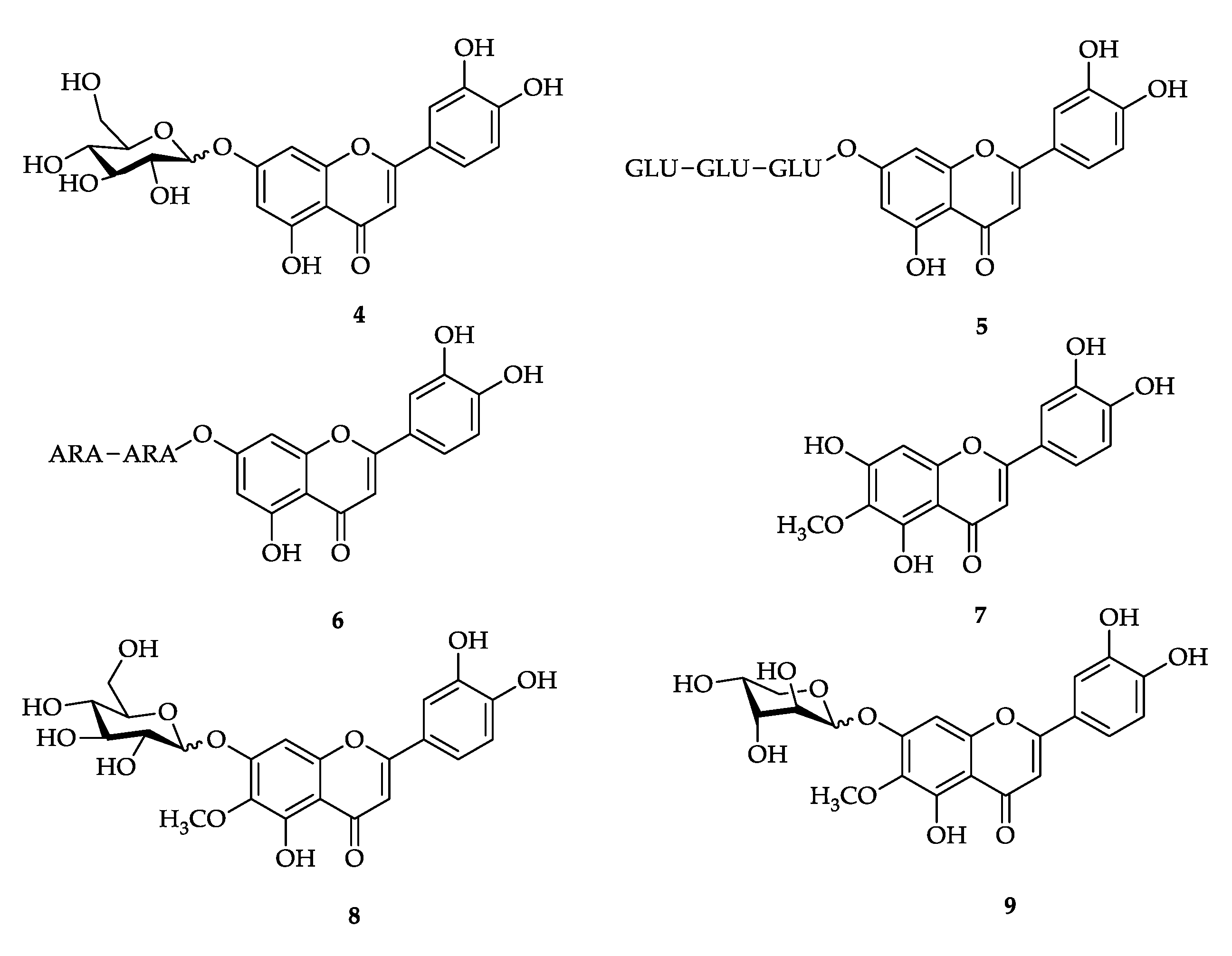
A study by Mayworm and Salatino (1993) isolated flavonoids 2, 10–15 from capitula of Paepalanthus species. Methanolic extracts of Paepalanthus bifrons, P. hilairei, P. planifolius, and P. robustus were submitted to preparative chromatography and the flavonoids were purified in a Sephadex LH-20 column [32].
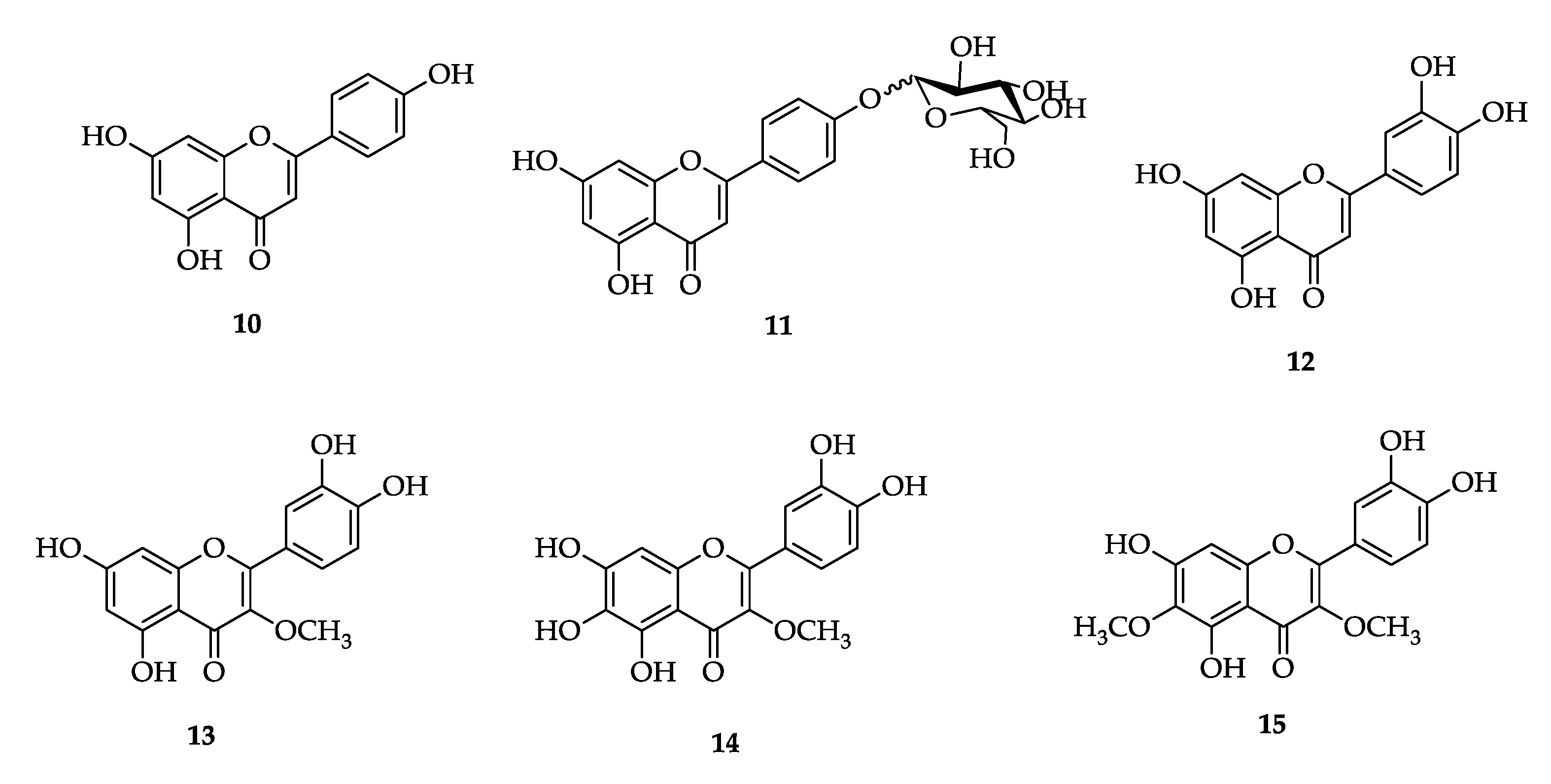
Flavonoids were quantified in methanolic aerial part extracts of Paepalanthus giganteus and Syngonanthus nitens by LC-PDA with co-injection experiments. Quercetin (3) was identified in capitula and scapes of P. giganteus and luteolin (12) in capitula and scapes of S. nitens [33].
Twenty-two species from Syngonanthus genus were phytochemically studied. From them, thirty-nine flavone glycosides have been identified, but not all could be drawn due to lack of information. The dried and powdered leaves of Syngonanthus spp. were extracted with 80% MeOH under reflux. The fractionation was performed with preparative chromatography and/or column chromatography. Flavonoids mono, di, and triglycosides (4, 16–26) were identified by thin layer chromatography (TLC) and glycosides by standard methods [34].
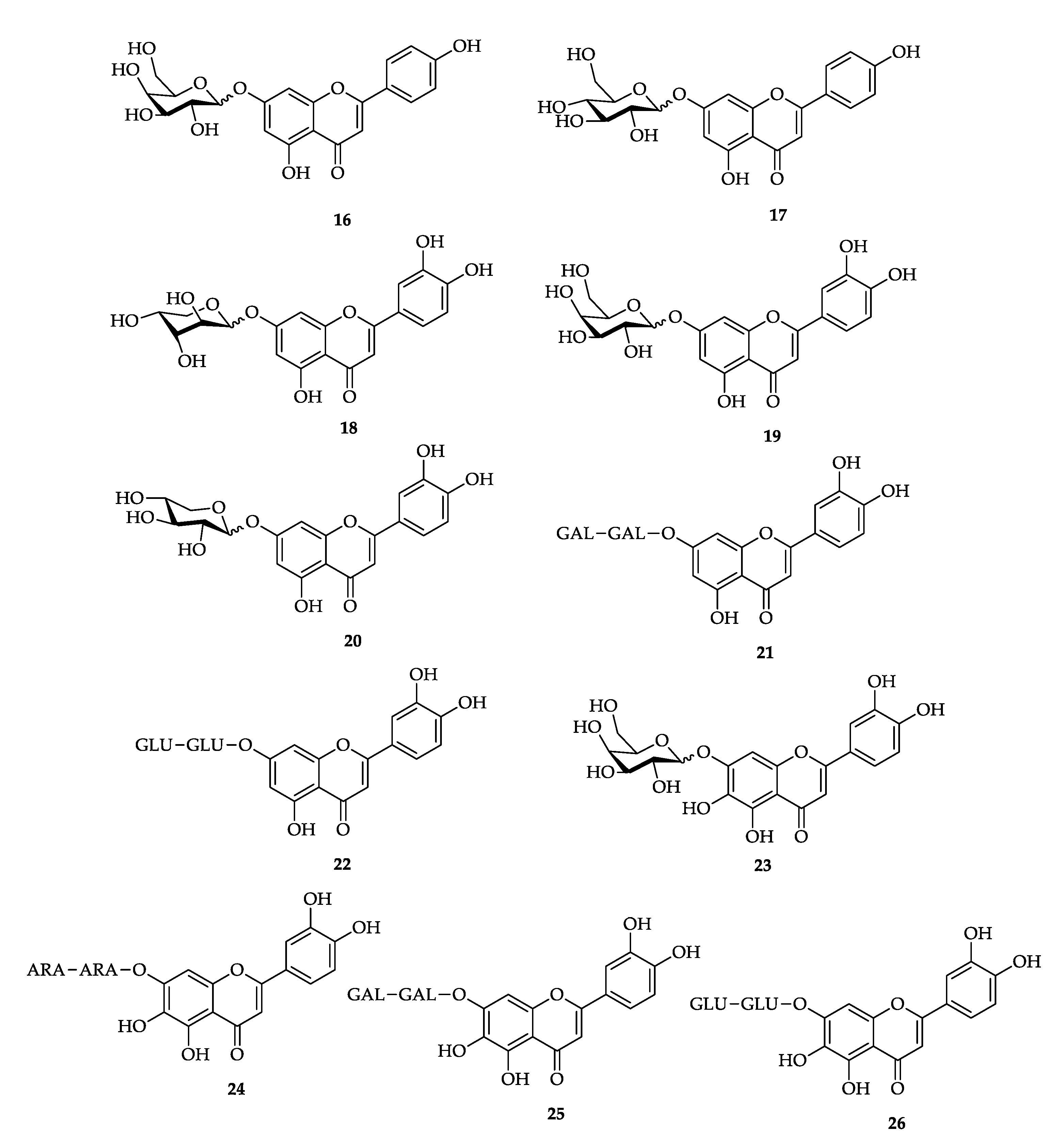
Studying EtOH extracts of the capitula of Paepalanthus polyanthus, P. hilairei, P. robustus, P. ramosus, and P. denudatus, [22] isolated two new and taxonomically relevant acylated flavonoids, 6-methoxykaempferol-3-O-β-D-6′’-(p-coumaroyl)-glucopyranoside (27) and 6-methoxyquercetin-3-O-β-D-6′’-(p-coumaroyl)-glucopyranoside (28). In addition, flavonoids quercetagetin (1), patuletin (2), quercetagetin-7-O-glucopyranoside (29), patuletin-3-O-glucopyranoside (30), patuletin-3-O-rutinoside (31), 6-methoxykaempferol (32), and 6-methoxykaempferol-3-O-glucopyranoside (33) were also isolated. Their structures were determined by spectroscopic and spectrometric methods [35]. Additionally, according to Dokkedal et al. (2008), 30 and 32 were reported in P. brachypu, 32 and 33 in P. vellozioides and P. latipes, and 33 in P. planifolius [22].
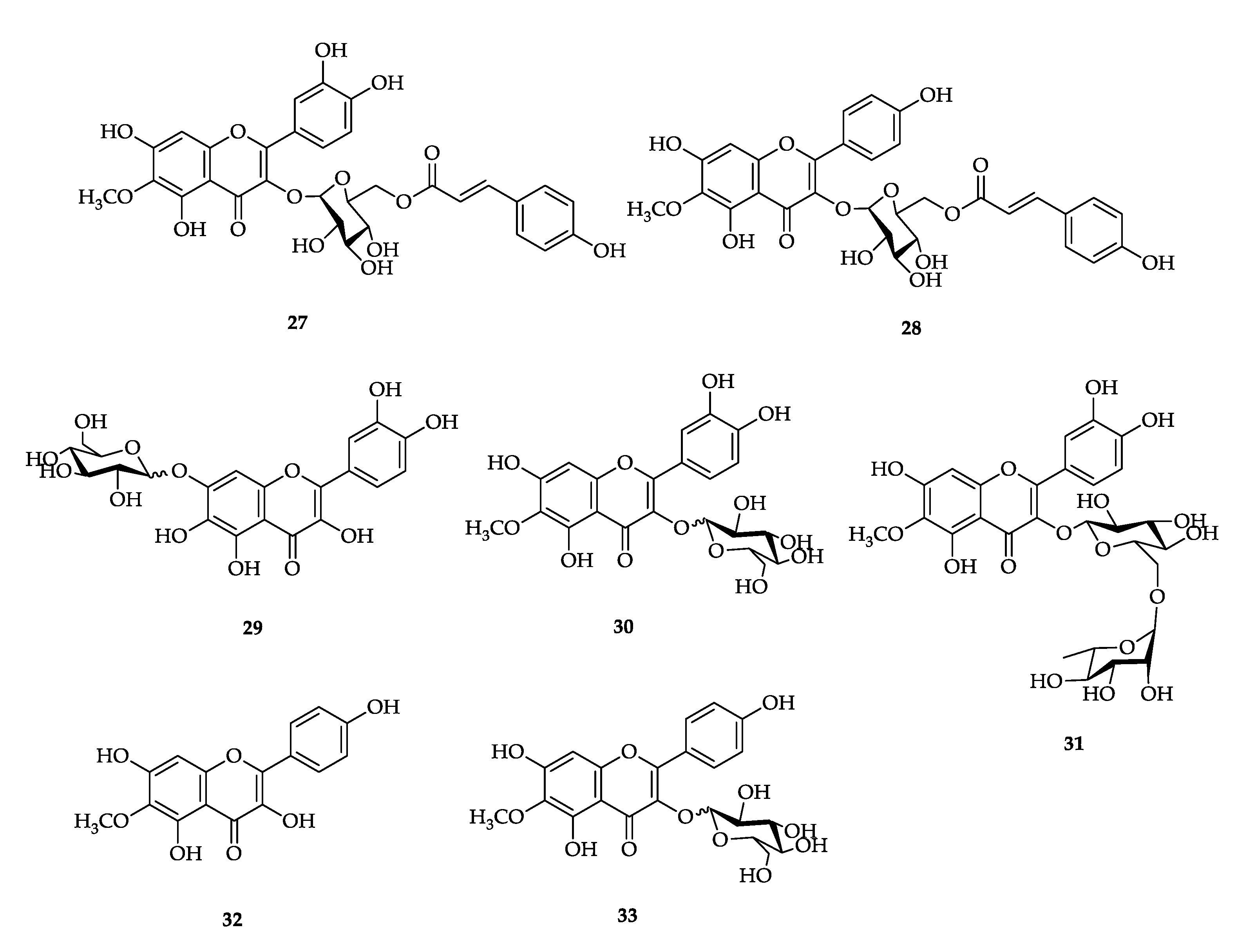
One aglycone (34) and five glycosylated flavonoids (35–39) were obtained from fresh leaves of Paepalanthus vellozioides and P. latipes after extraction with ethanol and chromatographic procedures. Most compounds have the glycoside group attached to the 3-position of the flavonoid skeleton [24]. Additionally, according to Dokkedal et al. (2008), 34 and 36 were isolated in P. bromelioides and 35 in P. planifolius [22].
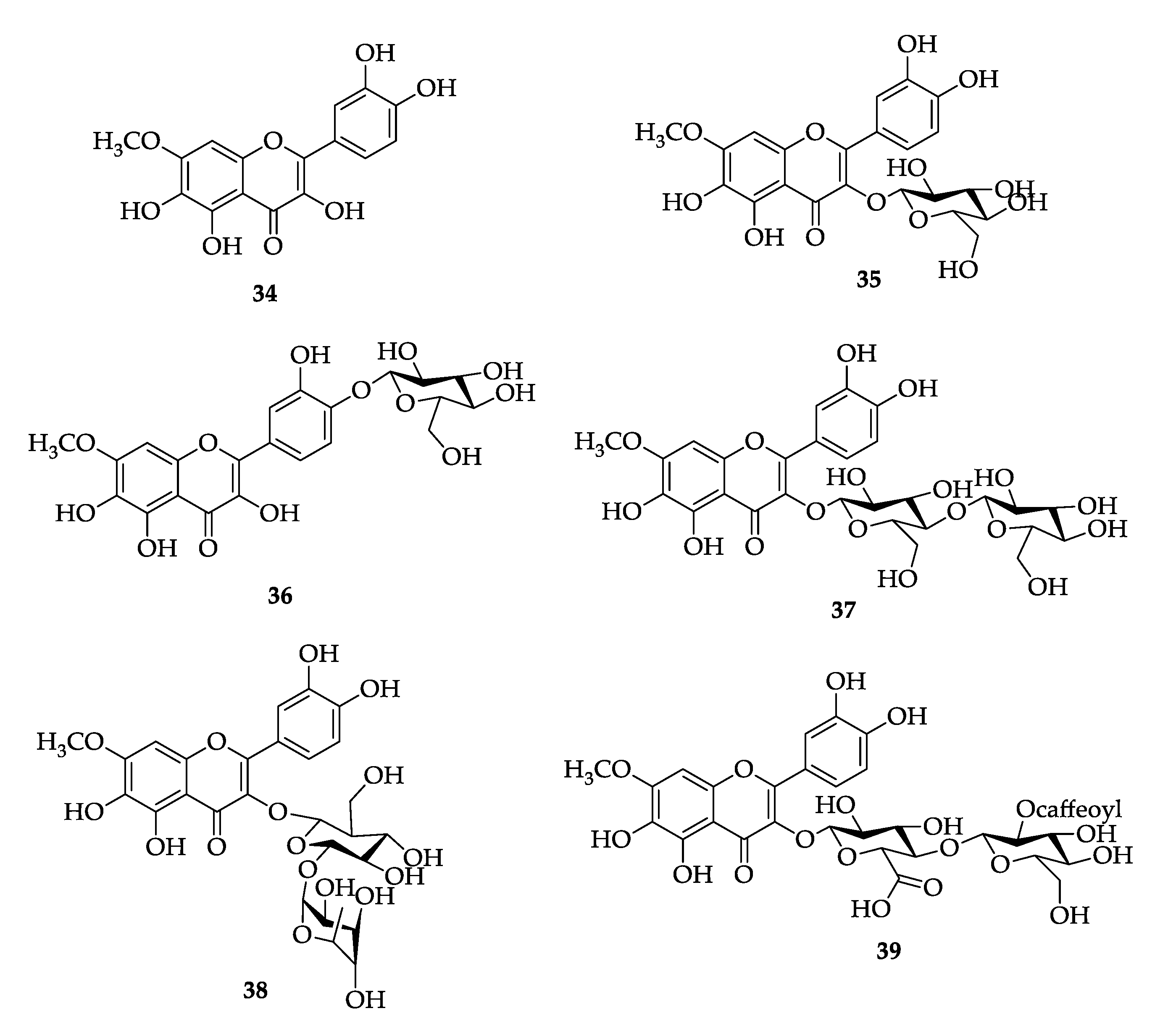
Moreira and collaborators (2002) studied the ethanol extract of scapes of the Paepalanthus latipes. Two flavonoids (34 and 36) were isolated, and the mutagenic activity of the metabolites and the crude extract was evaluated against different mutant strains of Salmonella typhimurium (TA98 and TA100). None of the flavonoids nor the crude extract showed mutagenic activity induction in bacteria [36]. Eleven years later, another study with aerial parts of the same plant obtained the same metabolites. Antimycobacterial activity was performed against Mycobacterium tuberculosis (H37Rv ATCC 27294) and Mycobacterium avium (ATCC 15769) and showed a low activity of the flavonoids and ethanolic extract [37].
Santos et al. (1999) obtained ethanol extracts from four different species of Paepalanthus: P. hilairei, P. bromelioides, P. vellozioides, and P. latipes. Nine flavonoid metabolites (32, 33, 2, 40, 29, 41, and 42) were obtained after fractionation by droplet countercurrent chromatography (DCCC) followed by column chromatography [38]. Dokkedal et al. (2008) also reported the presence of 32 in P. macropodus and 41 in Leiothrix curvifolia in their review [22].

The on-line separation and identification of two 6-methoxykaempferol glycosides previously isolated (28 and 33) has been performed with an HPLC-NMR coupling using C-30 phase. Flavonoids were isolated from Paepalanthus ramosus capitula ethanolic extracts [39].
In 2001, studying the phytochemistry of Leiothrix curvifolia and L. flavescens, Santos and collaborators isolated seven flavonoids from EtOH extracts after separation in Sephadex LH-20. The flavonoids 10, 12, and 43 were isolated in L. curvifolia and the flavonoids 44–48 in L. flavescens [40]. According to Dokkedal et al. (2008) in their review, compound 47 was also found in Syngonanthus bisulcatus [22].
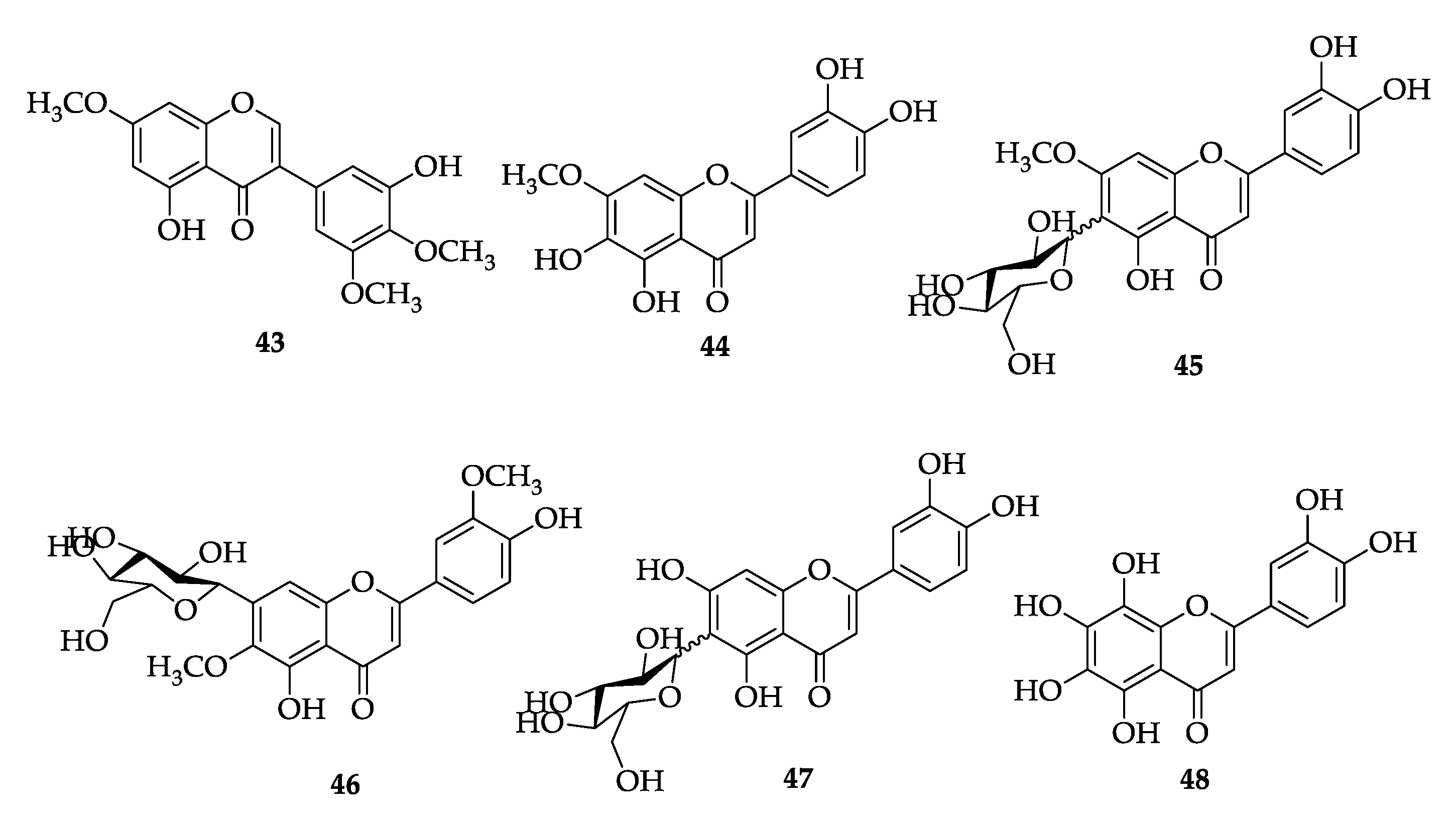
Dried leaves of Paepalanthus chlorocephalus and Paepalanthus argenteus var. argenteus were used to prepare a methanolic extract. The analysis of the extracts resulted in the identification of the constituents jaceosidin (41) and its glycosylated derivative, jaceosidin-7-glycoside (46), for the extract of P. argenteus var. argenteus, whereas for P. chlorocephalus the metabolite nepetin (6-methoxyluteolin, 7) was identified [41].
Capitula and scapes of Paepalanthus polyanthus were powdered and extracted with different organic solvents. The EtOH extract was chromatographed on a Sephadex LH-20 column with MeOH as eluent. This procedure led to isolation of five flavonoids: 6-methoxyquercetin-3-O-β-D-glucopyranoside (30), patuletin-3-O-β-D-rutinoside (31), quercetagetin 7-methyl ether-3-O-neohesperidoside (38), 5,6,7,8,3′,4′-hexahydroxyflavonol (49), and the new 6-methoxyquercetin-3-O-(6′’-E-feruloyl)-β-D-glucopyranoside (50) [42].

Capitula of Paepalanthus macropodus were powdered and extracted successively with different solvents. The EtOH extract was chromatographed on a Sephadex LH-20 column with MeOH as eluent. Three flavonoids metabolites were isolated: 6-methoxyquercetin-3-O-β-D-glucopyranoside (30), 5,6,7,8,3,4-hexahydroxyflavonol (49), and quercetagetin-6-methyl-ether-3-O-β-D-glucopyranosyl(1→4)-glucopyranoside (51) [43].

Four flavonoids, (2S)-3′,4′-methylenedioxy-5,7-dimethoxyflavan (52) and hispidulin 7-(6-E-p-coumaroyl-β-D-glucopyranoside) (53), hispidulin (54), and hispidulin-7-O-glucoside (55), were isolated from the capitula of Eriocaulon buergerianum Koern. Their structures were established by spectral and chemical evidence [44].
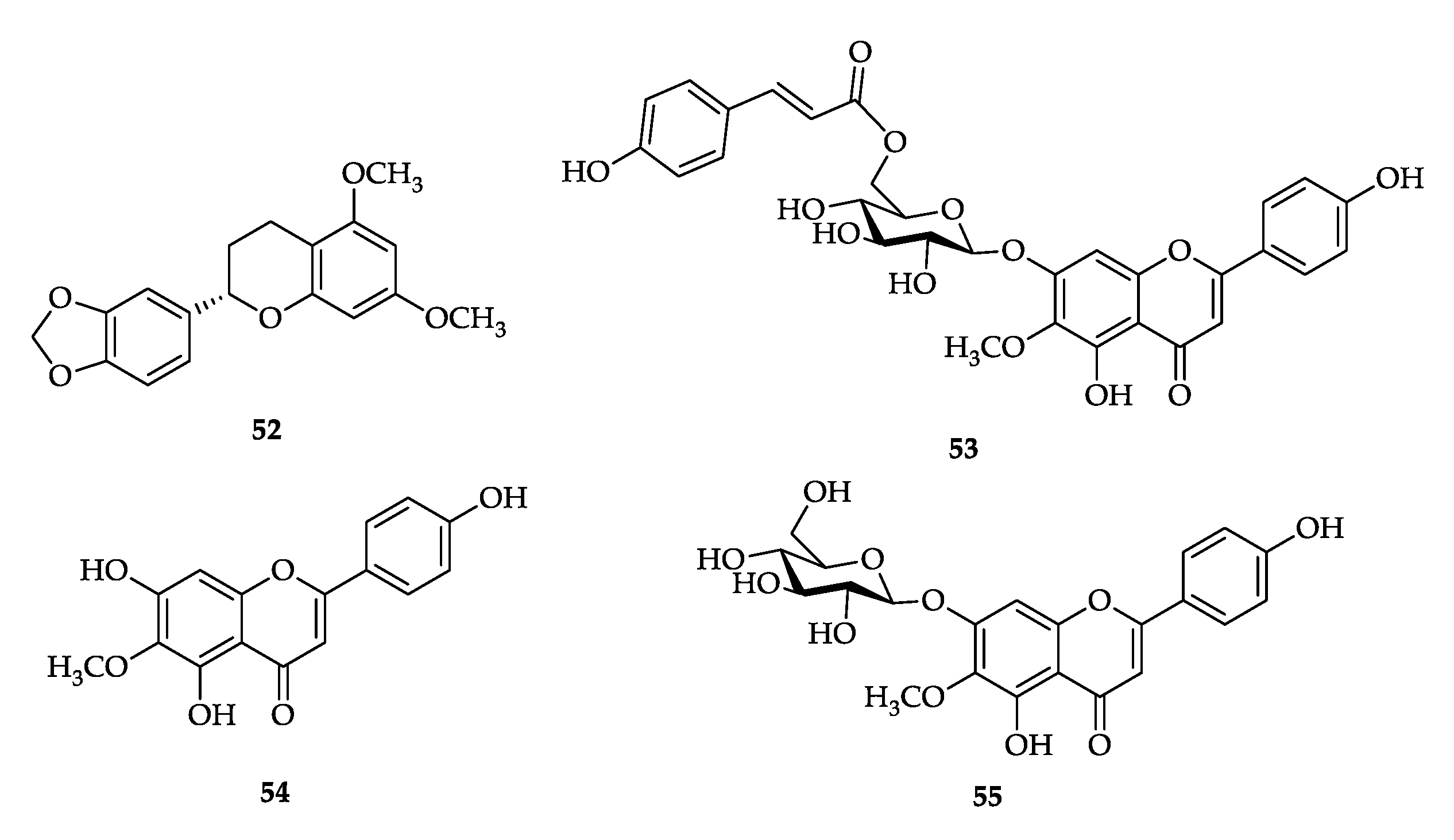
The ethyl acetate fraction of Leiothrix flavescens was fractionated by high-speed counter-current chromatography (HSCCC) using the mixture of n-hexane:ethyl acetate:methanol:water, 1:5:1:5 (v/v/v/v). The lower phase of the solvent system was used as a stationary phase and the upper one as a mobile phase. Some fractions provided yellow solids identified as flavonoids when sprayed with NP/PEG reagent. The substances were purified in a Sephadex LH-20 column and eluted with methanol. This procedure identified apigenin (10) luteolin (12), and 6-methoxyluteolin (54). The antioxidant activity of methanol extract was evaluated by the DPPH method, showing that the crude extract is more active at a concentration above 80.0 g mL−1 when compared with the acid gallic standard. Phenolic compounds were also quantified by using the Folin–Ciocalteau reagent method. According to the authors, the total phenol concentration in 1.0 g of the methanol extract is 47.0 mg [45].
Three flavonoids, 3′,4′,5,6,7,8-hexahydroxyflavone (48), 3′,4′,5,6,7-pentahydroxyflavone (56), and 3′,4′,5,6-tetrahydroxy-7-O-β-D-glucopyranosilflavone (57), were obtained from ethanolic extract of Paepalanthus microphyllus capitula [46]. According to Dokkedal et al. (2008) in their review on Paepalanthus chemistry, compound 56 was also isolated in Paepalanthus robustus, P. planifolius, and P. flavescens and 57 was also found in P. planifolius and P. flavescens [22].
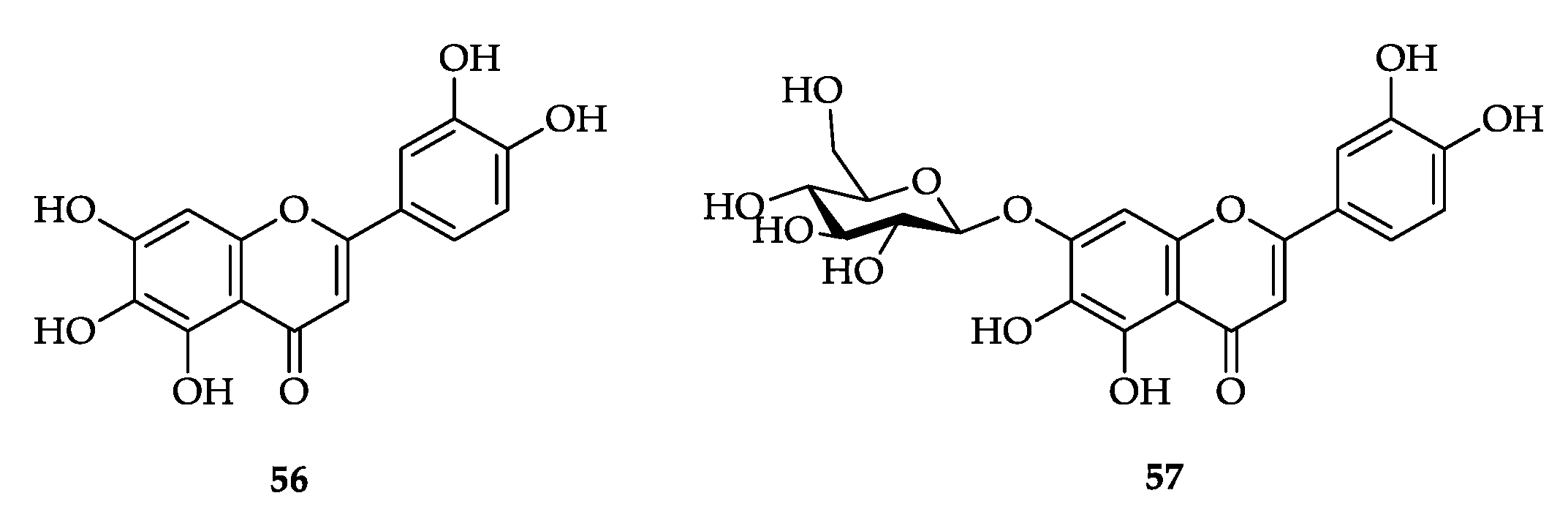
Capitula of Eriocaulon ligulatum were powdered and macerated with n-hexane, methylene chloride, and MeOH. Methanolic extract was submitted to Sephadex LH-20 column, followed by separation in HPLC using refractive detector. This procedure gave rise to two new (58, 59) and six known (7, 8, 54, 55, 60, 61) flavonoids which were identified by spectroscopic and spectrometric methods [47]. Additionally, 6-methoxyluteolin-7-O-β-D-allopyranoside (58) and 6-methoxyapigenin-7-O-β-D-allopyranoside (59) were isolated from the same part and species by HSCCC using a mixture of two phases composed of ethyl acetate:n-propanol:water (140:8:80), v/v/v. This separation was performed in 3 h and the two flavonoids were identified by NMR and ESI-MS, comparing their spectra with published data [48].
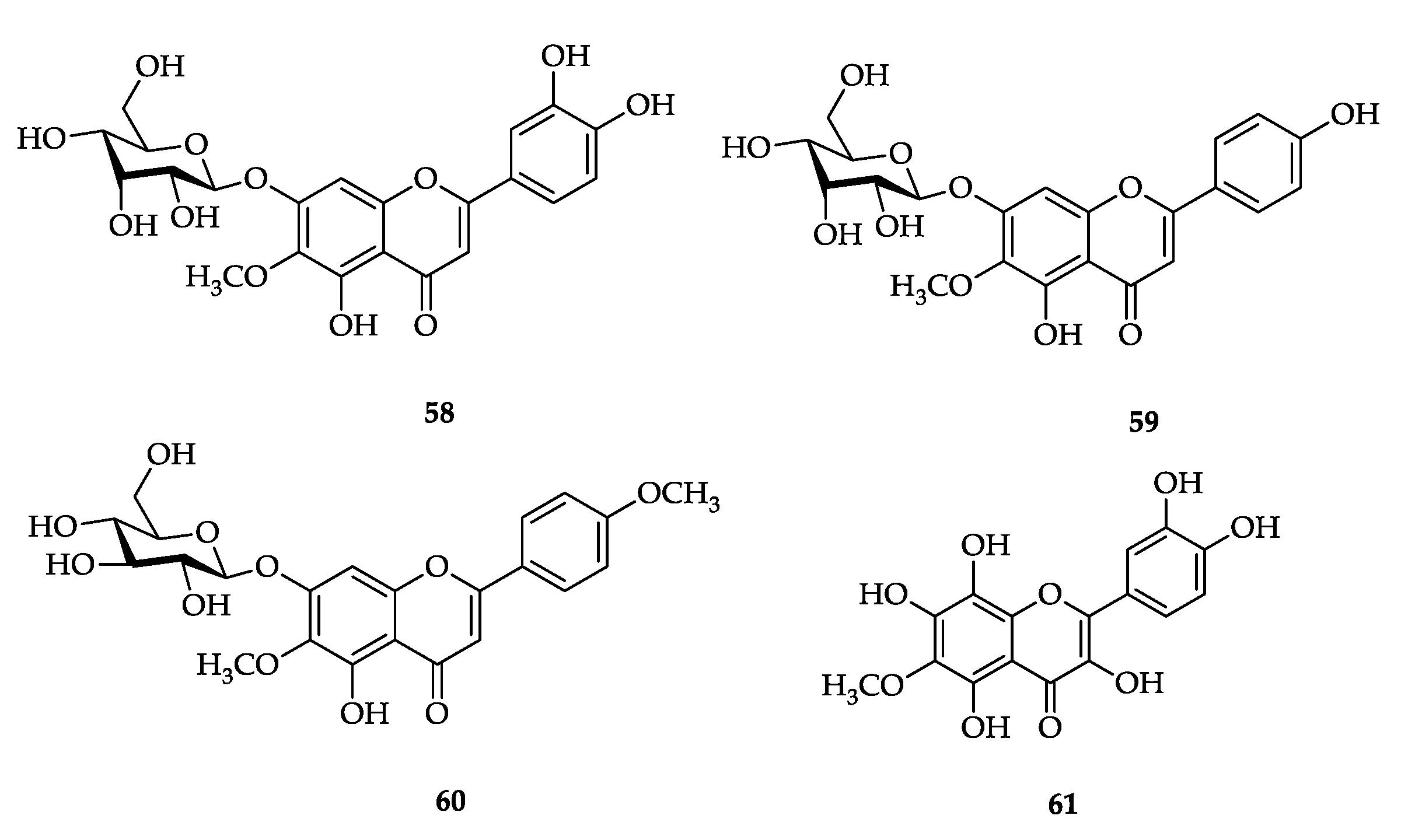
Aerial parts of Syngonanthus bisulcatus were extracted with ethanol and submitted to separation with Sephadex LH-20 and eluted with methanol. Some fractions were purified by different methods of chromatography to separate the flavonoids luteolin (12), 5,6,3′,4′-tetrahydroxy-7-O-β-D-glucopyrade (57), 5-hydroxy-7,4′-dimethoxy-6-C-β-D-glucopyranosylflavone (62), isovitexin (5,7,4′-trihydroxy-6-C-β-D-glucopyranosylflavone, 63), and lutonarin (5,3′,4′-trihydroxy-6-C-7-O-β-D-glucopyranosylflavone, 64). The structure of the compounds was characterized by spectroscopic and spectrometric methods. The ethanol extract was also examined in the ulcer model ethanol/HCl-induced gastric mucosal lesions, showing a significant inhibition of ulcer formation when compared with the control group [49].

The work carried out by Dokkedal et al. (2007) resulted in the isolation of a dihydroflavonol C-glycoside characterized as xeractinol (65) from a methanol extract of the leaves of Paepalanthus argenteus var. argenteus. Xeractinol was isolated after eluting from a Sephadex LH-20 column with MeOH and showed a yellow spot on TLC under UV light [50].
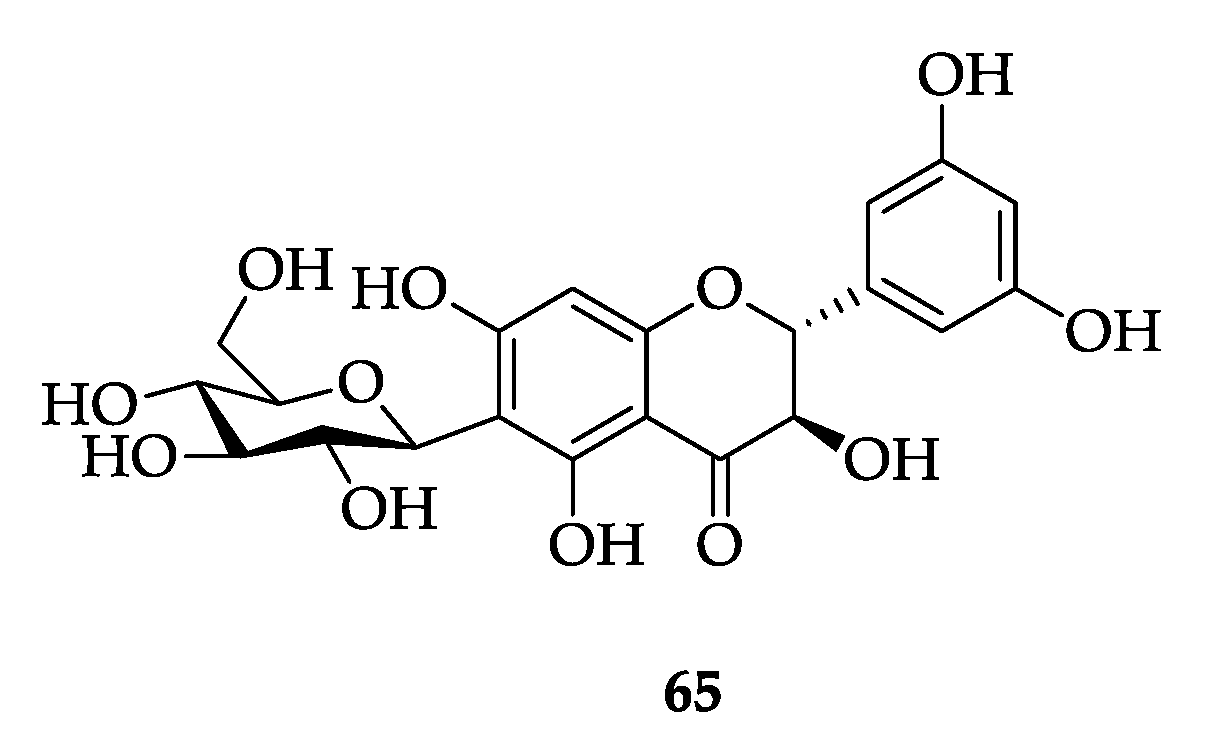
The n-butanol fraction from Eriocaulon ligulatum capitula was fractionated on a HSCCC apparatus with four gradients. This procedure gave two known flavonoids, 6-methoxyapigenin-7-O-β-D-glucopyranoside (55) and 6-methoxyapigenin-7-O-β-D-allopyranoside (59), and the new acylated flavonoid, 6,4′-dimethoxyquercetin-3-O-β-D-6″[3″′,4″′,5″′-trihydroxy-(E)-cinnamoyl]-glucopyranoside (66). Compounds were characterized by spectroscopic and spectrometric methods. The mutagenic effect of the n-BuOH extract was evaluated and showed mutagenic activity in the Salmonella/microsome assay, in TA100, TA97a, and TA102 strains, and for dichloromethane extract tested in TA98 strain [51].
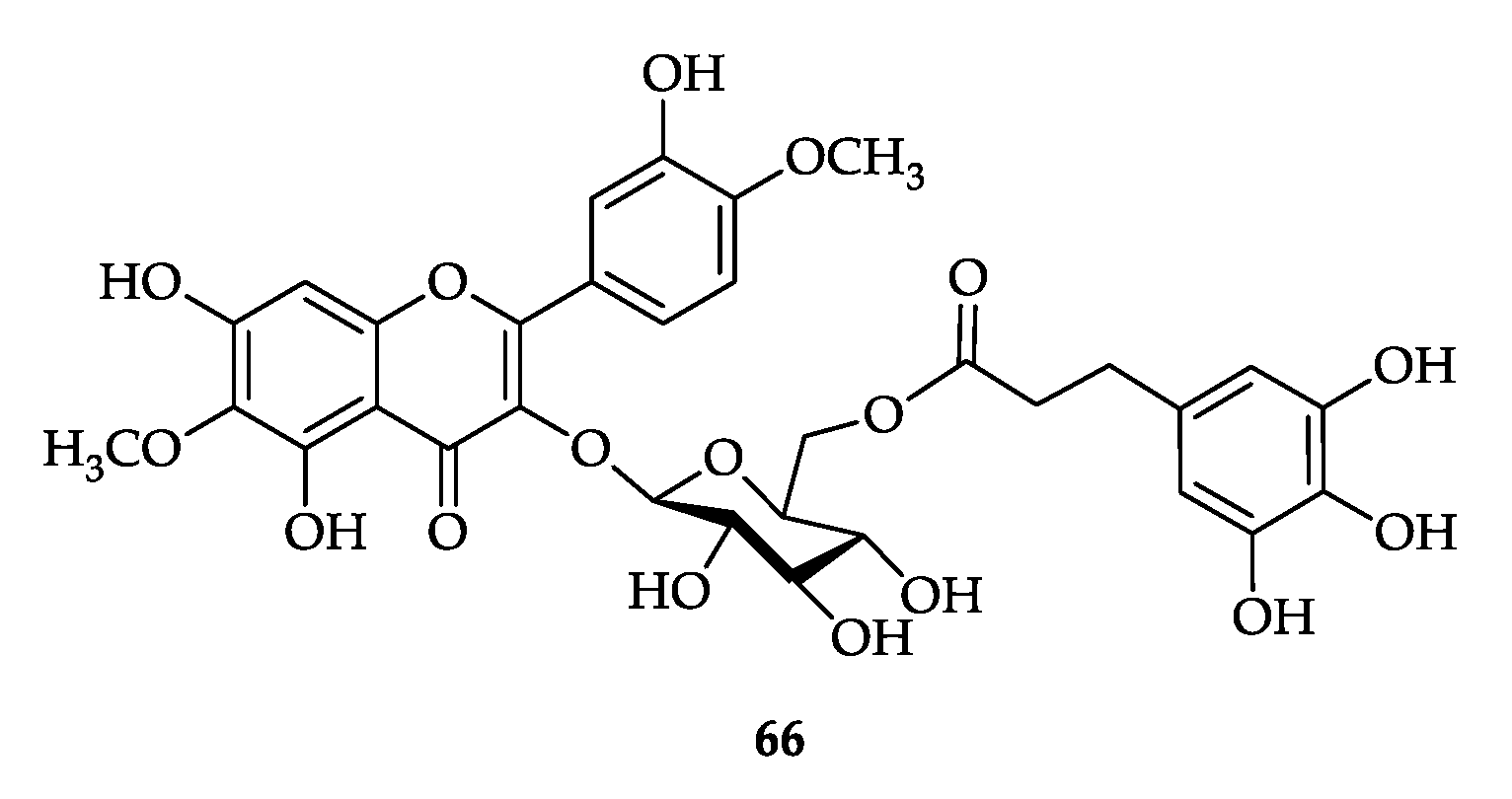
Bosqueiro (2000), studying the chemistry of Paepalanthus spp. from different taxa, observed that chemical profiles are very distinct. Three flavonoids, 2, 7, and 32, were isolated in Paepalanthus chlorocephalus. Flavonoids 2, 41, and 4 were isolated in P. argenteus; 28, 30, 32, and 69 in P. macrocephalus; 34–36, 40, 67, and 68 in P. vellozioides and P. latipes; 27, 29, 30, 32, and 33 in P. denudatus [22,52]. According to Dokkedal et al. (2008), 6,3′-dimethoxyquercetin-7-O-β-D-glucopyranoside (69) was also isolated in P. bromelioides, and apigenin-6-C-8-C-glucopyranoside (70) was also isolated in P. planifolius [22].
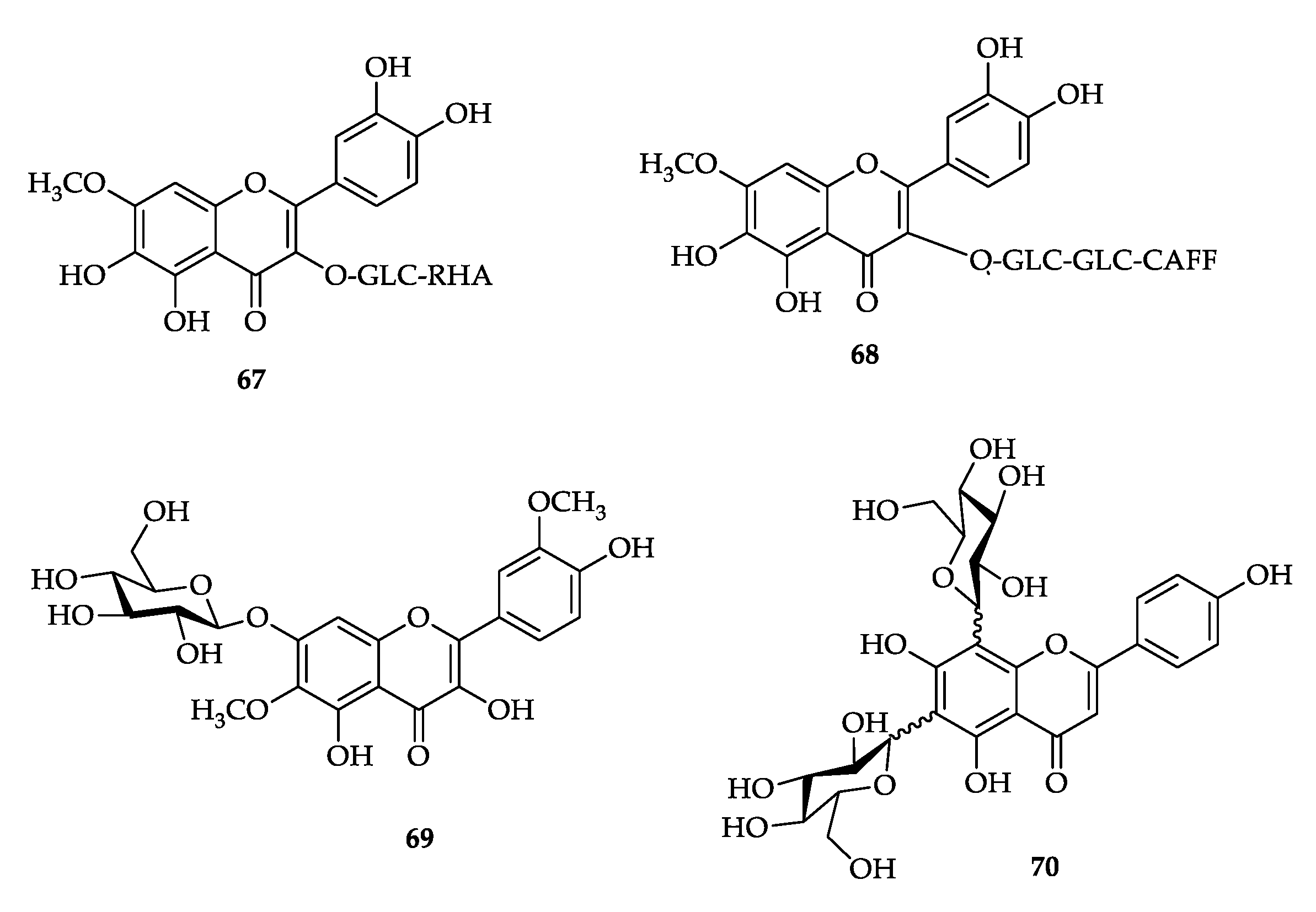
The whole plant of Eriocaulon buergerianum was extracted with 95% EtOH and fractionated with petroleum ether, EtOAc, and n-BuOH. All extracts were purified using different chromatographic methods. The EtOAc extract contained the compounds 2, 30, 46, 50, 54, 55, 71, 72, and 75 and n-BuOH extract contained 40, 50, and 73. Antibacterial assays were performed to all isolated compounds, using the standard Staphylococcus aureus strain (ATCC 25923). As a result, ten compounds exhibited antibacterial activity with minimum inhibitory concentrations (MICs) ranging from 32 to 256 µg mL−1 [53]. Additionally, patuletin (2) and hispidulin (54) were evaluated for inhibitory activities on fatty acid synthase, showing significant activity [54].
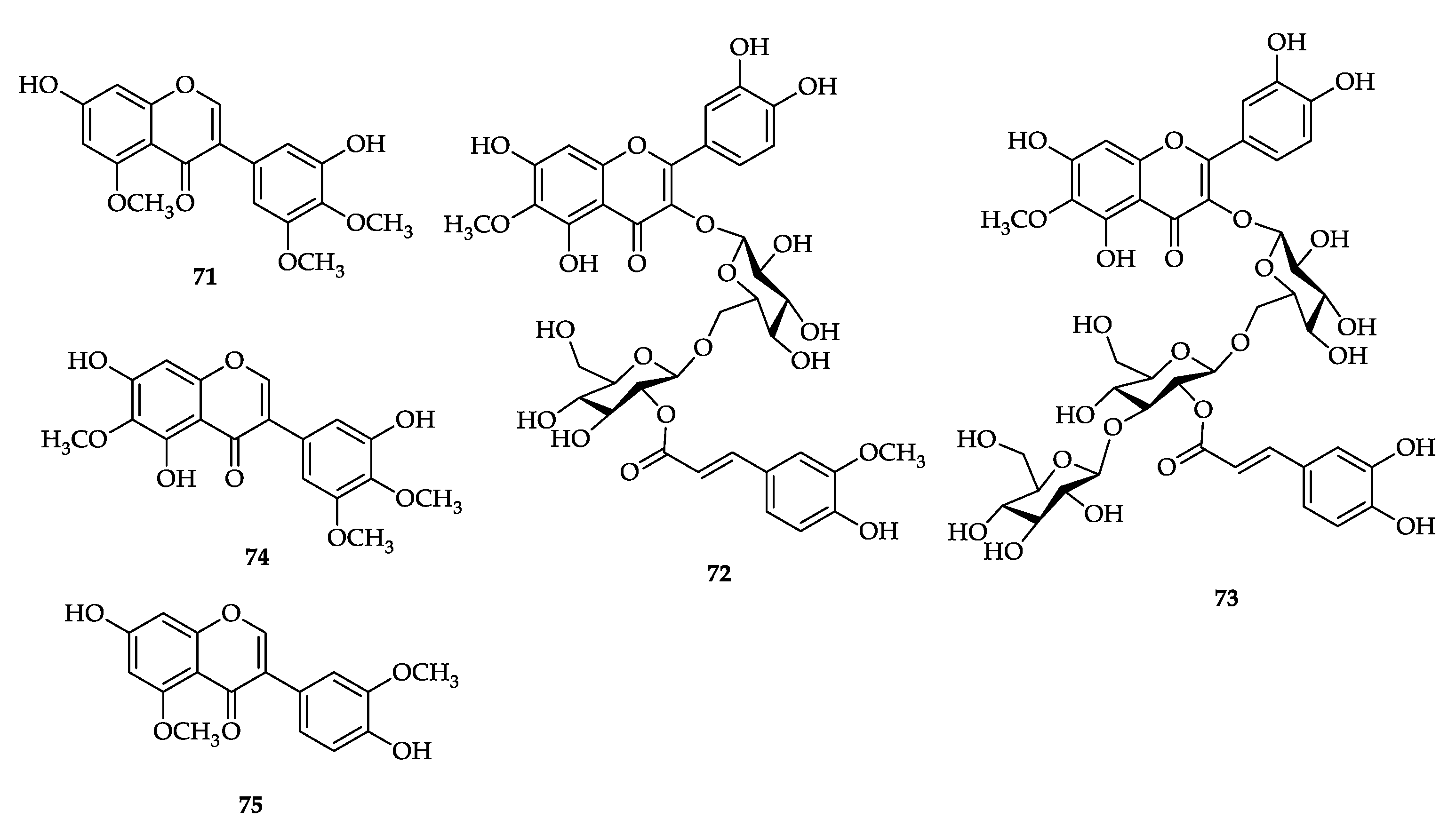
Methanol extract of Eriocaulon ligulatum capitula was submitted to liquid chromatography-electrospray ionization multistage ion trap mass spectrometry (LC-ESI-IT-MSn). As a result, the authors identified 3, 10, 12, 54, 59, and 76–81 based on their fragmentation patterns in MS experiments and on NMR analysis for isolated compounds [55].

The compounds 6-methoxyapigenin (10), 6-methoxyapigenin-7-O-β-D-glucopyranoside (17), and rutin (82) were quantified by using high performance liquid chromatography with DAD detection in methanolic extracts of capitula of Syngonanthus suberosus, S. dealbatus, Eriocaulon ligulatum, and capitula and leaves of Leiothix spiralis, in time intervals of less than 7 min. The identification was made by comparing the retention times with those of standards, by adding standard solutions to the samples analyzed by HPLC, and by comparing their UV-Vis spectrum. All extracts were tested against six strains of microorganism, inhibiting the growth of all the tested microorganisms [56].
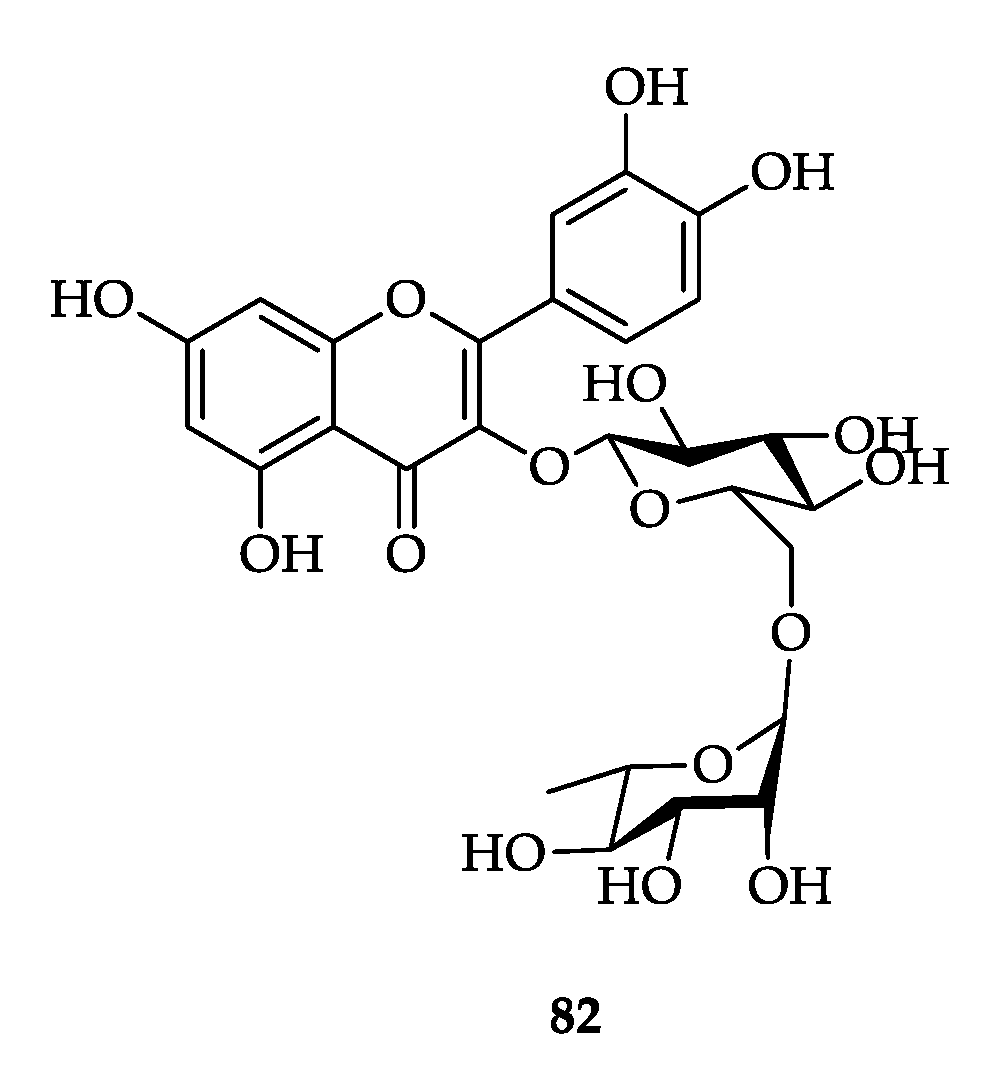
An analytical study was carried out with scapes and flowers of Syngonanthus nintens to define the metabolite fingerprint by HPLC-ESI-MSn. Additionally, the methanolic extracted of both scapes and flowers were filtered and fractionated on a Sephadex LH-20 column, using MeOH as mobile phase. Other separation procedures were performed to isolate 12, 45, 47, 56, and 83–90 from scapes. The structures of all compounds were elucidated by NMR spectroscopic data [57]. The in vitro antioxidant properties of the S. nintens methanolic extract were evaluated by electron paramagnetic resonance (EPR) spectroscopy based on their ability to scavenge the DPPH radical. The kinetics of reaction between DPPH and S. nintens was determined. Luteolin (12) and isoorientin (47) were also used to investigate kinetics of reaction between DPPH and flavonoids. As a result, S. nitens showed a high antioxidant capacity the authors attributed to the presence of flavonoids, and 47 presented an antioxidant activity 40% higher than 12 [58].
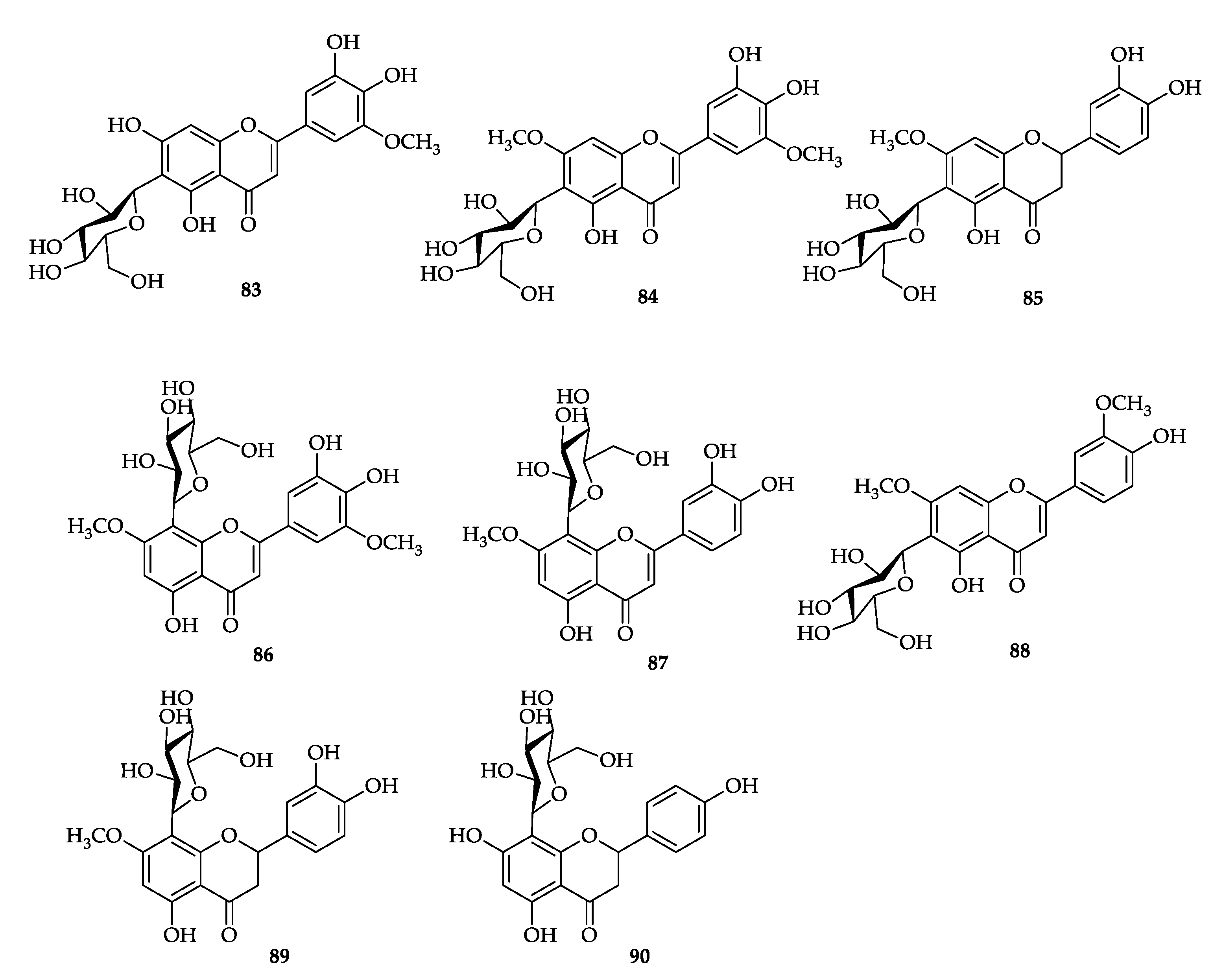
An ethanolic extract from scapes of Syngonanthus macrolepis yielded a flavonoid-rich fraction after going through a Sephadex LH-20 chromatographic column, containing luteolin (12), 7-methoxyluteolin-6-C-β-D-glucopyranoside (45), luteolin-6-C-β-D-glucopyranoside (47), 6-hydroxyluteolin (56), and 7,3′-dimethoxyluteolin-6-C-β-D-glucopyranoside (88) identified after HPLC purification. A flavonoid-rich fraction was investigated for preventing gastric ulceration in mice and rats, showing a significant reduction in gastric injury in all models tested, without altering gastric juice parameters after pylorus ligation [59].
A methanolic extract of Leiothrix spiralis leaves was chromatographed on a Sephadex LH-20 column with MeOH as eluent. After separation of three fractions by medium pressure liquid chromatography (MPLC), five flavonoids (44, 45, 47, 87, and 91) were found. Minimum inhibitory concentration (MIC) analysis revealed antibacterial and/or antifungal activity for all compounds [60].
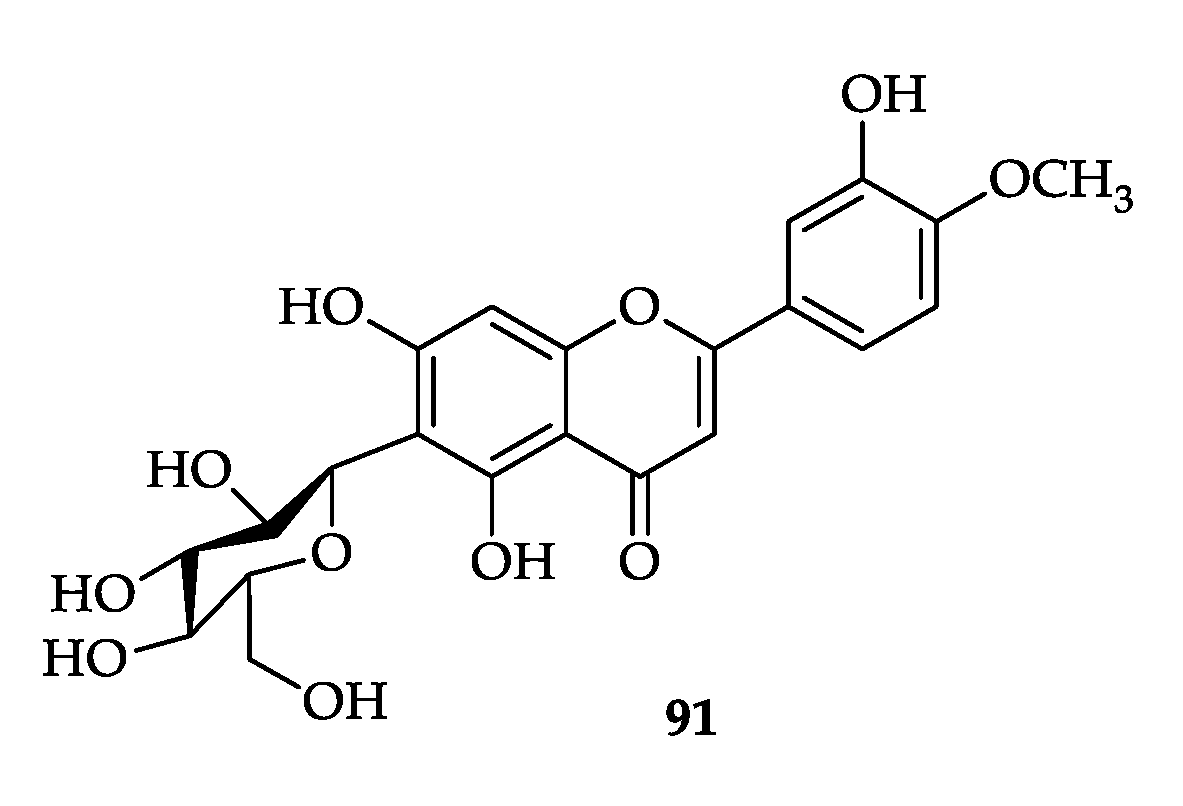
A study carried out with Paepalanthus geniculatus Kunth. flowers resulted in several metabolites of different classes, identifying 16 flavonoids. Most of them were derived from quercetagetin (67, 96–98) and galetine (92–94, 100). Other metabolites such as 28, 30, 33, 67, 99, and 100 and a truxilate metabolite (101), which is a glucoside cyclodimer, were also isolated. Furthermore, 31, 95, and 97 showed significant antioxidant activity [61]. Previous and subsequent works reported the isolation of 6-methoxykaempferol-3-O-glucopyranoside (33) in capitula of Paepalanthus bromeloides and P. macropodus [38,43].
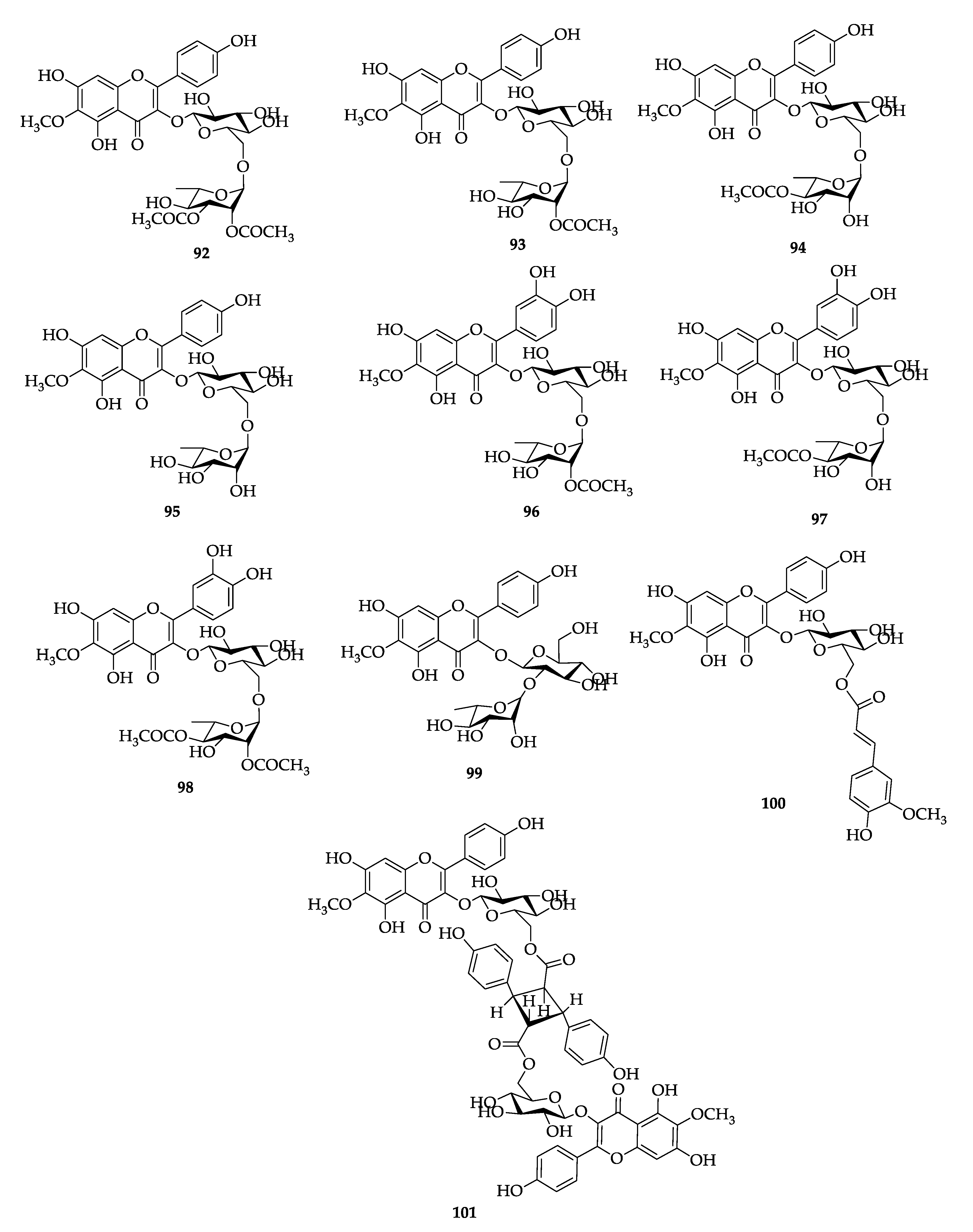
A methanolic extract of Eriocaulon australe R. Br. capitula was partitioned with EtOAc and submitted to silica gel column chromatography using increasing MeOH in CHCl3 (0–40%, v/v) to give four fractions. Those fractions were submitted to different types of separation resulting in the compounds 17, 41, 46, 53–55, and 102–109. The in vitro cytotoxicity of the compounds was evaluated using the MTT colorimetric assay. Compounds 41, 54, and 102 were cytotoxic to A549; 41, 54, 102–104, and 106 to MCF-7; and 54, 41, and 103 to HeLa cells [62].
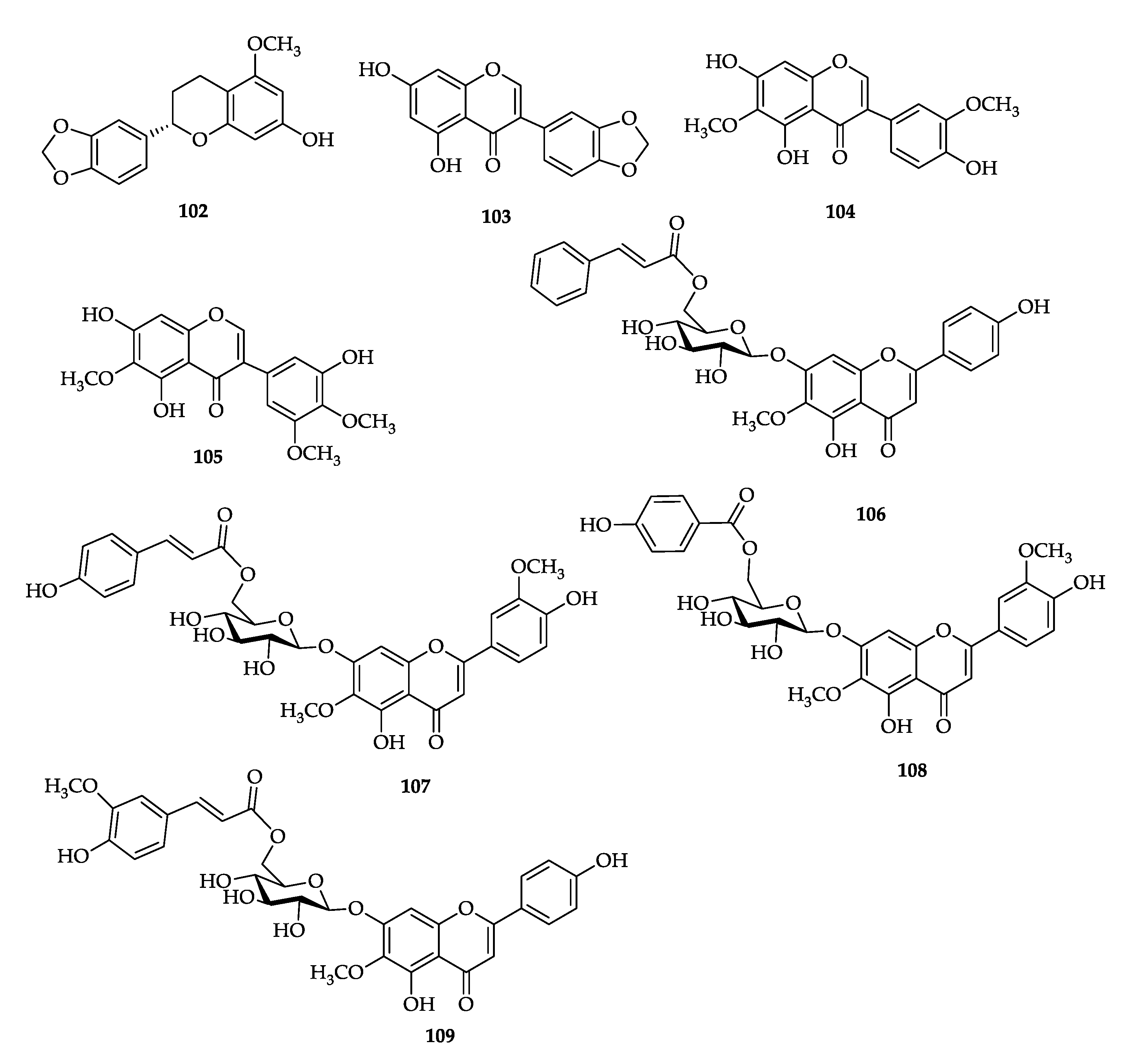
Methanolic extracts of capitula and scapes of Syngonanthus dealbatus, S. macrolepsis, S. nitens, and S. suberosus were separated with Sephadex LH-20. Fractions of scapes column were also separated in HSCCC. Compounds 45 and 87 were purified by HPLC-UV and 12, 56, and 88 by HPLC-RID. The mutagenicity of extracts and isolated compounds were evaluated, but none of them showed activity. All isolated flavones could also be used as new antimutagenic agents [63].
Methanolic extracts from powdered capitula and scapes of Paepalanthus chiquitensis Herzog were fractioned in Sephadex LH-20 using MeOH as eluent. A fraction from a mentioned procedure of capitula yielded the pure compound 28. A fraction from scapes was separated by semi-preparative HPLC-IR yielding the new compound, 113. Compound 120 was also isolated from both capitula and scapes. Other compounds such as 28, 76, and 114 were identified by HPLC-ESI-MSn using external standard and compounds 80, 110–112, and 115–119 according to m/z and literature. A Salmonella/microsome biological assay was performed with methanolic extracts, resulting in mutagenic activity against the TA97a strain [64].

The hydroethanolic extract of the aerial parts from Tonina fluviatilis was submitted to different methods of separation to yield 6-methoxyquercetin-3-O-β-D-glucopyranoside (30), 6-hydroxy-7-methoxyquercetin-3-O-β-D-glucopyranoside (35), and 6,7-dimethoxyquercetin-3-O-β-D-glucopyranoside (121). After obtaining the compounds and elucidating their structures, they were quantified in the extracts by using HPLC-DAD. The radical scavenging activity was also performed to extract and isolate compounds, showing a better result for compounds 30 and 35 [1].

Methanolic extract of the Paepalanthus acanthophyllus capitula was fractionated by HPLC-PDA semipreparative, allowing the isolation of 6-methoxykaempferol-3-O-β-D-glucopyranoside (33), 6-methoxykaempferol-3-O-(6”-p-coumaroyl)-β-D-glucopyranosyl-7-O-β-D-glucopyranoside (122), and 6-methoxykaempferol-3-7-di-O-β-D-glucopyranoside (123) [65].

The hydroethanolic extract of Eriocaulon buergerianum Koern. was partitioned with EtOAc, BuOH, and H2O. After repeated and different chromatographic methods, the EtOAc fraction yielded compounds 10, 41, and 54; the BuOH fraction compounds 17, 46, 53, 55, and 124; and the H2O fraction compounds 53 and 124 [66].
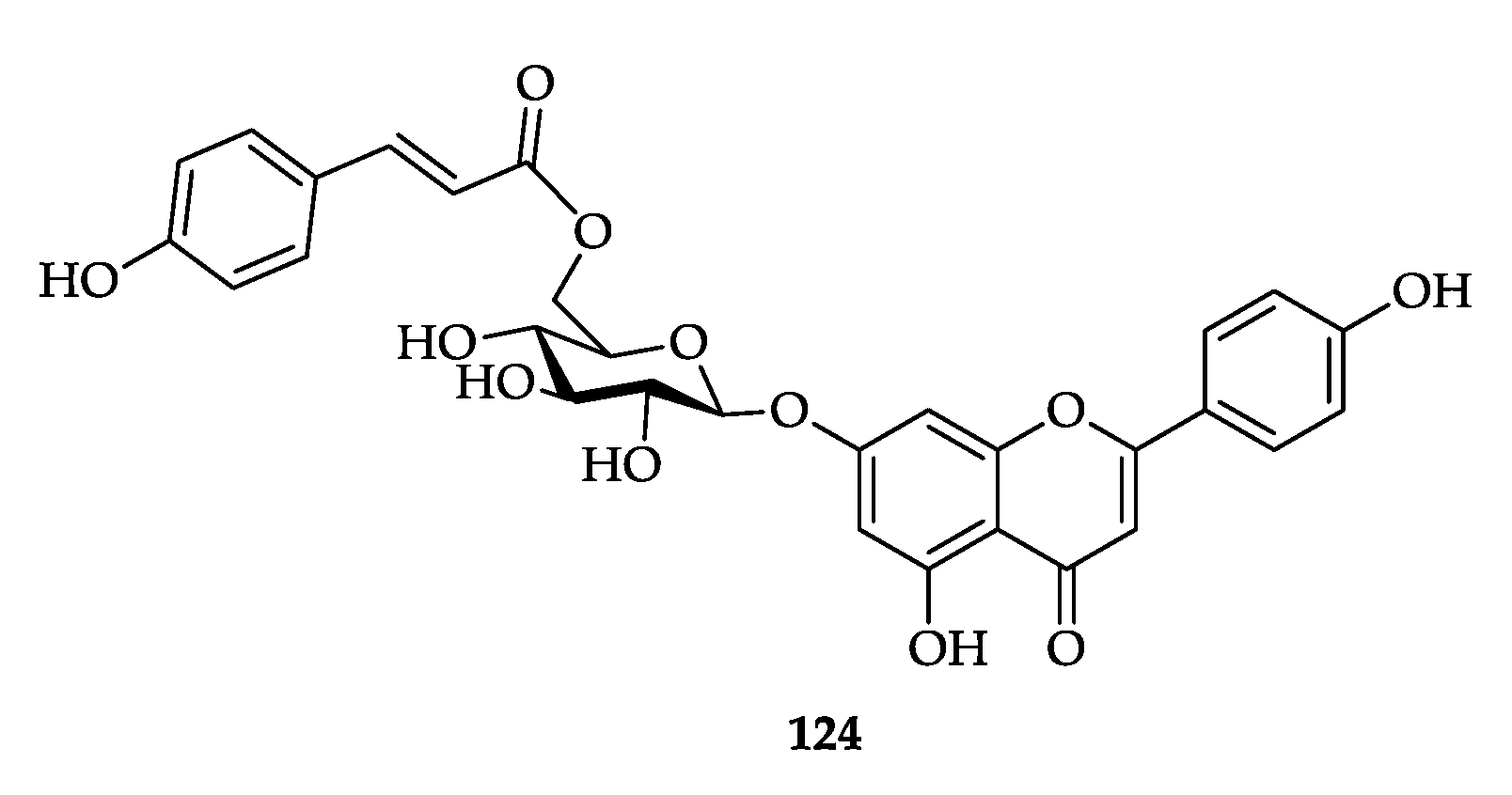
Qiao et al. (2012), studying the chemical constituents of a Chinese herbal medicine Gu-Jing-Cao (Eriocaulon buergerianum) to identify—by high-performance liquid chromatography with diode array detection and electrospray ionization tandem mass spectrometry (HPLC-DAD-ESI-MSn)—adulterating species, identified, in Eriocaulon sexangulare, the flavonoids 30, 54, 55, 104, 126, and 129; in E. buergerianum, the flavonoids 2, 30, 31, 54, 55, 71, 73, 104, 105, 125, and 129; in E. cinereum, the flavonoids 2, 30, 31, 54, 55, 71, 73, 104, 105, 111, 125, 127, 129, and 130; in E. faberi, the flavonoids 2, 30, 31, 54, 55, 71, 73, 104, 105, 125, and 130. The authors did not show in what species compound 128 was isolated. Besides the mentioned compounds, other compounds not completely elucidated were found [67].
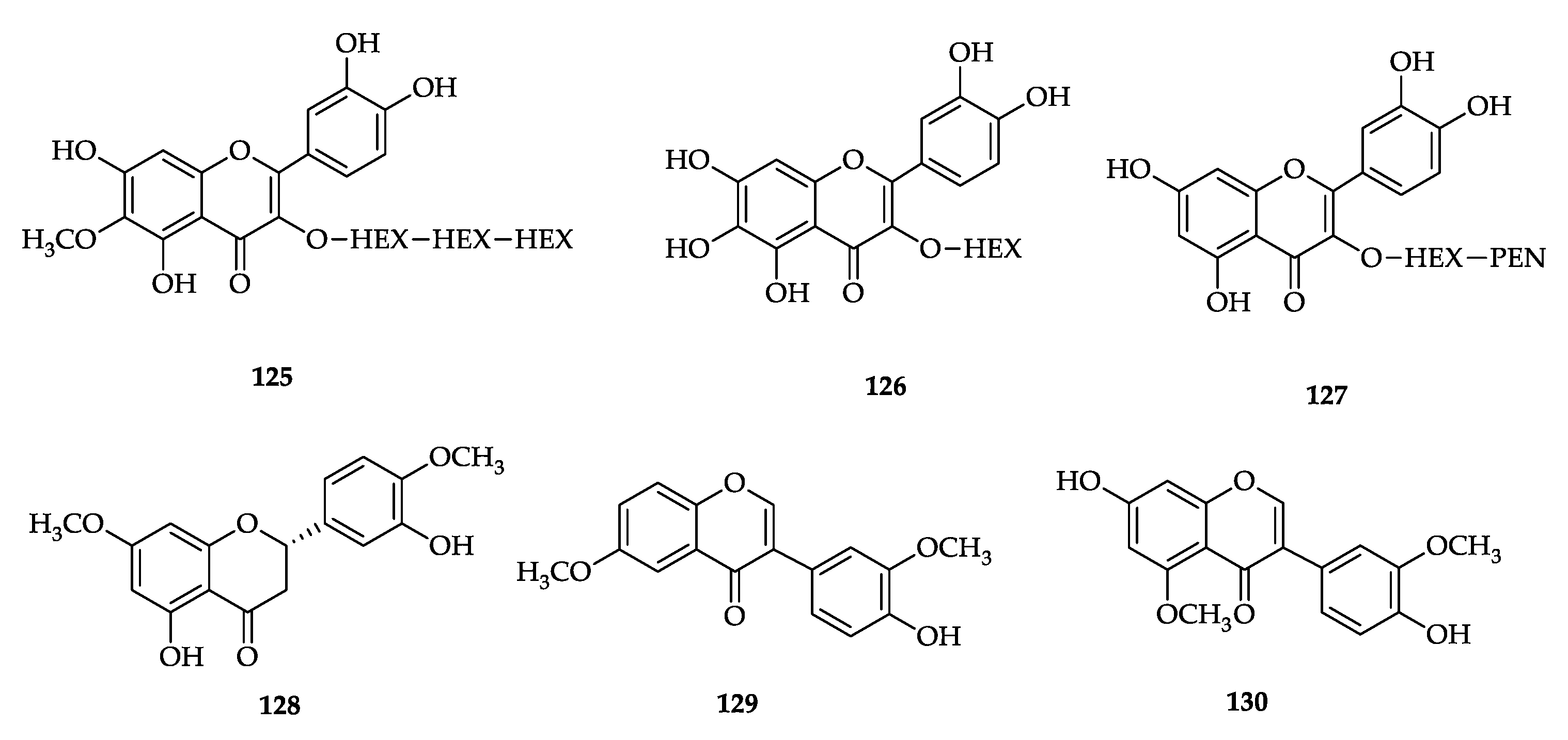
In summary, one hundred and thirty compounds were isolated from one species of Tonina, six species of Leiothrix, twelve species of Eriocaulon, nineteen species of Syngonanthus, and twenty species of Paepalanthus, being thirty-two aglycones and ninety-eight glycones.
Several subclasses of flavonoids have been isolated, such as flavones, flavonols, flavanols, flavanonols, flavanone, and isoflavones, more specifically, derivatives of apigenin, luteolin, quercetin, kaempferol, genistein, and others.
Regarding substituents, 6-methoxylated flavonoids are very common (45.9%), but the substitution at the positions C-3 (2.4%), C-5 (4.1%), C-7 (19.7%), C-3′ (11.5%), C-4′ (10.7%), and C-5′ (5.7%) also occur. Besides this, in this study, we can observe the presence of six specific kinds of sugar, such as glucose (Glu), rhamnose (Rha), xylose (Xyl), allose, arabinose (Ara), galactose (Gal), and its combinations, forming disaccharides. However, the glycones with glucose are the most common, especially at C-3 and C-7 positions, but also found at C-6, C-8, and C-4′. Glucoside substituents such as caffeoyl, coumaroyl, feruloyl, and acetyl were also found.
Table 1 shows the names of flavonoids, the part of the plant where they were isolated, species, and authors.

Table 1.
Flavonoids isolated from Eriocaulaceae species.
Table 1.
Flavonoids isolated from Eriocaulaceae species.
| Compounds | MF | [M-H]− | Organ | Species | Reference |
|---|---|---|---|---|---|
| Quercetagetin (1) | C15H10O8 | 317 | Leaves | Eriocaulon septangulare | [29] |
| Leaves | E. brownianum | [29] | |||
| - | E. nilagirense | [29] | |||
| Leaves | E. decangulare | [29] | |||
| Leaves | E. sexangulare | [29] | |||
| Leaves | E. wightianum | [29] | |||
| Capitula | Paepalanthus polyanthus P. robustus P. ramosus | [35] | |||
| - | P. ramosus | [22] | |||
| Patuletin (2) | C16H12O8 | 331 | Leaves | E. brownianum | [29] |
| Leaves | E. truncatum | [29] | |||
| Capitula | P. planifolius | [32] | |||
| Capitula | P. polyanthus | [35] | |||
| Capitula | P. bromelioides P. latipes | [38] | |||
| Capitula | P. chlorocephalus P. argenteus var. argenteus | [52] | |||
| Capitula | P. macrocephalus | [22] | |||
| whole plant | E. buergerianum | [53] | |||
| whole plant | E. buergerianum | [30] | |||
| Capitula/ seeds | E. buergerianum E. cinereum E. faberi | [67] | |||
| - | P. macropodus | [22] | |||
| Quercetin (3) | C15H10O7 | 301 | Leaves | E. brownianum | [29] |
| Capitula | E. ligulatum | [55] | |||
| Aerial part | P. giganteus | [33] | |||
| Luteolin 7-O-glucoside (4) | C21H20O11 | 447 | Leaves | Leiothrix curvifolia var. mucronata | [31] |
| Luteolin 7-O-triglucoside (5) | - | - | Leaves | L. curvifolia L. curvifolia var. mucronata L. plantago L. sclerophylla L. vivípara | [31] |
| Luteolin 7-O-diarabinoside (6) | - | - | Leaves | L. spiralis | [31] |
| Nepetin (7) | C16H12O7 | 315 | Leaves | L. curvifolia var. curvifolia | [31] |
| Capitula | P. chlorocephalus | [52] | |||
| Leaves | P. chlorocephalus | [41] | |||
| Capitula | E. ligulatum | [47] | |||
| Nepetin 7-O-glucoside (8) | C22H22O12 | 477 | Leaves | L. curvifolia var. mucronata | [31] |
| Capitula | E. ligulatum | [47] | |||
| Nepetin 7-O-arabinoside (9) | C21H20O11 | 447 | Leaves | L. curvifolia var. curvifolia | [31] |
| Apigenin (10) | C15H10O5 | 269 | Capitula | P. hilairei | [32] |
| Capitula | L. curvifolia | [40] | |||
| Capitula | L. flavescens | [45] | |||
| Capitula | E. ligulatum | [55] | |||
| Capitula | Syngonanthus suberosus S. dealbatus E. ligulatum L. spiralis | [56] | |||
| Leaves | L. spiralis | [56] | |||
| Aerial part | E. buergerianum | [66] | |||
| Apigenin-4′-O-glucoside (11) | C21H20O10 | 431 | Capitula | P. hilairei | [32] |
| Luteolin (12) | C15H10O6 | 285 | Capitula | P. planifolius | [32] |
| Capitula | L. curvifolia | [40] | |||
| Aereal parts | S. bisulcatus | [49] | |||
| Capitula | L. flavescens | [45] | |||
| Capitula | E. ligulatum | [55] | |||
| Scapes | S. nintens | [57] | |||
| Scapes | S. macrolepis | [59] | |||
| Aerial part | S. nitens | [33] | |||
| Scapes | Syngonanthus spp. | [63] | |||
| 3-methoxyquercetin (13) | C16H12O7 | 315 | Capitula | P. bifrons | [32] |
| 3-methoxyquercetagetin (14) | C16H12O8 | 331 | Capitula | P. planifolius | [32] |
| Capitula | P. robustus | [32] | |||
| 3-methoxypatuletin (15) | C17H14O8 | 345 | Capitula | P. planifolius | [32] |
| Apigenin-7-O-galactoside (16) | C22H22O9 | 429 | Leaves | S. suberosus | [34] |
| Apigenin-7-O-glucoside (17) | C22H22O9 | 429 | Leaves | S. fuscescens S. eriopus | [34] |
| Capitula | S. suberosus S. dealbatus E. ligulatum L. spiralis | [56] | |||
| Leaves | L. spiralis | [56] | |||
| Capitula | E. australe | [62] | |||
| Aerial part | E. buergerianum | [66] | |||
| Luteolin-7-O-arabinoside (18) | C20H18O10 | 417 | Leaves | S. laricifolius S. nitens | [34] |
| Luteolin-7-O-galactoside (19) | C21H20O11 | 447 | Leaves | S. verticillatus S. elegans S. eriopus S. brasiliana S. xaranthemoides | [34] |
| Luteolin-7-O-xyloside (20) | C20H18O10 | 417 | Leaves | S. aff. mucugensis S. xaranthemoides | [34] |
| Luteolin-7-O-digalactoside (21) | - | - | Leaves | S. elegans S. elegantulus S. eriopus S. xaranthemoides | [34] |
| Luteolin-7-O-diglucoside (22) | - | - | Leaves | S. anthemidiflorus S. arenarius S. niveus S. suberosus S. brasiliana S. xaranthemoides | [34] |
| 6-hydroxyluteolin-7-O-galactoside (23) | C21H20O12 | 463 | Leaves | S. verticillatus | [34] |
| 6-hydroxyluteolin-7-O-diarabinoside (24) | - | - | Leaves | S. arenariusS. gracilisS. laricifolius | [34] |
| 6-hydroxyluteolin-7-O-digalactoside (25) | - | - | Leaves | S. verticillatus S. macrolepis S. nitens | [34] |
| 6-hydroxyluteolin-7-O-diglucoside (26) | - | - | Leaves | S. anthemidiflorus S. fuscescens S. helminthorryzus S. nitens | [34] |
| 6-methoxyquercetin-3-O-β-D-6′’-(p-coumaroyl)-glucopyranoside (27) | C31H28O15 | 639 | Capitula | P. polyanthus P. robustus P. denudatus | [35] |
| Capitula | P. denudatus | [52] | |||
| 6-methoxykaempferol-3-O-β-D-6′’-(p-coumaroyl)-glucopyranoside (28) | C31H28O14 | 623 | Capitula | P. hilairei P. robustus P. ramosus P. denudatus | [35] |
| Capitula | P. ramosus | [39] | |||
| Capitula | P. macrocephalus | [52] | |||
| Flowers | P. geniculatus | [61] | |||
| Capitula | P. chiquitensis | [64] | |||
| Quercetagetin-7-O-glucopyranoside (29) | C21H20O13 | 479 | Capitula | P. polyanthus P. hilairei P. ramosus | [35] |
| Capitula | P. bromelioides | [38] | |||
| Capitula | P. denudatus | [52] | |||
| Patuletin-3-O-glucopyranoside (30) | C22H22O13 | 493 | Capitula | P. polyanthus P. robustus | [35] |
| Capitula | P. macrocephalus P. denudatus | [52] | |||
| Aerial parts | P. polyanthus | [42] | |||
| Capitula | P. macropodus | [43] | |||
| whole plant | E. buergerianum | [53] | |||
| Flowers | P. geniculatus | [61] | |||
| Aerial parts | Tonina fluviatilis | [1] | |||
| Capitula/seeds | E. sexangulare E. buergerianum E. cinereum E. faberi | [67] | |||
| - | P. brachypy | [22] | |||
| Patuletin-3-O-rutinoside (31) | C28H32O17 | 639 | Capitula | P. polyanthus P. hilairei | [35] |
| Aerial parts | P. polyanthus | [42] | |||
| Capitula/seeds | E. buergerianum E. cinereum E. faberi | [67] | |||
| 6-methoxykaempferol (32) | C16H12O7 | 315 | Capitula | P. hilairei P. ramosus P. denudatus | [35] |
| Capitula | P. hilairei P. vellozioides | [38] | |||
| Capitula | P. chlorocephalus P. macrocephalus P. denudatus | [52] | |||
| - | P. brachypy P. vellozioides P. latipes | [22] | |||
| - | P. macropodus | [22] | |||
| 6-methoxykaempferol-3-O-glucopyranoside (33) | C22H22O12 | 477 | Capitula | P. hilairei P. robustus P. ramosus P. denudatus | [35] |
| Capitula | P. hilairei P. bromelioides | [38] | |||
| Capitula | P. ramosus | [39] | |||
| Capitula | P. denudatus | [52] | |||
| Flowers | P. geniculatus | [61] | |||
| Capitula | P. acanthophyllus | [65] | |||
| - | P. vellozioides P. latipes P. planifolius | [22] | |||
| 7-methoxyquercetagetin (34) | C16H12O8 | 331 | Leaves | P. latipes P. vellozioides | [24] |
| - | P. bromelioides | [22] | |||
| Scapes | P. latipes | [36] | |||
| Leaves | P. vellozioides P. latipes | [52] | |||
| 7-methoxyquercetagetin-3-O-β-D-glucopyranoside (35) | C22H22O13 | 493 | Leaves | P. latipes P. vellozioides | [24] |
| Leaves | P. vellozioides P. latipes | [52] | |||
| Aerial parts | T. fluviatilis | [1] | |||
| - | P. planifolius | [22] | |||
| 7-methoxyquercetagetin-4′-O-β-D-glucopyranoside (36) | C22H22O13 | 493 | Leaves | P. latipes | [24] |
| Leaves | P. vellozioides P. latipes | [52] | |||
| Scapes | P. latipes | [36] | |||
| 7-methoxyquercetagetin-3-O-cellobioside (37) | C28H32O18 | 655 | Leaves | P. latipes P. vellozioides | [24] |
| 7-methoxyquercetagetin-3-O-neohesperidoside (38) | C28H32O17 | 639 | Leaves | P. vellozioides | [24] |
| Aerial parts | P. polyanthus | [42] | |||
| 7-methoxyquercetagetin-3-O-[2-O-caffeoyl-β-D-glucopyranosyl-(1-2)-O-β-D-glucuronopyranoside (39) | C37H36O22 | 831 | Leaves | P. latipes | [24] |
| Patuletin-3-O-β-D-rutinoside (40) | C28H32O17 | 639 | Capitula | P. hilairei | [38] |
| Leaves | P. vellozioides P. latipes | [52] | |||
| whole plant | E. buergerianum | [53] | |||
| 5,7,4′-trihydroxy-6,3′-dimethoxyflavone (41) | C17H14O7 | 329 | Capitula | P. bromelioides | [38] |
| Capitula | P. argenteus var. argenteus | [52] | |||
| Leaves | P. argenteus var. argenteus | [41] | |||
| Capitula | E. australe | [62] | |||
| Aerial part | E. buergerianum | [66] | |||
| - | L. curvifolia | [22] | |||
| 5,7,4′-trihydroxy-6,3′-dimethoxyflavonol (42) | C17H14O8 | 345 | Capitula | P. bromelioides | [38] |
| 5,3′-dihydroxy-7-4′,5′-trimethoxyisoflavone (43) | C18H16O7 | 343 | Capitula | L. curvifolia | [40] |
| 3′,4′,5,6-tetrahydroxy-7-methoxyflavone (44) | C16H12O7 | 315 | Capitula | L. flavescens | [40] |
| Leaves | L. spiralis | [60] | |||
| 3′,4′,5-trihydroxy-7-methoxy-6-C-glucopyranosylflavone (45) | C22H22O11 | 461 | Capitula | L. flavescens | [40] |
| Scapes | S. nintens | [57] | |||
| Leaves | L. spiralis | [60] | |||
| Scapes | S. macrolepis | [59] | |||
| Scapes | Syngonanthus spp. | [63] | |||
| Aerial part | E. buergerianum | [66] | |||
| 4′,5-dihydroxy-3′,6-dimethoxy-7-O-β-D-glucopyranosylflavone (46) | C23H24O11 | 475 | Capitula | L. flavescens | [40] |
| Capitula | P. argenteus var. argenteus | [52] | |||
| Leaves | P. argenteus var. argenteus | [41] | |||
| whole plant | E. buergerianum | [53] | |||
| Capitula | E. australe | [62] | |||
| 3′,4′,5,7-tetrahydroxy-6-C-glucopyranosylflavone (47) | C21H20O11 | 447 | Capitula | L. flavescens | [40] |
| Scapes | S. nintens | [57] | |||
| Leaves | L. spiralis | [60] | |||
| Scapes | S. macrolepis | [59] | |||
| - | S. bisulcatus | [22] | |||
| 3′,4′,5,6,7,8-hexahydroxyflavone (48) | C15H10O8 | 317 | Capitula | L. flavescens | [40] |
| 5,6,7,8,3′,4′-hexahydroxyflavonol (49) | C15H10O9 | 333 | Aerial parts | P. polyanthus | [42] |
| Capitula | P. macropodus | [43] | |||
| 6-methoxyquercetin-3-O-(6′’-E-feruloyl)-β-D-glucopyranoside (50) | C32H30O16 | 669 | Aerial parts | P. polyanthus | [42] |
| whole plant | E. buergerianum | [53] | |||
| 6-methoxyquercetagetin-3-O-β-D-glucopyranosyl-(1→4)-glucopyranoside (51) | C28H32O18 | 655 | Capitula | P. macropodus | [43] |
| (2S)-3′,4′-methylenedioxy-5,7-dimethoxyflavan (52) | C18H18O5 | 313 | Capitula | E. buergerianum | [44] |
| Hispidulin-7-(6-E-p-coumaroyl)-β-D-glucopyranoside (53) | C31H28O13 | 607 | Capitula | E. buergerianum | [44] |
| Capitula | E. australe | [62] | |||
| Aerial part | E. buergerianum | [66] | |||
| Hispidulin (54) | C16H12O6 | 299 | Capitula | E. buergerianum | [44] |
| Capitula | E. ligulatum | [47] | |||
| Capitula | L. flavescens | [45] | |||
| whole plant | E. buergerianum | [53] | |||
| Capitula | E. ligulatum | [55] | |||
| Capitula | E. australe | [62] | |||
| Aerial part | E. buergerianum | [66] | |||
| Capitula/seeds | E. sexangulare E. buergerianum E. cinereum E. faberi | [67] | |||
| Hispidulin 7-O-glucoside (55) | C22H22O11 | 461 | Capitula | E. buergerianum | [44] |
| Capitula | E. ligulatum | [47] | |||
| Capitula | E. ligulatum | [51] | |||
| whole plant | E. buergerianum | [53] | |||
| Capitula | E. australe | [62] | |||
| Aerial part | E. buergerianum | [66] | |||
| Capitula/seeds | E. sexangulare E. buergerianum E. cinereum E. faberi | [67] | |||
| 3′,4′,5,6,7-pentahydroxyflavone (56) | C15H10O7 | 301 | Capitula | P. microphyllus | [46] |
| Scapes | S. nintens | [57] | |||
| Scapes | S. macrolepis | [59] | |||
| Scapes | Syngonanthus spp. | [63] | |||
| - | P. robustus P. planifolius P. flavescens | [22] | |||
| 3′,4′,5,6-tetrahydroxy-7-O-β-D-glucopyranosilflavone (57) | C21H20O12 | 463 | Capitula | P. microphyllus | [46] |
| Aereal parts | S. bisulcatus | [49] | |||
| - | P. planifolius | [22] | |||
| - | P. flavescens | [22] | |||
| 6-methoxyluteolin-7-O-β-D-allopyranoside (58) | C22H22O12 | 477 | Capitula | E. ligulatum | [47] |
| Capitula | E. ligulatum | [48] | |||
| 6-methoxyapigenin-7-O-β-D-allopyranoside (59) | C22H22O11 | 461 | Capitula | E. ligulatum | [47] |
| Capitula | E. ligulatum | [48] | |||
| Capitula | E. ligulatum | [51] | |||
| Capitula | E. ligulatum | [55] | |||
| 6,4′-dimethoxyapigenin-7-O-β-D-glucopyranoside (60) | C23H24O11 | 475 | Capitula | E. ligulatum | [47] |
| 5,7,8,3′,4′-pentahydroxy-6-methoxyquercetin (61) | C16H12O9 | 347 | Capitula | E. ligulatum | [47] |
| 5-hydroxy-7,4′-dimethoxy-6-C-β-D-glucopyranosylflavone (62) | C23H24O10 | 459 | Aereal parts | S. bisulcatus | [49] |
| isovitexin (5,7,4′-trihydroxy-6-C-β-D-glucopyranosylflavone) (63) | C21H20O10 | 431 | Aereal parts | S. bisulcatus | [49] |
| lutonarin (5,3′,4′-trihydroxy-6-C-7-O-β-D-glucopyranosylflavone) (64) | C27H30O16 | 609 | Aereal parts | S. bisulcatus | [49] |
| Xeractinol (65) | C21H22O12 | 465 | Leaves | P. argenteus var. argenteus | [50] |
| 6,4′-dimethoxyquercetin-3-O-β-D-6′’-[3,4,5-trihydroxy(E)-cinnamoyl]- glucopyranoside (66) | C32H32O17 | 687 | Capitula | E. ligulatum | [51] |
| 7-methoxyquercetagetin-3-O-glucopyranosyl-rhamnoside (67) | - | - | Leaves | P. vellozioides P. latipes | [52] |
| Flowers | P. geniculatus | [61] | |||
| 7-methoxyquercetagetin-3-O-[ caffeoyl]-glucopyranosyl-glucopyranoside (68) | - | - | Leaves | P. vellozioides P. latipes | [52] |
| 6,3′-dimethoxyquercetin-7-O-β-D-glucopyranoside (69) | C23H24O13 | 507 | Capitula | P. macrocephalus | [52] |
| - | P. bromelioides | [22] | |||
| Apigenin-6-C-8-C-glucopyranoside (70) | C27H30O15 | 593 | - | P. planifolius | [22] |
| 7,3′-dihydroxy-5,4′,5′-trimethoxyisoflavone (71) | C18H16O7 | 343 | whole plant | E. buergerianum | [53] |
| Capitula/seeds | E. buergerianum E. cinereum E. faberi | [67] | |||
| Patuletin-3-O-[2-O-E-feruloyl-β-D-glucopyranosyl-(1→6)-β-D-glucopyranoside] (72) | C38H40O21 | 831 | whole plant | E. buergerianum | [53] |
| Patuletin-3-O-[β-D-glucopyranosyl-(1→6)-2-O-E-caffeoyl-β-D-glucopyranosyl-(1→6)-β-D-glucopyranoside] (73) | C43H48O26 | 979 | whole plant | E. buergerianum | [53] |
| Capitula/seeds | E. buergerianum E. cinereum E. faberi | [67] | |||
| 5,7,3′-trihydroxy-6,4′,5′-trimethoxyisoflavone (74) | C18H16O7 | 343 | whole plant | E. buergerianum | [53] |
| Gerontoisoflavone A (75) | C16H12O6 | 299 | whole plant | E. buergerianum | [53] |
| 6-methoxyquercetin-7-O-β-D-glucopyranosyl-(1→6)-β-D-glucopyranoside (76) | C28H32O18 | 655 | Capitula | E. ligulatum | [55] |
| Capitula | P. chiquitensis | [64] | |||
| 6-methoxyluteolin-7-O-β-D-glucopyranosyl-(1→6)-β-D-glucopyranoside (77) | C28H32O17 | 639 | Capitula | E. ligulatum | [55] |
| 6-methoxyquercetin-7-O-(6”‘-vanilloyl)-β-D-glucopyranosyl-(1→6)-β-D-glucopyranoside (78) | C35H38O20 | 777 | Capitula | E. ligulatum | [55] |
| 6,4′-dimethoxyquercetin-7-O-β-D-glucopyranosyl-(1→6)-β-D-glucopyranoside (79) | C29H34O18 | 669 | Capitula | E. ligulatum | [55] |
| 6-methoxyquercetin-7-O-β-D-glucopyranoside (80) | C22H22O13 | 493 | Capitula | E. ligulatum | [55] |
| Scapes | P. chiquitensis | [64] | |||
| 6-methoxyquercetin-O-diglycosylrhamnoside (81) | - | - | Capitula | E. ligulatum | [56] |
| Rutin (82) | C27H30O16 | 609 | Capitula | S. suberosus S. dealbatus E. ligulatum L. spiralis | [56] |
| Leaves | L. spiralis | [56] | |||
| 5,7,4′,5′-tetrahydroxy-3′-methoxy-6-C- β-D-glucopyranosylflavone (83) | C22H22O12 | 477 | Scapes | S. nintens | [57] |
| 5,4′,5′-trihydroxy-7,3′-dimethoxy-6-C- β-D-glucopyranosylflavone (84) | C23H24O12 | 491 | Scapes | S. nintens | [57] |
| 3′,4′,5-trihydroxy-7-methoxy-6-C-glucopyranosylflavanone (85) | C22H24O11 | 463 | Scapes | S. nintens | [57] |
| 5,4′,5′-trihydroxy-7,3′-dimethoxy-8-C- β-D-glucopyranosylflavone (86) | C23H24O12 | 491 | Scapes | S. nintens | [57] |
| 3′,4′,5-trihydroxy-7-methoxy-8-C-glucopyranosylflavone (87) | C22H22O11 | 461 | Scapes | S. nintens | [57] |
| Leaves | L. spiralis | [60] | |||
| Scapes | Syngonanthus spp. | [63] | |||
| 4′,5-dihydroxy-3′,7-dimethoxy-6-C-glucopyranosylflavone (88) | C23H24O11 | 475 | Scapes | S. nintens | [57] |
| Scapes | S. macrolepis | [59] | |||
| Scapes | Syngonanthus spp. | [63] | |||
| 3′,4′,5-trihydroxy-7-methoxy-8-C-glucopyranosylflavanone (89) | C22H24O11 | 463 | Scapes | S. nintens | [57] |
| 4′,5,7-trihydroxy-8-C-glucopyranosylflavanone (90) | C21H22O10 | 433 | Scapes | S. nintens | [57] |
| 4′-methoxyluteolin-6-C-β-D-glucopyranoside (91) | C22H22O11 | 461 | Leaves | L. spiralis | [60] |
| 6-methoxykaempferol-3-O-(2,3-di-O-acetyl)-α-L-rhamnopyranosyl-(1→6)-β-D-glucopyranoside (92) | C32H36O18 | 707 | Flowers | P. geniculatus | [61] |
| 6-methoxykaempferol-3-O-(2-O-acetyl)-α-L-rhamnopyranosyl-(1→6)-β-D-glucopyranoside (93) | C30H34O17 | 665 | Flowers | P. geniculatus | [61] |
| 6-methoxykaempferol-3-O-(4-O-acetyl)-α-L-rhamnopyranosyl-(1→6)-β-D-glucopyranoside (94) | C30H34O17 | 665 | Flowers | P. geniculatus | [61] |
| 6-methoxykaempferol-3-O-α-L-rhamnopyranosyl-(1→6)-β-D-glucopyranoside (95) | C28H32O16 | 623 | Flowers | P. geniculatus | [61] |
| 6-methoxyquercetin-3-O-(2-O-acetyl)-α-L-rhamnopyranosyl-(1→6)-β-D-glucopyranoside (96) | C30H34O18 | 681 | Flowers | P. geniculatus | [61] |
| 6-methoxyquercetin-3-O-(4-O-acetyl)-α-L-rhamnopyranosyl-(1→6)-β-D-glucopyranoside (97) | C30H34O18 | 681 | Flowers | P. geniculatus | [61] |
| 6-methoxyquercetin-3-O-(2,4-di-O-acetyl)-α-L-rhamnopyranosyl-(1→6)-β-D-glucopyranoside (98) | C32H36O19 | 723 | Flowers | P. geniculatus | [61] |
| 6-methoxykaempferol-3-O-α-L-rhamnopyranosyl-(1→2)-β-D-glucopyranoside (99) | C28H32O16 | 623 | Flowers | P. geniculatus | [61] |
| 6-methoxykaempferol-3-O-(6-E-feruloyl)-β-D-glucopyranoside (100) | C32H30O15 | 653 | Flowers | P. geniculatus | [61] |
| Geniculatin (101) | C62H56O28 | 1247 | Flowers | P. geniculatus | [61] |
| Eriocaulin A (102) | C17H16O5 | 299 | Capitula | E. australe | [62] |
| 3′,4′-methylenedioxyorobol (103) | C16H10O6 | 297 | Capitula | E. australe | [62] |
| Iristectorigenin A (104) | C17H14O7 | 329 | Capitula | E. australe | [62] |
| Capitula/seeds | E. sexangulare E. buergerianum E. cinereum E. faberi | [67] | |||
| Irigenin (105) | C18H16O8 | 359 | Capitula | E. australe | [62] |
| Capitula/seeds | E. buergerianum E. cinereum E. faberi | [67] | |||
| Eriocauloside A (106) | C31H28O12 | 591 | Capitula | E. australe | [62] |
| Eriocauloside B (107) | C32H30O14 | 637 | Capitula | E. australe | [62] |
| Eriocauloside C (108) | C30H28O14 | 611 | Capitula | E. australe | [62] |
| Hispidulin-7-O-β-D-(6-O-feruloyl)-glucopyranoside (109) | C32H30O14 | 637 | Capitula | E. australe | [62] |
| Flavanonol-di-O-hexose (110) | - | 627 | Scapes | P. chiquitensis | [64] |
| Quercetin-3-O-di-hexose (111) | C27H30O17 | 625 | Capitula | P. chiquitensis | [64] |
| Capitula/seeds | E. cinereum | [67] | |||
| 6-hydroxyquercetin-3-O-di-hexose (112) | C27H30O18 | 641 | Scapes | P. chiquitensis | [64] |
| 4′-methoxyapigenin-7-O-(3-galloyl)-α-D-arabinopyranosyl-(2→1)-apiofuranosyl-(3→1)-α-D-arabinopyranoside (113) | C38H40O21 | 831 | Scapes | P. chiquitensis | [64] |
| 6,3′-dimethoxyquercetin-7-O-β-D-glucopyranosyl-(6→1)-O-β-D-glucopyranoside (114) | C29H34O18 | 669 | Capitula | P. chiquitensis | [64] |
| 6-hydroxy-7,3,4-trimethoxyflavanonol (115) | C18H18O8 | 361 | Scapes | P. chiquitensis | [64] |
| 6-metoxykaempferol-3-O-hexose-O-pentose (116) | - | 577 | Scapes | P. chiquitensis | [64] |
| 6-hydroxy-7-methoxyquercetin-3-O-pentose (117) | C21H20O12 | 463 | Scapes | P. chiquitensis | [64] |
| 7-methoxyquercetin-O-hexose (118) | C22H24O15 | 477 | Capitula | P. chiquitensis | [64] |
| 6-hydroxy-7-4-dimethoxyquercetin-3-O-hexose (119) | C23H24O13 | 507 | Capitula | P. chiquitensis | [64] |
| 6,3′-dimethoxyquercetin-3-O-β-D-6′’-(p-coumaroyl)-glucopyranoside (120) | C32H30O15 | 653 | Capitula/scapes | P. chiquitensis | [64] |
| 6,7-dimethoxyquercetin-3-O-β-D-glucopyranoside (121) | C23H24O13 | 507 | Aerial parts | T. fluviatilis | [1] |
| 6-methoxykaempferol-3-O-(6”-p-coumaroyl)-β-D-glucopyranosyl-7-O-β-D-glucopyranoside (122) | C37H38O19 | 785 | Capitula | P. acanthophyllus | [65] |
| 6-methoxykaempferol-3-7-di-O-β-D-glucopyranoside (123) | C28H32O17 | 639 | Capitula | P. acanthophyllus | [65] |
| Kaempferol-7-O-β-D-6′’-(p-coumaroyl)-glucopyranoside (124) | C30H26O12 | 577 | Aerial part | E. buergerianum | [66] |
| Patuletin-3-O-hexosyl-hexosyl-hexoside (125) | C34H42O23 | 817 | Capitula/seeds | E. buergerianumE. cinereumE. faberi | [67] |
| Quercetagetin-3-O-hexoside (126) | C21H20O13 | 479 | Capitula/seeds | E. sexangulare | [67] |
| Quercetin-3-O-hexosyl-pentoside (127) | C26H30O17 | 613 | Capitula/seeds | E. cinereum | [67] |
| 7-methoxy-hesperetin (128) | C17H16O6 | 315 | Capitula/seeds | - | [67] |
| 5,4′-dihydroxy-6,3′-dimethoxyflavone (129) | C17H14O6 | 313 | Capitula/seeds | E. sexangulare E. buergerianum E. cinereum | [67] |
| Gerontoisoflavone A (130) | C17H14O6 | 313 | Capitula/seeds | E. cinereum E. faberi | [67] |
MF = molecular formula.
2.1.2. Naphthopyranones
Naphthopyranone (1H-naphtho-[2,3-c]pyran-1-one) consists of a linear tricyclic system, with two cycles based in naphthalene ring fused to δ-lactone in the third ring. They are widely distributed in nature, having been isolated from fungi, bacteria, lichen, and plants. Many naphthopyranones tested showed biological activities such as antibiotic, antifungal, antimalarial, antioxidant, cytotoxic, immunoregulatory, and others [68].
After the isolation of a new compound named as paepalantine (131) from a chloroform extract of Paepalanthus bromelioides capitula [69], many other studies were performed with species from Paepalanthus genus.
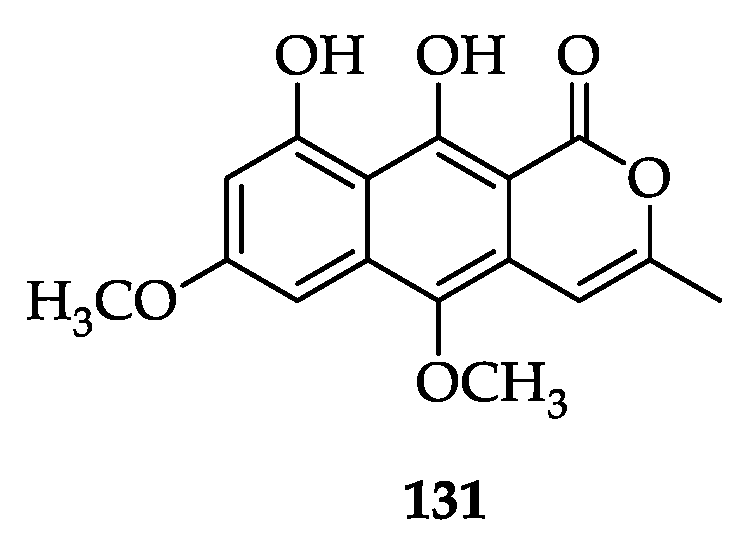
Besides Paepalanthus bromelioides, compound 131, paepalantine, was also isolated from P. vellozioides following Vilegas et al.’s (1990) separation procedure. Mutagenic and cytotoxic activities were tested against Salmonella typhimurium TA100, TA98, and TA102, and McCoy cells using the Neutral Red (NR) and microculture tetrazolium (MTT) techniques, respectively. Paepalantine showed mutagenic effect both in the absence and the presence of metabolic activation and also showed a IC50 equivalent to 30 and 38 mg mL−1 for NR and MTT, respectively [70]. In 1999, Tavares et al. [71] evaluated the clastogenic effect of compound 131, with negative result, but observed significant cytotoxic activity when testing the compound in vitro and in vivo mammalian cell systems. The intestinal anti-inflammatory activity of compound 131 was also evaluated, resulting in paepalantine significantly attenuating the colonic damage induced by trinitrobenzenesulphonic acid (TNBS) both when colonic mucosa is intact or when the mucosa is recovering after an initial insult [72]. A study on the influence of dimethylsulfoxide (DMSO) in its antioxidant activity was also performed showing that DMSO significantly interfered with the hypochlorous acid (HOCl) assay, but propylene glycol may be the solvent of choice for paepalantine [73].
Paepalantine was found in capitula and scape of Paepalanthus giganteus [33] and also in P. speciosus and P. microphyllus [22]. Additionally, Vilegas et al. isolated glycoside paepalantine-9-O-β-D-glucopyranoside (132) and paepalantine-9-O-β-D-allopyranosyl(1→6)glucopyranoside (133) for the first time in 1998 in ethanolic extract from capitula of P. bromelioides [74]. The ethanolic extract, after partition between n-BuOH and water, was submitted to a DCCC fractionation, which produced 131, 132, and 133. Compound 132 appeared as a yellow amorphous powder and compound 133 as yellow needles, but both appeared as yellowish-green spots on TLC.
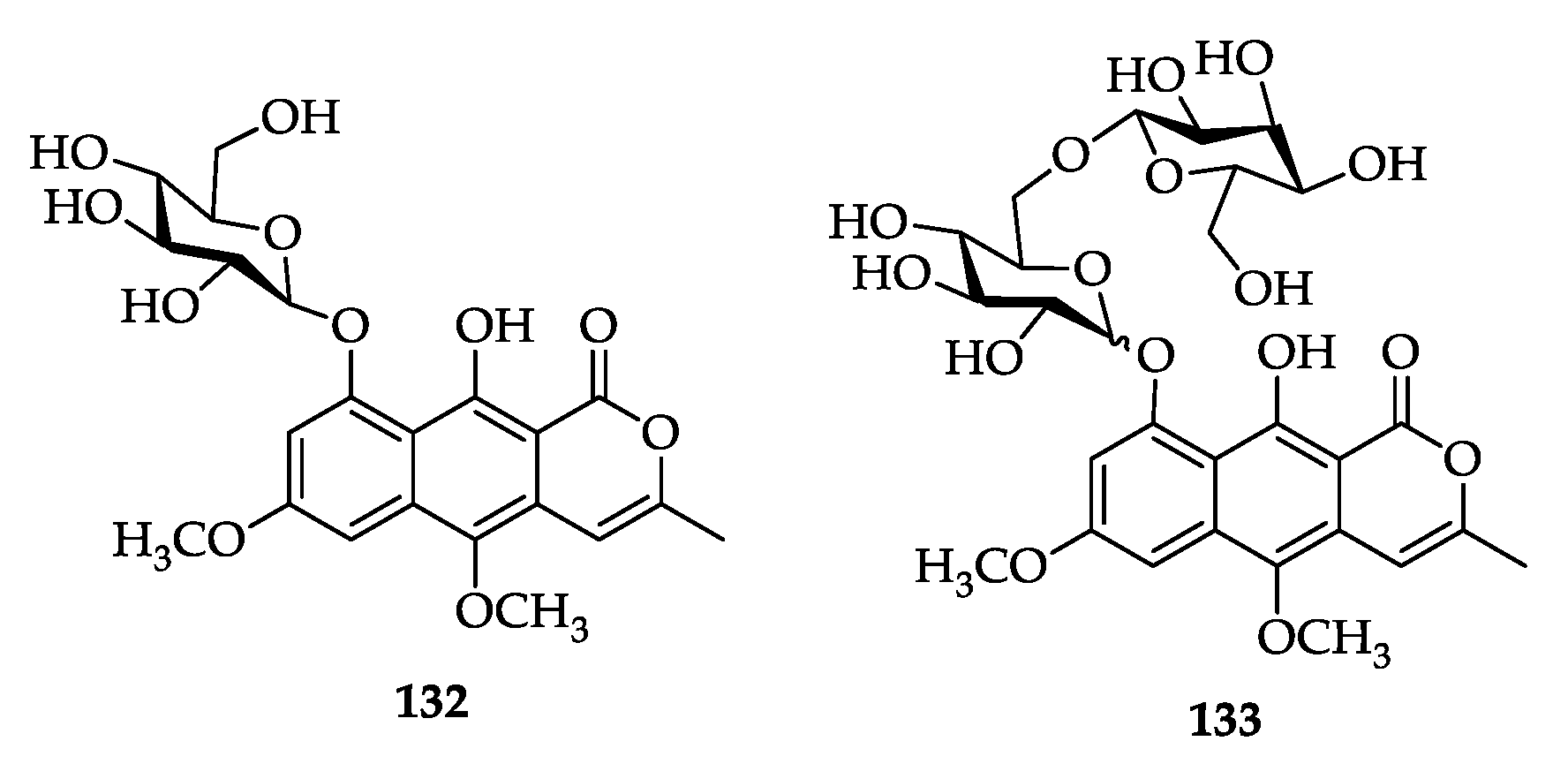
Compounds 131 and 132 were also isolated from Paepalanthus acanthophyllus. The supernatant of methanol extract was fractioned in Sephadex LH-20 column and the fractions were filtered in SPE RP-18 cartridge. After chromatographic profile by HPLC-PDA, a chosen fraction was submitted to separation in a semipreparative HPLC-PDA, leading to isolation of both 131 and 132 [65]. Compound 132 was also isolated from P. planifolius [75].
When evaluating the cytotoxicity of the three naphthopyranones against McCoy cells using neutral red assays [76], 131–133 showed a significant cytotoxic index when compared with the IC50 value of cisplatin, a cytotoxic substance used in antineoplasic therapy. When tested for antimicrobial activity using a spectrophotometric microdilution technique, 131 was active against Syngonanthus aureus, S. epidermidis, and Eriocaulon faecalis whereas 132 and 133 proved ineffective against all microorganisms tested [77].
Leitão et al. (2002) also isolated compounds 131–133 in the same Paepalanthus bromelioides extract by HSCCC and evaluated their antioxidant activity. As a result, 131 showed good antioxidant activity in the DPPH radical assay [78]. Moreira et al. (2013) also isolated compound 133 and assessed the antimycobacterial activity using the Alamar BlueTM (MABA) method disqualifying the naphthopyranone 133 as a promising candidate against Mycobacterium tuberculosis and M. avium [37].
Besides Paepalanthus bromelioides, compounds 132 and 133 were also isolated from P. hilairei, P. vellozioides, P. latipes [38], P. robustus, P. ramosus [35], P. macrocephalus, P. denudatus [52], P. speciosus, P. microphyllus [22], and the methanolic extract of Eriocaulon ligulatum capitula [47].
Compound 9,10-dihydroxy-7-methoxy-3-methyl-1H-naphtho-[2,3c]-pyran-1-one-9-O-β-D-allopyranosyl(1→6)glucopyranoside (133) was isolated from Paepalanthus macropodus capitula after chromatographing the EtOH extract on a Sephadex LH-20 column. Andrade et al. (2002) [43] identified the compound by spectroscopic methods and compared it to those previously reported.
The crude MeOH extracts of Paepalanthus vellozioides and P. latipes leaves, after purification with Amberlite XAD-2 followed by Sephadex LH-20 column, produced a crude glycosidic mixture, which was separated by reverse-phase HPLC, to yield pure compounds 134, 135, and 136. Their structures were determined by spectroscopic and spectrometric techniques [23]. Additionally, the naphthopyranones 134 and 136 were identified in aerial parts of Actinocephalus divaricatus by high-resolution orbitrap mass spectrometry [79]. Compounds 134, 135, and 136 were also isolated in the whole Eriocaulon buergerianum species [53].

In 2001, the known 3,4-dihydro-10-hydroxy-7-methoxy-3-methyl-1H-3,4-dihydronaphtho [2,3c]pyran-1-one-9-O-β-D-allopyranosyl-(1→6)-β-D-glucopyranoside (136) was isolated from the ethanolic extract of Paepalanthus planifolius leaves. Additionally, the first naphthopyranone dimer (137), named planifolin, composed of monomeric portions of semi-vioxanthin and paepalantine linked by an ether bond, was isolated from the dichloromethane extract of P. planifolius capitula [80]. Cytotoxicity and mutagenic tests were performed with planifolin. The dimer showed a significant cytotoxic index (IC50 12.83 µg mL−1) and mutagenic activity for TA100, TA98, and TA97a [81].
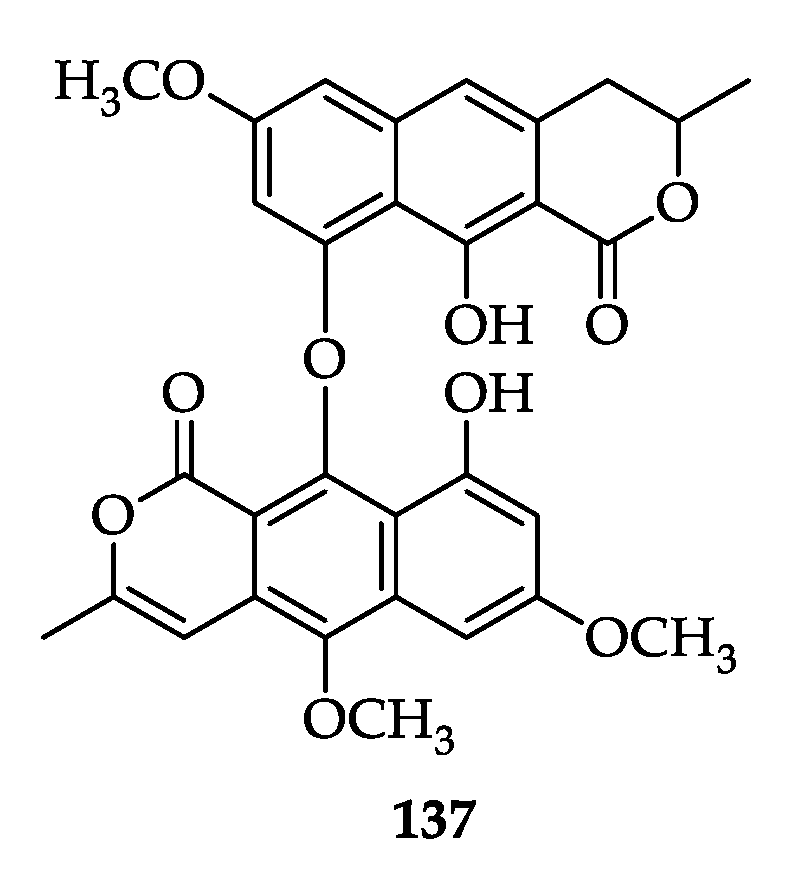
Three new naphthopyranone glycosides, named paepalantine-9-O-β-D-glucopyranosyl-(1→6)-β-D-glucopyranoside (138), paepalantine-9-O-α-L-arabinopyranosyl-(1→6)-β-D-glucopyranoside (139), and paepalantine-9-O-α-L-rhamnopyranosyl-(1→6)-β-D-glucopyranoside (140), and the known paepalantine-9-O-β-D-glucopyranoside (132) were isolated from aerial parts of Paepalanthus microphyllus. All compounds were tested in C8166 cells infected with HIV-1MN, showing disappointing activities [82].
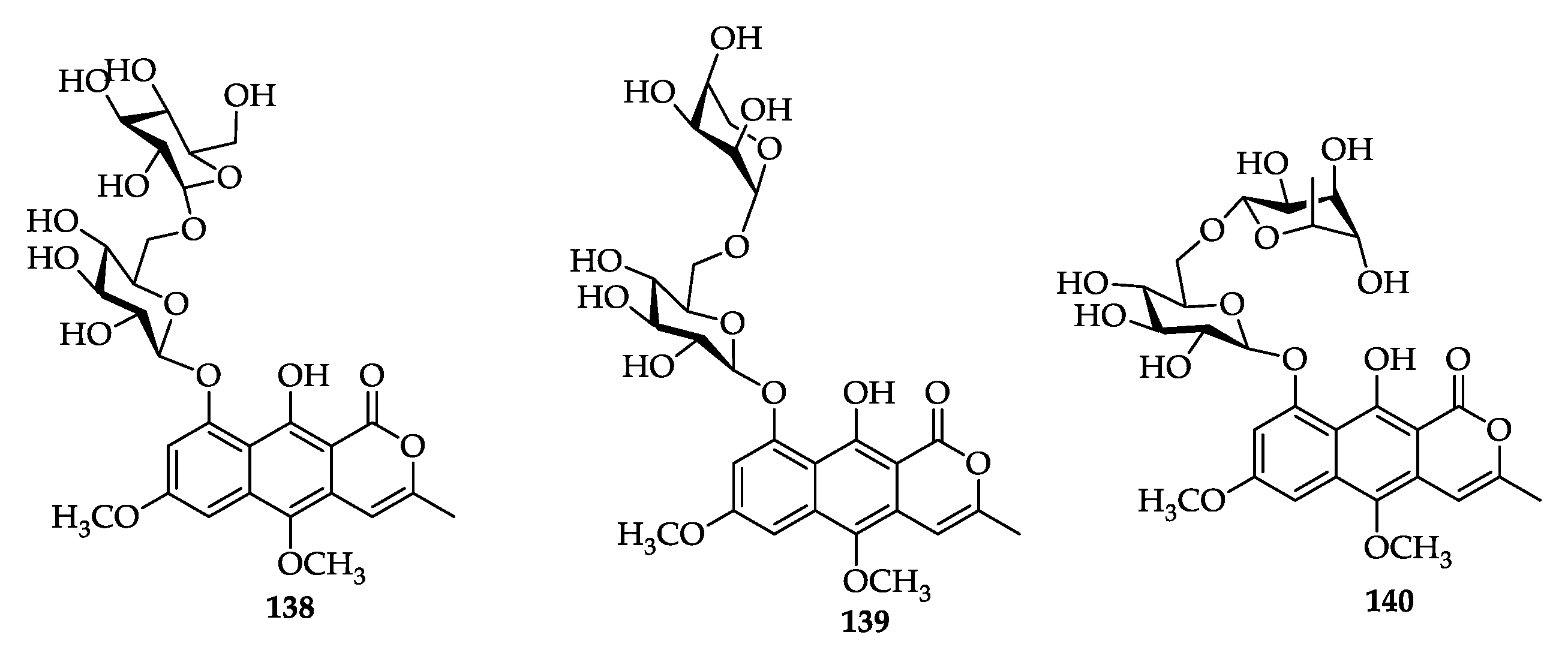
The ethanol extract of aerial parts of Paepalanthus bromelioides was submitted to Sephadex LH-20 gel permeation column. The rechromatography of crude ethanolic extracts in silica gel resulted in isolation of two naphthopyranones, paepalantine-9-O-β-D-allopyranosyl-(1→6)-β-D-glycopyranoside (133), and paepalantine-9-O-β-D-glycopyranosyl-(1→6)-β-D-glycopyranoside (138) [37]. Both compounds had been isolated previously.
Another dimer was isolated by Coelho et al. (2000) [83]. This new naphthopyrone dimer (141) was isolated from Paepalanthus bromelioides capitula CH2Cl2 extract by chromatographic procedures. A colorimetric assay for cytotoxicity evaluation showed IC50 55.9 µM. In 2004, Varanda et al. tested 8,8′-paepalantine dimer (141), 132, and 133 mutagenicity in Salmonella typhimurium TA97a, TA98, TA100, and TA102 strains. Results showed mutagenic activity in TA97a strain treated with naphthopyranone 132 [84]. Amorim et al. (2018) also isolated 141 from P. planifolius [75].
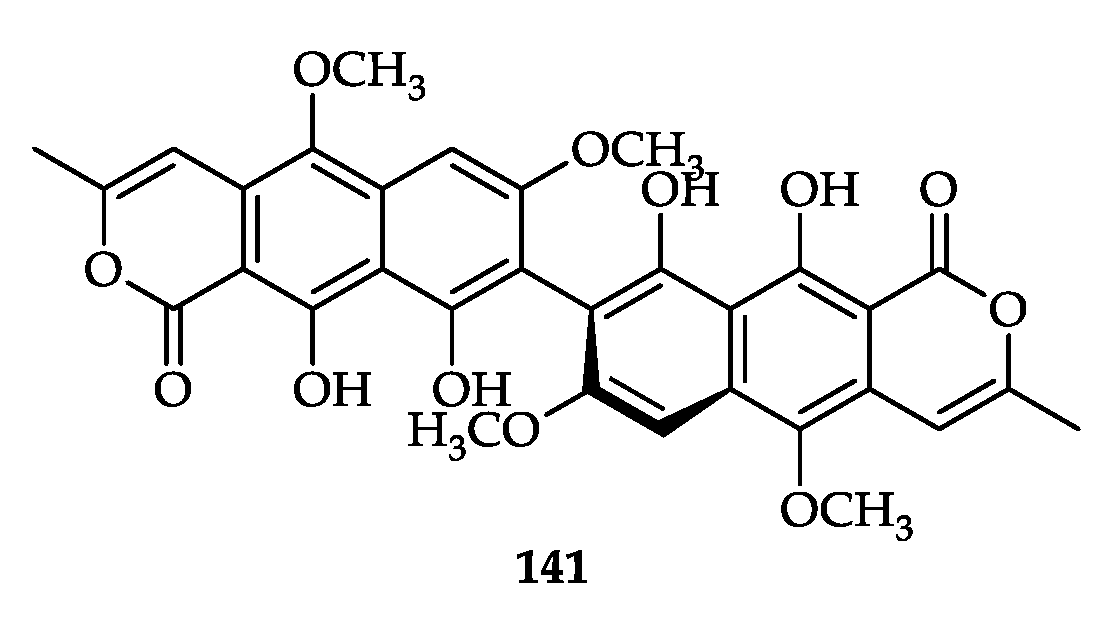
Vioxanthin (142), a yellow–green powder, was isolated for the first time from acetone extracts of Paepalanthus falcifolius Koern., P. albovaginatus Alv. Silv., P. argenteus Koern., P. cuspidatus Alv. Silv., and P. ramosus Kunth. According to Provost and Garcia (1990), vioxanthin is very common in fungi of Tricophyton genus. However, those species studied were collected in different regions of Brazil and the plants showed no detectable contamination by microorganisms. Thus, this was the first isolation from a plant source [85]. Vioanthin was also found in P. bromelioides capitula CH2Cl2 extract and in P. planifolius capitula EtOAc extract [75]. Furthermore, effects of compounds 131, 141, and 142 on mitochondria were evaluated [86,87].
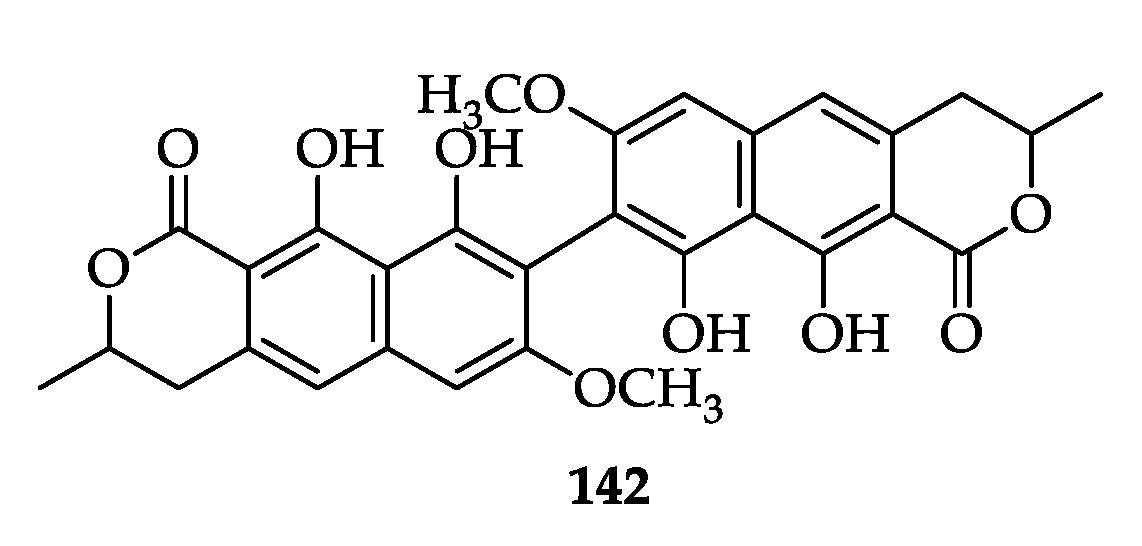
Eriocauline (143) is a naphthopyranone dimer isolated from Eriocaulon ligulatum capitula. The dichloromethane extracts were submitted to column chromatography on silica gel and their structure was identified by spectroscopic and spectrometric experiments [51].
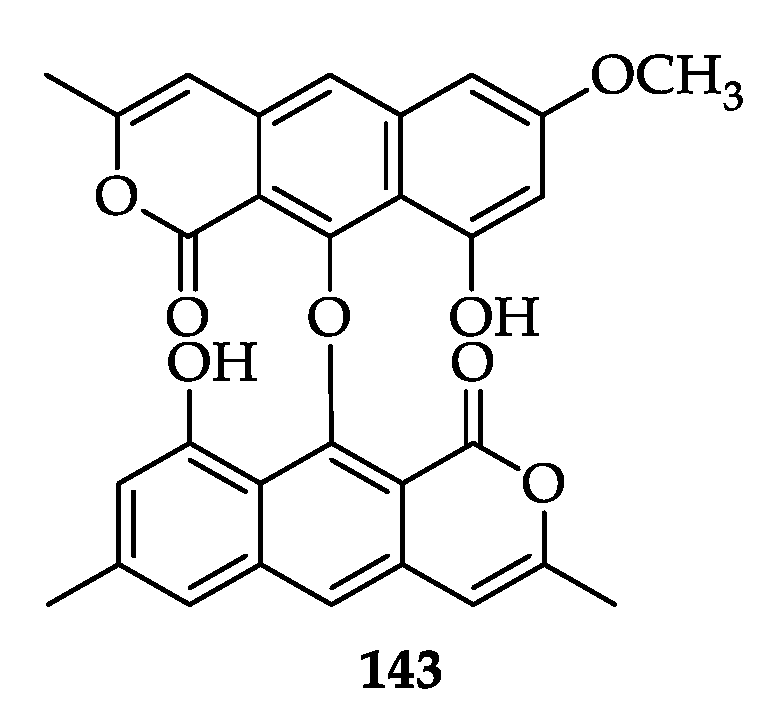
Three other compounds, 144, 145, and 146, were characterized from Eriocaulon ligulatum capitula. The methanolic extract was analyzed by liquid chromatography electrospray ionization multistage ion trap mass spectrometry (LC-ESI-IT-MSn). All three compounds were identified based on their fragmentation patterns in MS and in NMR spectra. This was the first report of 144 and 145 in Eriocaulon genus [55]. Additionally, compound 146 was isolated in the whole E. buergerianum [53] and in Paepalanthus denudatus and P. speciosus [22,52].
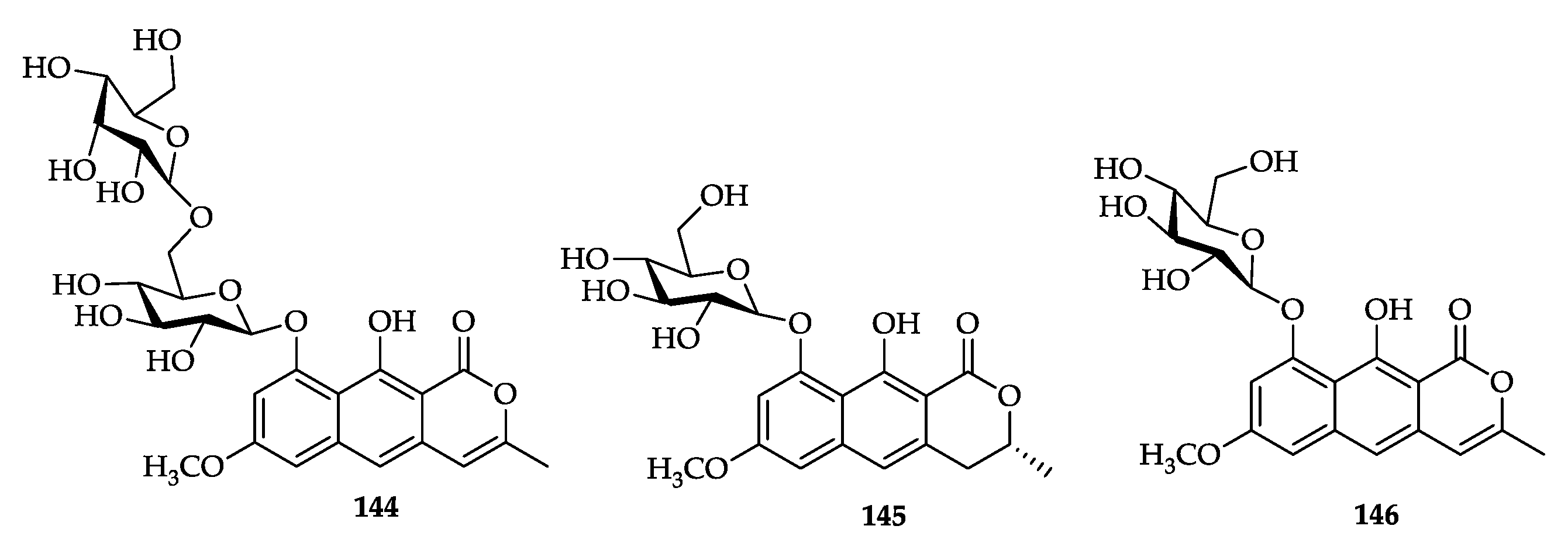
The ethanolic extract of Paepalanthus macrocephalus was analyzed by HPLC-ES-MS in an RP-18 column with MeCN/H20 (30:70% + 1% HCOOH) as eluent system. The m/z 273 and the m/z 597 suggested the presence of compounds 5-desmethoxypaepalantine (147) and 5-desmethoxypaepalantine-9-O-β-D-glucopyranosyl(1→6)glucopyranosideo (148), respectively [22,52]. Compounds 147 and 148 were also isolated in the hydroethanolic extract of Eriocaulon buergerianum Koern. The EtOAc fraction yielded compound 147, and the BuOH and H2O fraction yielded 148 [66].
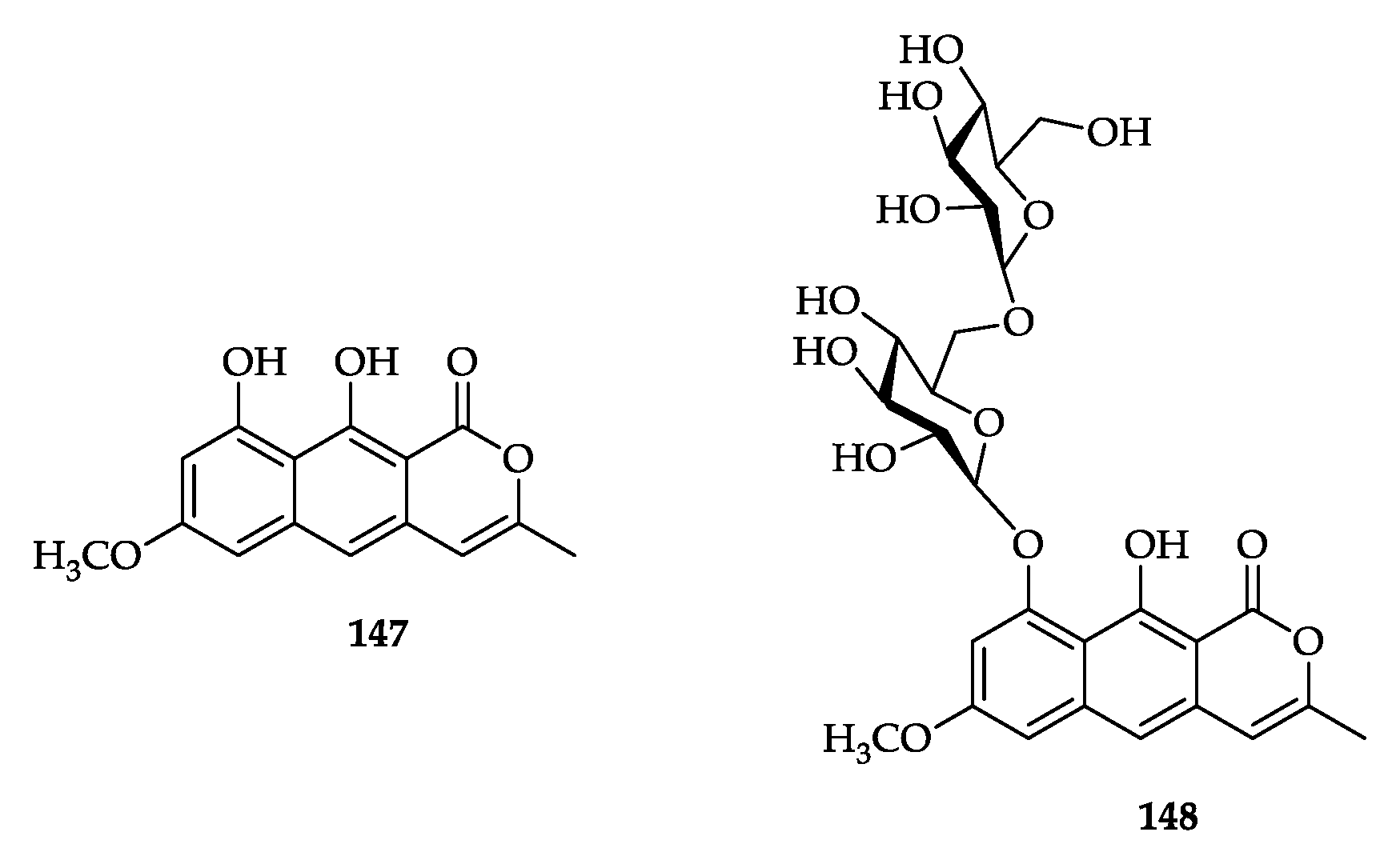
Paepalanthus geniculatus Kunth. flowers were submitted to HPLC-ESI-MSn analysis after the methanol extract showed radical-scavenging activity in the Trolox equivalent antioxidant capacity (TEAC) assay. Two known naphthopyranones (149, 150) and two new ones (151, 152) were isolated. In antioxidant assay, compounds 151 and 152 showed the highest TEAC values [61]. The naphthopyranones 151 and 152 were identified in aerial parts of Actinocephalus divaricatus by high-resolution orbitrap mass spectrometry [79].
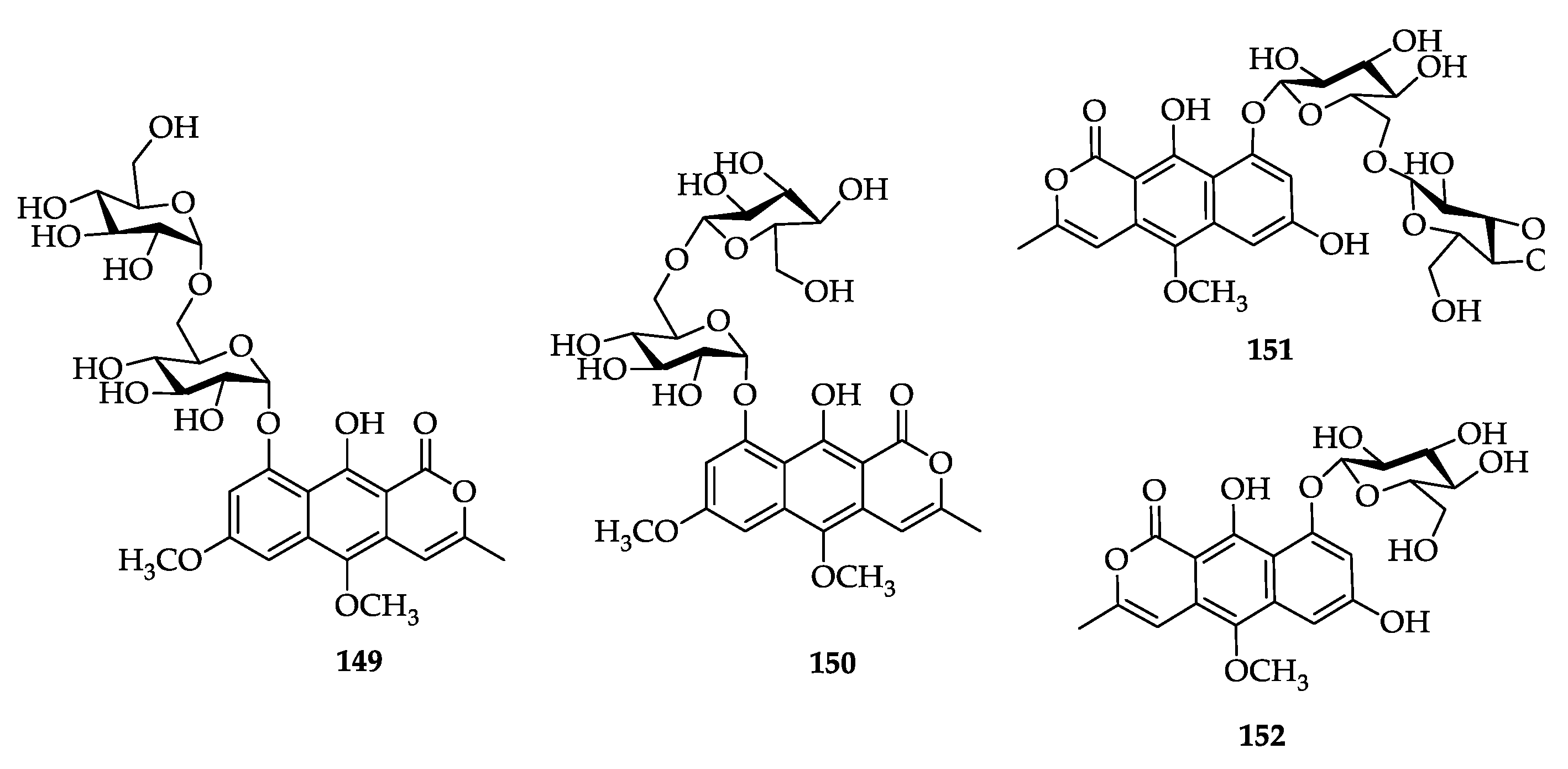
The dichloromethane extract of Paepalanthus diffissus rhizomes led to a precipitate of a green solid residue, which was purified by chromatography and crystallization, providing a pure yellow needle of (+)-Semi-vioxanthin (153). Another fraction was chromatographed on a Sephadex LH-20 column giving a crystalline solid like pale-yellow needles, identified as vioxanthin (142) [88]. Additionally, Semi-vioxanthin (153) was isolated from P. planifolius capitula EtOAc extract [75].
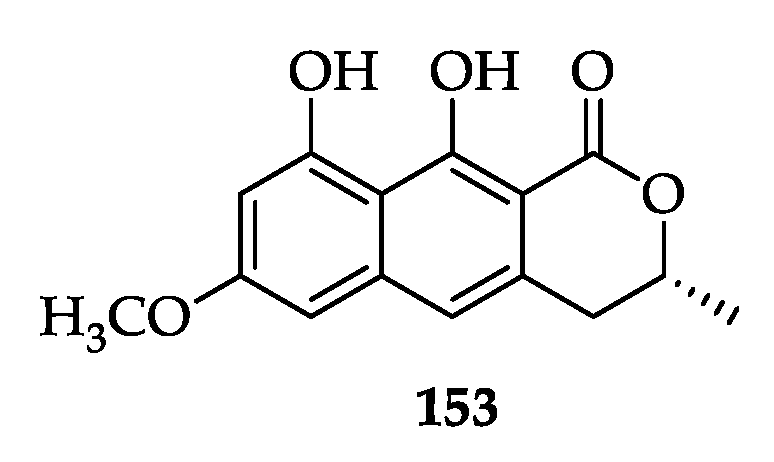
The methanol extracts of Paepalanthus chiquitensis capitula and scapes were submitted to HPLC-ESI-IT-MSn to characterization. In capitula, the naphthopyranones 132, 146, 154, and 155 were identified, whereas, in scapes, 146 and 154 were identified [64]. Compound 155 was also isolated from Actinocephalus divaricatus (Körn.) Sano methanolic extract [79].

Studying Paepalanthus planifolius capitula EtOAc extract allowed the identification of paepalantine-9-O-β-D-glucopyranosyl (132), 1H-naphtho[2,3-c]pyran-1-one,9-[(6-O-β-D-glucopyranosyl-β-D-glucopyranosyl)oxy]-3,4-dihydro-10-hydroxy-7-methoxy-3-methyl (135), paepalantine dimer (141), vioxanthin (142), semi-vioxanthin-9-O-β-D-glucopyranoside (145), and semivioxanthin (153), as previously mentioned [75]. Furthermore, Amorim et al. (2018) [75] also identified 1H-naphtho[2,3-c]pyran-1-one,3,4-dihydro-9,10-dihydroxy-5,7-dimethoxy-3-methyl (156). A new naphthopyranone dimer named planifoliusin A (157) was also isolated. Other naphthopyranone dimers (158–163) were proposed by MS fragmentation patterns.

Qiao et al. (2012) [67], studying the chemical constituents of a Chinese herbal medicine Gu-Jing-Cao (Eriocaulon buergerianum) to identify adulterating species by HPLC-DAD-ESI-MSn, identified the naphthopyranones 146, 148, and 164 in Eriocaulon sexangulare; 145, 148, 153, and 164–166 in E. buergerianum; 145, 148, 153, and 164–166 in E. cinereum; and 148, 153, and 164–166 in E. faberi.
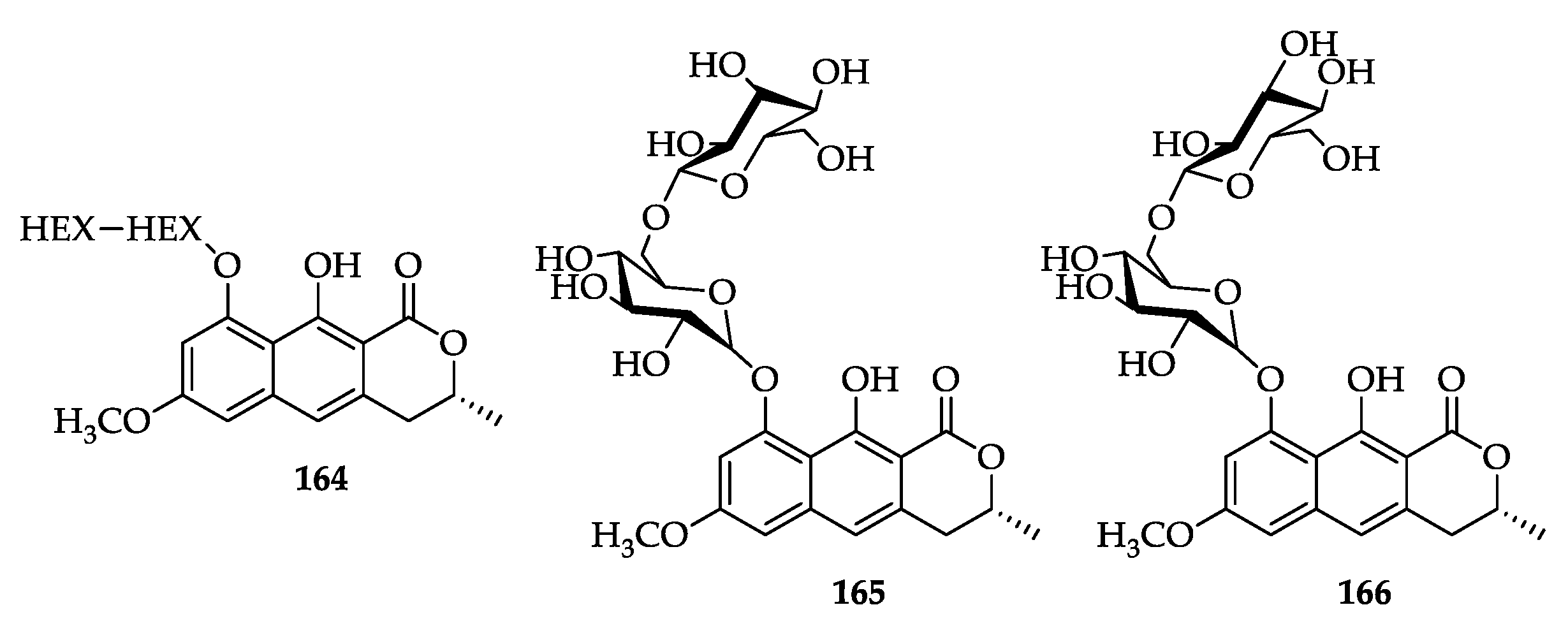
In short, they found thirty-six naphthopyranones isolated from one species of Actinocephalus, five species of Eriocaulon, and twenty-one species of Paepalanthus, being four aglycones, twenty-one glycones, and eleven dimers. The dimers were isolated in Paepalanthus and Eriocaulon at the positions C-8, C-9, and C-10. The glycosylation pattern occurs only at the C-9 position, with a binding between the naphthopyranone and α-glucose or β-glucose being very common. When the binding is between a naphthopyranone and a disaccharide, the glucoside unit starts with a glucose. The sugars forming disaccharides with glucose are glucose, rhamnose, arabinose, and allose.
Table 2 shows the names of naphthopyranones, the part of the plant where they were isolated, species, and authors.

Table 2.
Naphthopyranones isolated from Eriocaulaceae species.
Table 2.
Naphthopyranones isolated from Eriocaulaceae species.
| Compounds | MF | [M−H]− | Organ | Species | Reference |
|---|---|---|---|---|---|
| Paepalantine (131) | C16H14O6 | 301 | Capitula | Paepalanthus bromelioides | [69] |
| Capitula | P. bromelioides | [72] | |||
| Capitula | P. bromelioides | [73] | |||
| Capitula | P. bromelioides | [78] | |||
| Capitula | P. bromelioides | [86] | |||
| Capitula | P. bromelioides | [87] | |||
| Capitula | P. vellozioides | [70] | |||
| Capitula | P. vellozioides | [71] | |||
| Capitula/ Scape | P. giganteus | [33] | |||
| - | P. speciosus | [22] | |||
| - | P. microphyllus | [22] | |||
| Capitula | P. acanthophyllus | [65] | |||
| Paepalantine-9-O-β-D-glucopyranoside (132) | C22H24O11 | 463 | Capitula | P. bromelioides | [74] |
| Capitula | P. bromelioides | [78] | |||
| Capitula | P. bromelioides | [38] | |||
| Capitula | P. acanthophyllus | [65] | |||
| Capitula | P. planifolius | [75] | |||
| Capitula | P. hilairei | [38] | |||
| Capitula | P. hilairei | [35] | |||
| Capitula | P. vellozioides | [38] | |||
| Capitula | P. latipes | [38] | |||
| Capitula | P. robustus | [35] | |||
| Capitula | P. ramosus | [35] | |||
| Capitula | P. denudatus | [35] | |||
| Capitula | P. denudatus | [52] | |||
| Capitula | P. macrocephalus | [52] | |||
| Capitula | P. chiquitensis | [64] | |||
| Capitula | Eriocaulon ligulatum | [47] | |||
| - | P. speciosus | [22] | |||
| - | P. microphyllus | [22] | |||
| Aerial part | P. microphyllus | [82] | |||
| Paepalantine-9-O-β-D-allopyranosyl-(1→6)-glucopyranoside (133) | C28H34O16 | 625 | Capitula | P. bromelioides | [74] |
| Capitula | P. bromelioides | [78] | |||
| Capitula | P. bromelioides | [38] | |||
| Aerial part | P. bromelioides | [37] | |||
| Capitula | P. hilairei | [38] | |||
| Capitula | P. hilairei | [35] | |||
| Capitula | P. vellozioides | [38] | |||
| Capitula | P. latipes | [38] | |||
| Capitula | P. robustus | [35] | |||
| Capitula | P. ramosus | [35] | |||
| Capitula | P. denudatus | [35] | |||
| Capitula | P. denudatus | [52] | |||
| Capitula | P. macrocephalus | [52] | |||
| Capitula | P. macropodus | [43] | |||
| Capitula | E. ligulatum | [47] | |||
| - | P. speciosus | [22] | |||
| - | P. microphyllus | [22] | |||
| 3,4-dihydro-10-hydroxy-7-methoxy-3-(R)-methyl-1H-3,4-dihydronaphtho-[2,3c]-pyran-1-one-9-O-β-D-glucopyranoside (134) | C21H24O10 | 435 | Leaves | P. vellozioides | [23] |
| Leaves | P. latipes | [23] | |||
| Aerial parts | Actinocephalus divaricatus | [79] | |||
| Whole plant | E. buergerianum | [53] | |||
| 3,4-dihydro-10-hydroxy-7-methoxy-3-(R)-methyl-1H-3,4-dihydronaphtho-[2,3c]-pyran-1-one-9-O-β-D-glucopyranosyl-(1→6)-glucopyranoside (135) | C27H34O15 | 597 | Leaves | P. vellozioides | [23] |
| Leaves | P. latipes | [23] | |||
| Whole plant | E. buergerianum | [53] | |||
| Capitula | P. planifolius | [75] | |||
| 3,4-dihydro-10-dihydroxy-7-methoxy-3-(R)-methyl-1H-3,4-dihydronaphtho-[2,3c]-pyran-1-one-9-O-β-D-allopyranosyl-(1→6)-glucopyranoside (136) | C27H34O15 | 597 | Leaves | P. vellozioides | [23] |
| Leaves | P. latipes | [23] | |||
| Aerial parts | A. divaricatus | [79] | |||
| Whole plant | E. buergerianum | [53] | |||
| Leaves | P. planifolius | [80] | |||
| Planifolin (137) | C31H26O10 | 557 | Capitula | P. planifolius | [80] |
| Paepalantine-9-O-β-D-glucopyranosyl-(1→6)-β-D-glucopyranoside (138) | C28H34O16 | 625 | Aerial part | P. microphyllus | [82] |
| Aerial part | P. bromelioides | [37] | |||
| Paepalantine-9-O-a-L-arabinopyranosyl-(1→6)-β-D-glucopyranoside (139) | C27H32O15 | 595 | Aerial part | P. microphyllus | [82] |
| Paepalantine-9-O-a-L-rhamnopyranosyl-(1→6)-β-D-glucopyranoside (140) | C28H34O15 | 609 | Aerial part | P. microphyllus | [82] |
| 8,8′-paepalantine dimer (141) | C32H28O12 | 603 | Capitula | P. bromelioides | [83] |
| Capitula | P. bromelioides | [86] | |||
| Capitula | P. bromelioides | [87] | |||
| Capitula | P. planifolius | [75] | |||
| Vioxanthin (142) | C30H26O10 | 545 | Collar | P. falcifolius | [85] |
| Collar | P. albovaginatus | [85] | |||
| Collar | P. argenteus | [85] | |||
| Collar | P. cuspidatus | [85] | |||
| Collar | P. ramosus | [85] | |||
| Capitula | P. bromelioides | [86] | |||
| Capitula | P. bromelioides | [87] | |||
| Capitula | P. planifolius | [75] | |||
| Rhizomes | P.diffissus | [88] | |||
| Eriocauline (143) | C30H22O8 | 509 | Capitula | E. ligulatum | [51] |
| 9,10-dihydroxy-7-methoxy-3-(R)-methyl-1H-naphtho[2,3c]pyran-1-one-9-O-β-D-allopyranosyl-(1→6)-glucopyranoside (144) | C27H32O15 | 595 | Capitula | E. ligulatum | [38] |
| 9,10-dihydroxy7-methoxy-3-(R)-methyl-1H-3,4-dihydronaphtho[2,3c]pyran-1-one-9-O-β-D-glucopyranoside (145) | C21H24O10 | 435 | Capitula | E. ligulatum | [38] |
| Capitula | P. planifolius | [75] | |||
| Capitula/seeds | E. buergerianum | [67] | |||
| Capitula/seeds | E. cinereum | [67] | |||
| 9,10-dihydroxy-7-methoxy-3-(R)-methyl-1Hnaphtho[2,3c]pyran-1-one-9-O-β-D-glucopyranoside (146) | C21H22O10 | 433 | Capitula | E. ligulatum | [38] |
| Whole plant | E. buergerianum | [53] | |||
| Capitula | P. denudatus | [52] | |||
| Capitula | P. chiquitensis | [64] | |||
| Scapes | P. chiquitensis | [64] | |||
| Capitula/seeds | E. sexangulare | [67] | |||
| - | P. speciosus | [22] | |||
| 5-desmethoxypaepalantine (147) | C15H12O5 | 271 | Capitula | P. macrocephalus | [52] |
| Aerial part | E. buergerianum | [66] | |||
| 5-desmethoxypaepalantine-9-O-β-D-glucopyranosyl-(1→6)-glucopyranosideo (148) | C27H32O15 | 595 | Capitula | P. macrocephalus | [52] |
| Aerial part | E. buergerianum | [66] | |||
| Capitula/seeds | E. sexangulare | [67] | |||
| Capitula/seeds | E. cinereum | [67] | |||
| Capitula/seeds | E. faberi | [67] | |||
| Paepalantine-9-O-α-D-glucopyranosyl-(1→6)-α-D-glucopyranoside (149) | C28H34O16 | 625 | Flowers | P. geniculatus | [61] |
| Paepalantine-9-O-β-D-allopyranosyl-(1→6)-α-D-glucopyranoside (150) | C28H34O16 | 625 | Flowers | P. geniculatus | [61] |
| 7,9,10-trihydroxy-5-methoxy-3-methyl-1H-naphtho[2,3-c]pyran-1-one-9-O-β-D-glucopyranosyl-(1→6)-β-D-glucopyranoside (151) | C27H32O16 | 611 | Flowers | P. geniculatus | [61] |
| Aerial parts | A. divaricatus | [79] | |||
| 7,9,10-trihydroxy-5-methoxy-3-methyl-1H-naphtho[2,3-c]pyran-1-one-9-O-β-D-glucopyranoside (152) | C21H22O11 | 449 | Flowers | P. geniculatus | [61] |
| Aerial parts | A. divaricatus | [79] | |||
| (+)-Semi-vioxanthin (153) | C15H14O5 | 273 | Rhizomes | P.diffissus | [88] |
| Capitula | P. planifolius | [75] | |||
| Capitula/seeds | E. buergerianum | [67] | |||
| Capitula/seeds | E. cinereum | [67] | |||
| Capitula/seeds | E. faberi | [67] | |||
| 5-10-Ddihydroxy-7-methoxy-3-methyl-1Hnaphtho[2,3c]pyran-1-one-9-O-α-L-rhamnopyranosyl-(1→6)-O-β-D-glucopyranoside (154) | C27H32O15 | 595 | Capitula | P. chiquitensis | [64] |
| Scapes | P. chiquitensis | [64] | |||
| 10-Hydroxy-5,7-dimethoxy-3-methyl-1H-naphtho[2,3c]pyran1-one-9-O-β-D-allopyranosyl-(1→6)-O-β-D-glucopyranoside (155) | C28H34O16 | 625 | Capitula | P. chiquitensis | [64] |
| Aerial parts | A. divaricatus | [79] | |||
| 1H-naphtho[2,3-c]pyran-1-one,3,4-dihydro-9,10-dihydroxy-5,7-dimethoxy-3-methyl (156) | Capitula | P. planifolius | [75] | ||
| Planifoliusin A (157) | C31H26O11 | 573 | Capitula | P. planifolius | [75] |
| Planifoliusin B (158) | C31H28O11 | 575 | Capitula | P. planifolius | [75] |
| Planifoliusin C (159) | C32H30O12 | 605 | Capitula | P. planifolius | [75] |
| Planifoliusin D (160) | C32H24O10 | 543 | Capitula | P. planifolius | [75] |
| Planifoliusin E (161) | C32H28O12 | 603 | Capitula | P. planifolius | [75] |
| Planifoliusin F (162) | C30H22O10 | 541 | Capitula | P. planifolius | [75] |
| Planifoliusin G (163) | C31H24O11 | 571 | Capitula | P. planifolius | [75] |
| Semivioxanthin-9-O-hexosyl-hexoside (164) | C27H34O15 | 597 | Capitula/seeds | E. sexangulare | [67] |
| Capitula/seeds | E. buergerianum | [67] | |||
| Capitula/seeds | E. cinereum | [67] | |||
| Capitula/seeds | E. faberi | [67] | |||
| (R)-Semivioxanthin-9-O-β-D-allosyl-(1→6)-glucoside (165) | C27H34O15 | 597 | Capitula/seeds | E. buergerianum | [67] |
| Capitula/seeds | E. cinereum | [67] | |||
| Capitula/seeds | E. faberi | [67] | |||
| (R)-Semivioxanthin-9-O-β-D-glucosyl-(1→6)-glucoside (166) | C27H34O15 | 597 | Capitula/seeds | E. buergerianum | [67] |
| Capitula/seeds | E. cinereum | [67] | |||
| Capitula/seeds | E. faberi | [67] |
MF = molecular formula.
2.1.3. Compounds Isolated from Eriocaulaceae Fungi
Living plants are colonized by plenty of micro-organisms [89]. Endophytic fungi are microorganisms that inhabit internal plant tissues and provide benefits to the host [90]. They may produce equal or analogous metabolites as their host plants with potential application in many agricultural and industrial segments, which increased many scientists’ interests in studying potential biologically active compounds [91].
Amorim et al. (2016) isolated endophytic fungi from Paepalanthus planifolius capitula, scapes, and leaves [92]. After treatment for fungus proliferation, fifteen single fungal strains were obtained and one of them was identified as Anthostomella brabeji. A. brabeji was submitted to liquid–liquid partition with ethyl acetate, resulting in a crude extract. The ethyl acetate extract was purified by semipreparative HPLC-DAD, leading to the isolation of four compounds: new natural product 167 (6.1 mg), 168 (19.4 mg), 169 (9.7 mg), and 170 (13.6 mg). The isolated compounds and EtOAC extract were assayed against the microorganisms Candida albicans, Escherichia coli, Salmonella setubal, and Staphylococcus aureus. Measured MIC values ranged from 31.25 μg mL−1 to 1000.0 μg mL−1.

Hilário et al. (2017), studying aerial parts of Paepalanthus chiquitensis, isolated the endophytic fungi Fusarium fujikuroi and found the ethyl acetate extract was bioactive against Gram-positive bacteria Staphylococcus aureus, Gram-negative Escherichia coli and Salmonella setubal, and the fluconazole-resistant yeast Candida albicans. This chemical study yielded an alkaloid 2-(4-butylpicolinamide) acetic acid (171) and three known compounds: fusaric acid (172), indole acetic acid (173), and terpestacin (174). The minimal inhibitory concentration of the extract, fusaric acid, and indole acetic acid had values from 125 to 1000 μg mL−1 [93].

Three years after the first study on metabolites isolated from endophytic fungi of Paepalanthus planifolius, Amorim et al. (2019) isolated three new benzaldehyde derivatives, sporulosaldeins A–C (175–177), and three new benzopyran derivatives, sporulosaldeins D–F (178–180) from Paraphaeosphaeria sp. F03 in P. planifolius leaves. All isolated compounds had their chemical structure elucidated by nuclear magnetic resonance experiments and high-resolution mass spectrometry analysis. The cytotoxic MCF-7 and LM3 cells and antimicrobial activities were also tested [94].
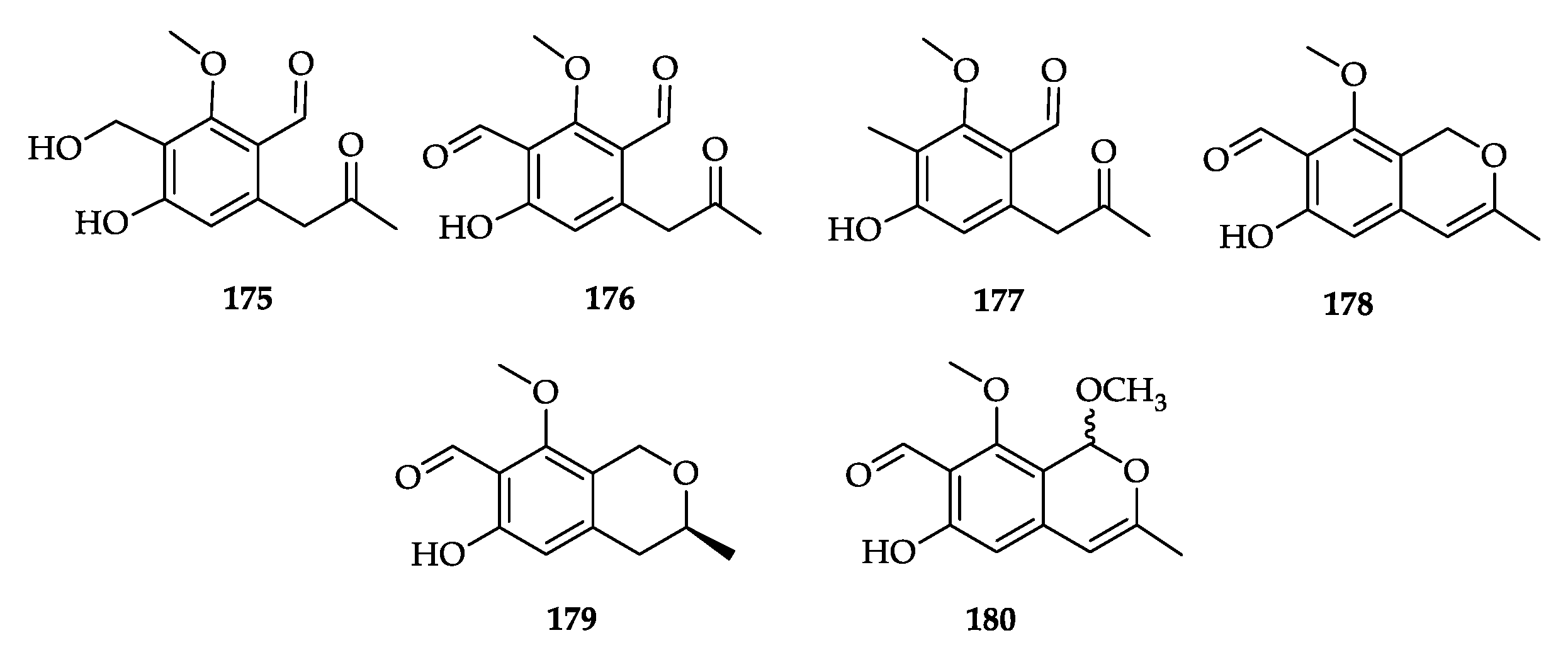
Continuing their studying on aerial parts, [95] isolated the endophytic fungus Curvularia lunata of Paepalanthus chiquitensis capitula. The EtOAc extract (1.3 g) obtained from C. lunata was fractionated by Sephadex LH-20 column chromatography and eluted with 100% MeOH. Those proceedings yielded two new spirocyclic γ-lactams (183–184), and the known triticones E (181) and F (182), 5-O-methylcurvulinic acid (185), curvulinic acid (186), and curvulin (187). The antimicrobial assay was performed, showing a good activity for triticones 181 and 182 against Escherichia coli (MIC 62.5 μg mL−1) [95].

In short, those compounds isolated from Eriocaulaceae family derived from acetylenic phenols, acids, alkaloids, benzaldehydes, benzopyran, chromanones, and sesterpenes. Most of them were isolated from endophytic fungi present in aerial parts of three different species of Paepalanthus. Table 3 shows that information.

Table 3.
Compounds of endophytic fungi isolated from Paepalanthus species.
Table 3.
Compounds of endophytic fungi isolated from Paepalanthus species.
| Compounds | MF | [M−H]− | Organ | Species | Reference |
|---|---|---|---|---|---|
| (+)-(6R*,7S*,8R*)-6,7,8-trihydroxy- 2,2-dimethyl-5,6,7,8-tetrahydro-croman-4-one (167) | C11H16O5 | 227 | Capítulo/ Anthostomella brabeji | Paepalanthus planifolius | [92] |
| 6-hydroxy-2,2-dimethyl-5,6,7,8- tetrahydro-7,8-epoxychroman-4-one (168) | C11H14O4 | 209 | Capítulo/ Anthostomella brabeji | P. planifolius | [92] |
| Sicaine (169) | C11H10O2 | 173 | Capítulo/ Anthostomella brabeji | P. planifolius | [92] |
| Eutypinol (170) | C12H12O2 | 187 | Capítulo/ Anthostomella brabeji | P. planifolius | [92] |
| 2-(4-butylpicolinamide) acetic acid (171) | C12H16N2O3 | 235 | Parte aérea/ Fusarium fujikuroi | P. chiquitensis | [93] |
| Fusaric acid (172) | C10H13NO2 | 178 | Partes aéreas/ Fusarium fujikuroi | P. chiquitensis | [93] |
| Indoleacetic acid (173) | C10H9NO2 | 174 | Partes aéreas/ Fusarium fujikuroi | P. chiquitensis | [93] |
| Terpestacine (174) | C25H38O4 | 401 | Parte aérea/ Fusarium fujikuroi | P. chiquitensis | [93] |
| Sporulosaldeine A (175) | C12H14O5 | 237 | Folhas/ Paraphaeosphaeria sp. F03 | P. planifolius | [94] |
| Sporulosaldeine B (176) | C12H12O5 | 235 | Folhas/ Paraphaeosphaeria sp. F03 | P. planifolius | [94] |
| Sporulosaldeine C (177) | C12H14O4 | 221 | Folhas/ Paraphaeosphaeria sp. F03 | P. planifolius | [94] |
| Sporulosaldeine D (178) | C12H12O4 | 219 | Folhas/ Paraphaeosphaeria sp. F03 | P. planifolius | [94] |
| Sporulosaldeine E (179) | C12H14O4 | 221 | Folhas/ Paraphaeosphaeria sp. F03 | P. planifolius | [94] |
| Sporulosaldeine F (180) | C13H14O5 | 249 | Folhas/ Paraphaeosphaeria sp. F03 | P. planifolius | [94] |
| Triticones E (181) | C14H19NO6 | 296 | Capitula/ Curvularia lunata | P. chiquitensis | [95] |
| Triticones F (182) | C14H19NO6 | 296 | Capitula/ Curvularia lunata | P. chiquitensis | [95] |
| (1S*,2Z,3Z,3′S,6R*)-6,6′-dihydroxy-1′-methoxy-2-ropylidene-3′,4′-dihydro-2′H-spiro[cyclohexane-1,3′-cyclopenta[β]pyrrol]-3-ene-2′,5,5′(1′H)-trione (183) | C16H17NO6 | 318 | Capitula/ Curvularia lunata | P. chiquitensis | [95] |
| (1S*,2Z,3Z,3′S,6S*)-6,6′-dihydroxy-1′-methoxy-2-ropylidene-3′,4′-dihydro-2′H-spiro[cyclohexane-1,3′-cyclopenta[β]pyrrol]-3-ene-2′,5,5′(1′H)-trione (184) | C16H17NO6 | 318 | Capitula/ Curvularia lunata | P. chiquitensis | [95] |
| 5-O-methylcurvulinic acid (185) | C11H12O5 | 223 | Capitula/ Curvularia lunata | P. chiquitensis | [95] |
| Curvulinic acid (186) | C10H10O5 | 209 | Capitula/ Curvularia lunata | P. chiquitensis | [95] |
| Curvulin (187) | C12H14O5 | 237 | Capitula/ Curvularia lunata | P. chiquitensis | [95] |
MF = molecular formula.
2.1.4. Xanthones
A xanthone skeleton is planar, with a conjugated ring system A and B linked to a carbonyl group and an oxygen atom. They are classified as oxygenated xanthones, prenylated xanthones, xanthone glycosides, bis-xanthones, xanthonolignoids, miscellaneous xanthones, and polyphenolic xanthones are also divided into subclasses depending upon the degree of oxygenation. According to the literature, about 650 xanthones are known from natural sources and diverse biological activities are described for this class [96].
In Eriocaulaceae, seventeen xanthones were isolated, all hydroxylated and with at least one methoxyl group in their structure. Santos et al. (2001) described the first xanthone in the family [40]. Xanthones 188 (10.0 mg) and 189 (12.0 mg) were isolated from EtOH extract (2.0 g) of Leiothrix curvifolia and 190 (4.2 mg) of Leiothrix flavescens. The structure was characterized by spectroscopic methods, mainly NMR experiments, and by electrospray mass spectrometry. In 2003, Santos et al. investigated the antioxidant effect using TEAC and linoleic acid assays of the xanthones 188, 189, and 190. The evaluation showed moderate antioxidant activity when compared with quercetin and BHT (2,6-di-tertbutyl-4-methoxyphenol) [97]. In 2011, Araújo et al. isolated xanthones 189 and 190 from methanolic extracts of L. spiralis Ruhland leaves. Antimicrobial activity was also tested against Gram-positive (Staphylococcus aureus, Bacillus subtilis, and Enterococcus faecalis), Gram-negative bacteria (Escherichia coli, Pseudomonas aeruginosa, Salmonella setubal, and Helicobacter pylori), and fungi (the yeasts Candida albicans, C. tropicalis, C. krusei, and C. parapsilosis). The best result for 189 was against all tested Candida strains [60].

Fang et al. (2008) isolated 191 (36.0 mg), 192 (52.0 mg), and 193 (60.0 mg) from Eriocaulon buergerianum EtOAc extract after successive separation with polyamide and silica gel chromatography. Their structures were determined by spectroscopic methods. All compounds were tested against the pathogenic bacteria Staphylococcus aureus (ATCC 25923), but those xanthones showed no significant antibacterial activity [53].

Pacífico et al. (2011), investigating flower Sephadex fractions from Syngonanthus nitens, isolated 193 (5.3 mg), 194 (11.2 mg), 195 (6.8 mg), 196 (5.1 mg), and 197 (10.2 mg), with compound 194 being described for the first time. All compounds had their chemical structures determined by NMR and ESI-MSn experiments [57].
Oliveira et al. (2013), investigating methanol extract of Syngonanthus spp., isolated the mixture of 194/195, 197, 198, and 199. The authors evaluated their estrogenicity, mutagenic, and antimutagenic properties. The mixture of xanthones 194/195 and xanthone 198 had the best results in comparison with the Syngonanthus nitens extract. The most estrogenic concentration found for the 194/195 xanthone mixture was 1.5 µg well−1; for 197 it was 0.9 µg well−1; for 198 it was 1.00 µg well−1 and for 199 it was 20 µg well−1. None of the isolated compounds showed mutagenicity against the Salmonella typhimurium TA100, TA98, TA97a, and TA102 strains but all of them showed antimutagenic potential [63]. Xanthone 199, 1,5,7-trihydroxy-3,6-dimethoxyxanthone, was identified in methanol extract of S. nitens capitula by performing co-injection experiments in HPLC-PDA [33].
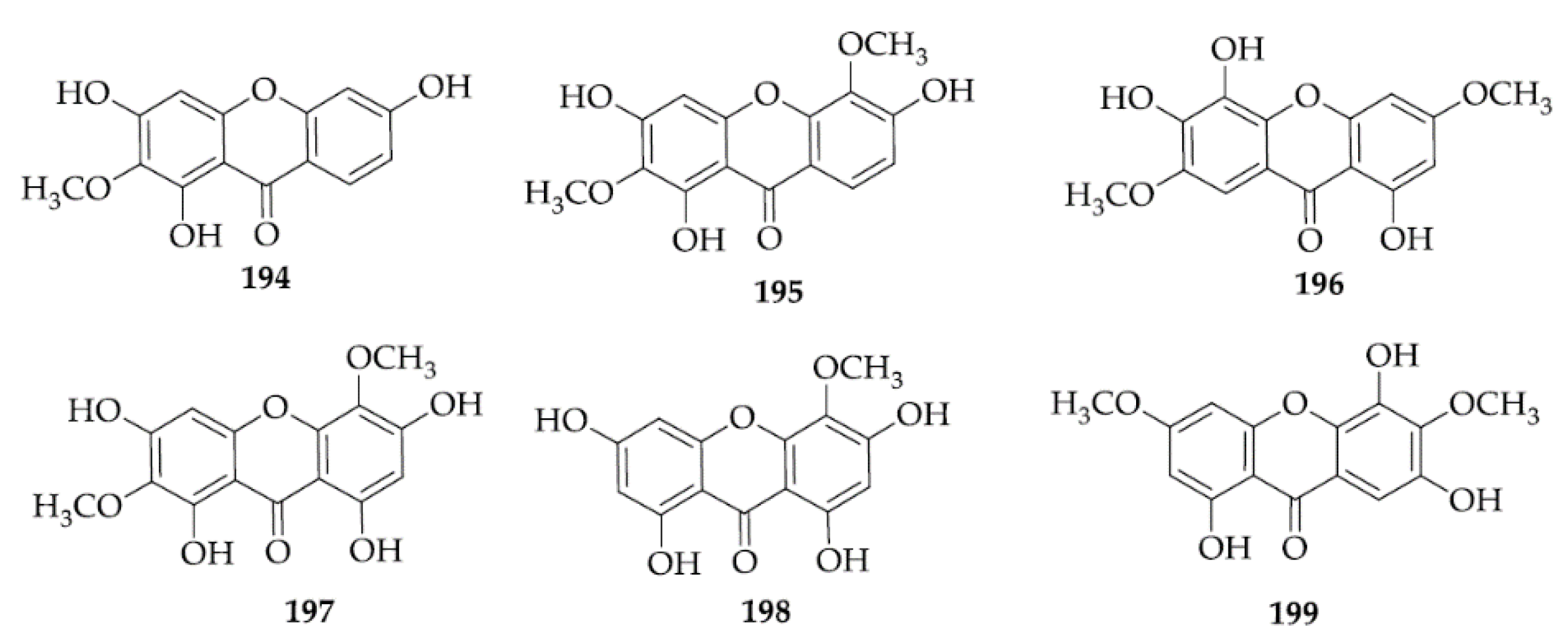
Qiao et al. (2012), studying the chemical constituents of a Chinese herbal medicine Gu-Jing-Cao (Eriocaulon buergerianum) to identify adulterating species by HPLC-DAD-ESI-MSn, identified xanthone 191 and 192 in E. faberi, 195 in E. buergerianum, and 200 in E. cinereum and E. faberi. The xanthone 193 was also found, but the authors did not specify in which species [67].
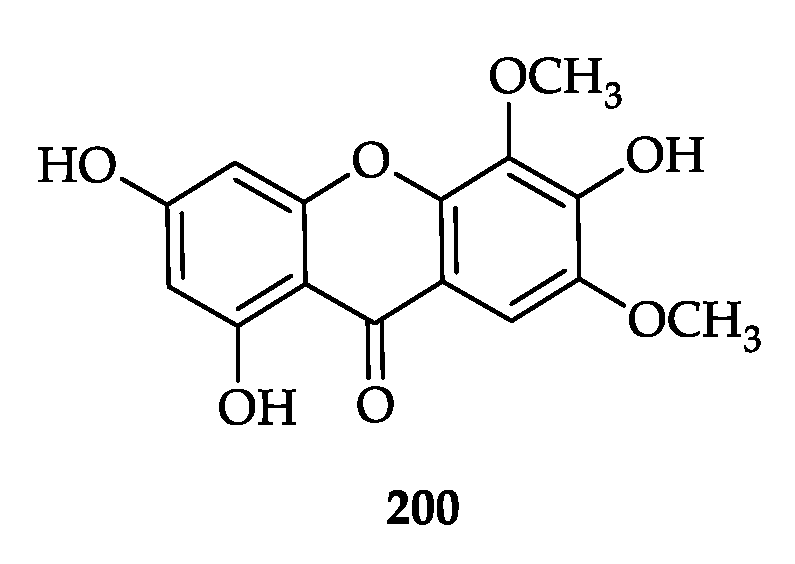
Liang et al. (2018) isolated 192 and 201 from Eriocaulon buergerianum vines and both xanthones showed significant fatty acid synthase inhibition activity with half inhibitory concentration values of 12.5 and 13.6 μM, respectively [54].
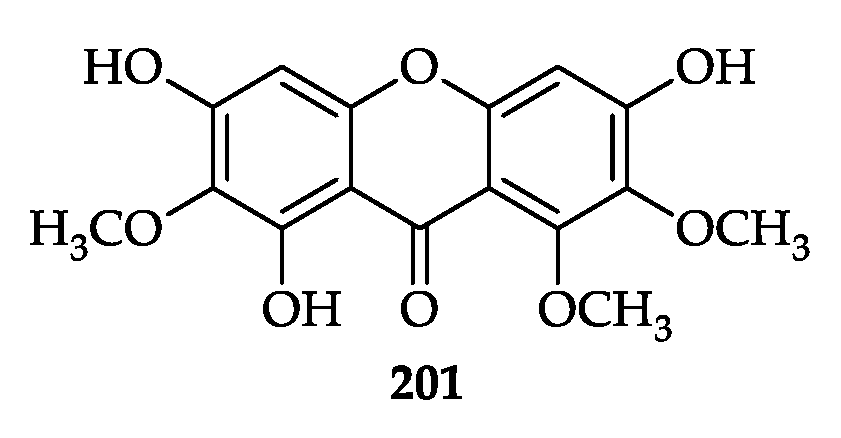
Table 4 shows the names of xanthones, the part of the plant where they were isolated, species, and authors.

Table 4.
Xanthones isolated in Eriocaulaceae species.
Table 4.
Xanthones isolated in Eriocaulaceae species.
| Compounds | MF | [M−H]− | Organ | Species | Reference |
|---|---|---|---|---|---|
| 8-carboxymethyl-1,6-dihydroxy-3,5-dimethoxyxanthone (188) | C17H14O8 | 345 | Capitula | Leiothrix curvifolia | [40] |
| 8-carboxymethyl-1,5,6-trihydroxy-3-methoxyxanthone (189) | C16H12O8 | 331 | Capitula | L. curvifolia | [40] |
| 8-carboxymethyl-1,3,5,6-tetrahydroxyxanthone (190) | C15H10O8 | 317 | Capitula | L. flavescens | [40] |
| 1,3,6-trihydroxy-2,5,7-trimethoxyxanthone (191) | C16H14O8 | 333 | whole plant | Eriocaulon buergerianum | [53] |
| Capitula, seeds | E. faberi | [67] | |||
| 1,3,6,8-tetrahydroxy-2,7-dimethoxyxanthone (192) | C15H12O8 | 319 | whole plant | E. buergerianum | [53] |
| vines | E. buergerianum | [54] | |||
| 1,3,6,8-tetrahydroxy-2-methoxyxanthone (193) | C14H10O7 | 289 | whole plant | E. buergerianum | [53] |
| flowers | Syngonanthus nitens | [57] | |||
| - | - | [67] | |||
| 1,3,6-trihydroxy-2-methoxyxanthone (194) | C14H10O6 | 273 | flowers | S. nitens | [57] |
| flowers | Syngonanthus ssp. | [63] | |||
| 1,3,6-trihydroxy-2,5-dimethoxyxanthone (195) | C15H12O7 | 303 | flowers | S. nitens | [57] |
| flowers | Syngonanthus ssp. | [63] | |||
| Capitula, seeds | E. buergerianum | [67] | |||
| Capitula, seeds | E. cinereum | [67] | |||
| Capitula, seeds | E. faberi | [67] | |||
| 3,4,8-trihydroxy-2,6-dimethoxyxanthone (196) | C15H12O7 | 303 | flowers | S. nitens | [57] |
| 1,3,6,8-tetrahydroxy-2,5-dimethoxyxanthone (197) | C15H12O8 | 319 | flowers | S. nitens | [57] |
| flowers | Syngonanthus ssp. | [63] | |||
| 1,3,6,8-tetrahydroxy-5-methoxyxanthone (198) | C14H10O7 | 289 | flowers | Syngonanthus ssp. | [63] |
| 1,5,7-trihydroxy-3,6-dimethoxyxanthone (199) | C15H12O7 | 303 | Capitula | S. nitens | [33] |
| flowers | Syngonanthus ssp. | [63] | |||
| 1,3,6-trihydroxy-5,7-dimethoxyxanthone (200) | C15H12O7 | 303 | Capitula, seeds | E. cinereum | [67] |
| Capitula, seeds | E. faberi | [67] | |||
| 1,3,6-trihydroxy-2,7,8-trimethoxyxanthone (201) | C16H14O8 | 333 | vines | E. buergerianum | [54] |
MF = molecular formula.
2.1.5. Saponins
Saponins are bioorganic compounds with at least one glycosidic linkage at C-3. The aglycone portion, called genin, sapogenin, or aglycone, may be composed of triterpenoid, steroid, or alkaloid. Triterpenoid saponin kind is the most widely distributed skeleton in the plant kingdom. The glycoside moiety may be composed of both hexoses and pentoses with different conformations. The lipophilic and hydrophilic composition of saponins confer a surfactant action, making saponins a class of metabolites with economic importance. The literature describes saponins’ biologic activities such as antibacterial, antitumoral, antifungal, anti-inflammatory, antiviral, insecticidal, etc. [98].
Zanatta et al. (2018) conducted the first study on the chemical composition and biological activity of the aerial parts of Actinocephalus divaricatus [79]. To make a fingerprint of methanolic extract, the authors chose to use a dereplication approach based on Liquid Chromatography coupled to High-Resolution Mass Spectrometry (HPLC-ESI-HRMSMS) as an analytical tool for the screening and structural determination.
Eight saponins were identified based on the fragmentation pattern and compared to literature data. The saponins 202–209 were identified in Actinocephalus divaricatus scapes and 204–208 in the leaves. A known nortriterpenoid saponin 3-O-β-D-glucuronopyranosyl-30-norolean-12,20(29)-dien-28-O-β-D-glucopyranosyl ester (205) was isolated and had its structure determined by MS/MS and NMR experiments and the data were compared with those published in the literature. Besides the mentioned compounds, others were identified but they could not be drawn.
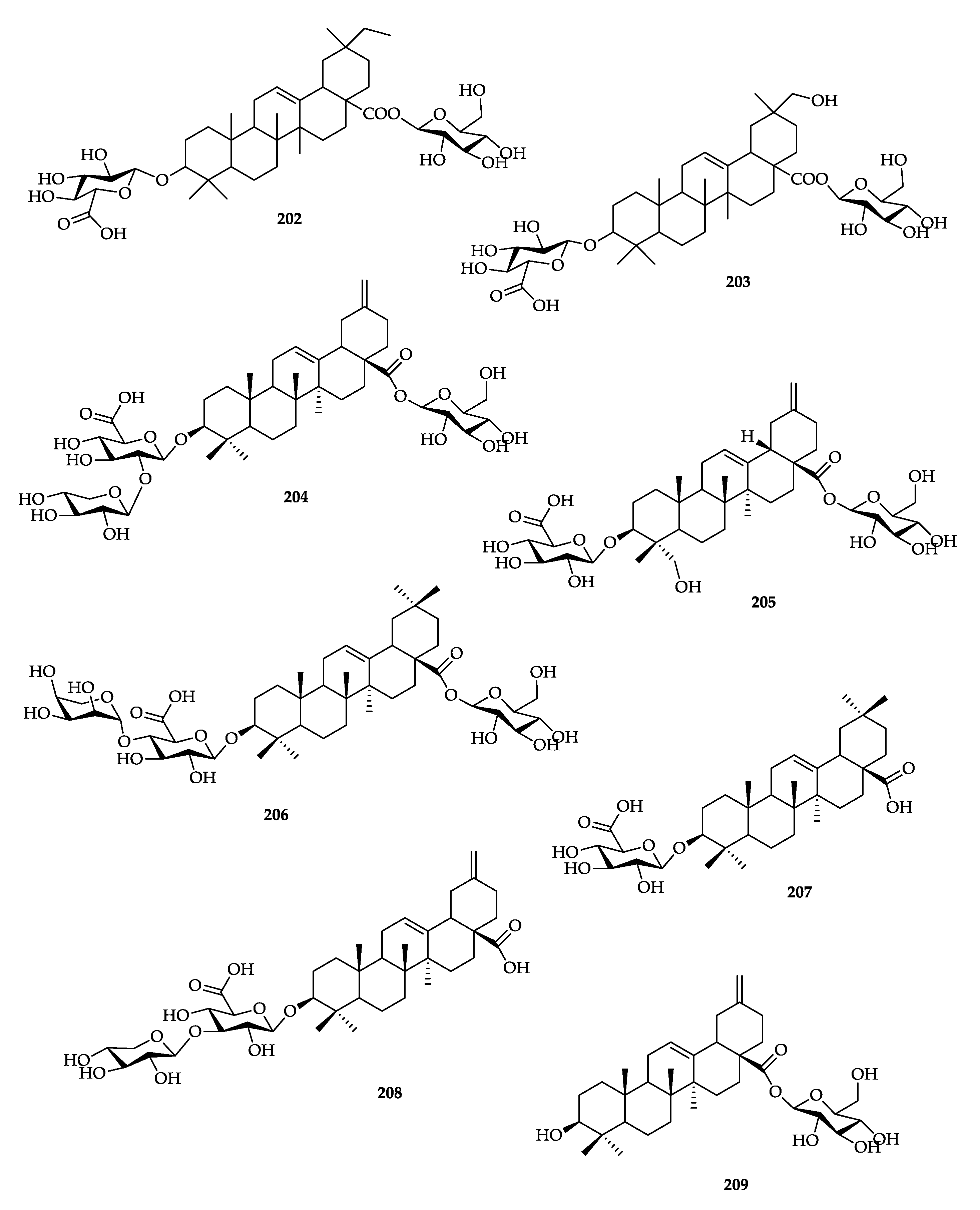
Table 5 shows the names of saponins, the part of the plant where they were isolated, species, and authors.

Table 5.
Saponins isolated from Eriocaulaceae species.
Table 5.
Saponins isolated from Eriocaulaceae species.
| Compounds | MF | [M−H]− | Organ | Species | Reference |
|---|---|---|---|---|---|
| 3-O-glucuronide oleanolic acid-28-O-hexose (202) | C42H66O14 | 793 | Scapes | Actinocephalus divaricatus | [79] |
| 3-O-glucuronide-29-hydroxyoleanolic acid-28-O-hexose esther (203) | C42H66015 | 809 | Scapes | A. divaricatus | [79] |
| 3-O-[pentose-(1→3)-O-glucuronide]-30-norolean-12,20(29)-dien-28-O-hexose ester (204) | C46H70O18 | 909 | Scapes, leaves | A. divaricatus | [79] |
| 3-O-glucuronopyranosyl-30-norolean-12,20(29)-dien-28-O-glucopyranosyl ester (205) | C41H62015 | 793 | Scapes, leaves | A. divaricatus | [79] |
| 3-O-[pentose-(1→4)-glucuronide] oleanolic acid-28-O-hexose (206) | C47H74O18 | 925 | Scapes, leaves | A. divaricatus | [79] |
| 3-O-glucuronide oleanolic acid (207) | C36H56O9 | 631 | Scapes, leaves | A. divaricatus | [79] |
| 3-O-pentose-(1→3)-O-glucuronide-30-norolean-12,20(29)-dien-28-oic acid (208) | C40H60O13 | 747 | Scapes, leaves | A. divaricatus | [79] |
| 30-norolean-12,20(29)-dien-28-O-hexose ester (209) | C35H54O8 | 601 | Scapes | A. divaricatus | [79] |
MF = molecular formula.
2.1.6. Steroids
Steroids are complex lipophilic four-ringed organic molecules that act in the body to regulate cellular, tissue, and organ functions [99].
In 2008, Song et al. [100] described for the first time a phytochemical study on Eriocaulon sieboldianum (Eriocaulaceae), an aquatic annual herb of Korea, Japan, China, and Africa. Three stigmastane-skeleton sterols were isolated from the ethyl acetate soluble fraction of whole plant and the chemical structures were determined by spectroscopic and spectrometric techniques as IR, MS, and NMR. The isolated compounds were identified as one new compound, stigmasta-7,22-dien-3β,4β-diol (210), and two known compounds, stigmasterol 3-O-β-D-glucopyranoside (211) and stigmasta-5-en-3β-ol (β -sitosterol, 212).

Table 6 shows the names of steroids, the part of the plant where they were isolated, species, and authors.

Table 6.
Steroids isolated from Eriocaulaceae species.
Table 6.
Steroids isolated from Eriocaulaceae species.
| Compounds | MF | [M−H]− | Organ | Species | Reference |
|---|---|---|---|---|---|
| Stigmasta-7,22-dien-3β,4β-diol (210) | C29H48O2 | 427 | whole plant | Eriocaulon sieboldianum | [100] |
| stigmasterol 3-O-β-D-glucopyranoside (211) | C35H58O6 | 573 | whole plant | E. sieboldianum | [100] |
| β-sitosterol (212) | C29H50O | 413 | whole plant | E. sieboldianum | [100] |
MF = molecular formula.
2.1.7. Quinones
Quinones are a large class of natural organic compounds and may be divided into three main groups: benzoquinone, naphthoquinone, and anthraquinone, with this last group as the most common cycle. Currently, more than 2000 quinones are known in nature, found in fungi, lichens, gymnosperms, and angiosperms. In families such as Rubiaceae, Fabaceae, and Boraginaceae, isolating quinones is very common [25], but according to the literature, only two quinones were isolated in Eriocaulaceae.
Kitagawa et al. (2004) [101] isolated for the first time the naphthoquinone 5-methoxy-3,4-dehydroxanthomegnin (213) from Paepalanthus latipes capitula methylene chloride extract. The cytotoxic evaluation showed a significant cytotoxic index of 35.8 mg mL−1 when compared with cisplatin (IC50 41.9 mg mL−1), a cytotoxic substance used in antineoplasic therapy. Kitagawa carried out other biological assessment tests over the years, such as antitumor, immunomodulatory [102], antioxidant, anti-helicobacter pylori activity [103], and mutagenic [104].
In 2008, Fang and co-workers isolated, from an ethyl acetate fraction of the whole Eriocaulon buergerianum, the anthraquinone emodin (214). An antibacterial assay performed with the standard Staphylococcus aureus strain (ATCC 25923) showed a MIC 32 µg mL−1 [53].
Qiao et al. (2012) identified quinone 215 in a Chinese herbal medicine Gu-Jing-Cao (Eriocaulon buergerianum) by analyzing m/z obtained HPLC-DAD-ESI-MSn [67].

Table 7 shows the names of anthraquinone, the part of the plant where they were isolated, species, and authors.

Table 7.
Quinones isolated from Eriocaulaceae species.
Table 7.
Quinones isolated from Eriocaulaceae species.
| Compounds | MF | [M−H]− | Organ | Species | Reference |
|---|---|---|---|---|---|
| 5-methoxy-3,4-Dehydroxanthomegnin (213) | C16H12O7 | 315 | Capitula | Paepalanthus latipes | [101] |
| Emodin (214) | C15H10O5 | 269 | whole plant | Eriocaulon buergerianum | [53] |
| (R)-Semixanthomegnin (215) | C15H12O6 | 287 | Capitula/seeds | E. buergerianum | [67] |
MF = molecular formula.
2.1.8. Phenolic Acid Derivatives
Phenolic or phenolcarboxylic acids are one of the main classes of plant phenolic compounds. They are found in a variety of plants and are mainly divided into two sub-groups: hydroxybenzoic and hydroxycinnamic acid. Phenolic acids are known for diverse biological applications such as antidiabetic, anticancer, neuro protective, and food preservative and skin care products [105].
Studying the whole plant of Eriocaulon buergerianum, Fang et al. (2008) isolated from different sub-fractions of ethyl acetate extract the phenolics vanillic acid (216, 190.0 mg), ferulic acid (217, 20.0 mg), and protocatechuic acid (218, 140 mg). All were isolated with a silica gel column or polyamide chromatography and elucidated by spectroscopic techniques. Additionally, they were tested against the pathogenic bacteria Staphylococcus aureus (ATCC 25923). As a result, 218 showed a MIC of 32 µg mL−1, 222 of 64 µg mL−1, and 217 of 256 µg mL−1 [53].
In 2012, studying the same species, Qiao et al. identified 216, 218, and caffeic acid (219) from the 70% methanol extract by HPLC-DAD-ESI-MSn [67].

One colorless and amorphous caffeic acid derivative, 3-di-E-caffeoylglycerol 220, was isolated from the ethanolic extract of Paepalanthus microphyllus capitula. The structure of 220 was characterized by spectroscopic and spectrometry methods [46].

The methanolic extract from Leiothrix flavescens capitula was partitioned with EtOAc and submitted to separation by HSCCC. Afterwards, a fraction was chromatographed with Sephadex LH-20 to yield 1,3-O-diferuloilglicerol 221. The structure of 221 was characterized by spectroscopic and spectrometry methods [106].

Table 8 shows the names of phenolic acids derivatives, the part of the plant where they were isolated, species, and authors.

Table 8.
Phenolic acids derivatives isolated from Eriocaulaceae species.
Table 8.
Phenolic acids derivatives isolated from Eriocaulaceae species.
| Compounds | MF | [M−H]− | Organ | Species | Reference |
|---|---|---|---|---|---|
| Vanillic acid (216) | C8H8O4 | 167 | whole plant | Eriocaulon buergerianum | [53] |
| Capitula, seeds | E. buergerianum | [67] | |||
| Ferulic acid (217) | C10H10O4 | 193 | whole plant | E. buergerianum | [53] |
| Protocatechuic acid (218) | C7H6O4 | 153 | whole plant | E. buergerianum | [53] |
| Capitula, seeds | E. buergerianum | [67] | |||
| Caffeic acid (219) | C9H8O4 | 180 | Capitula, seeds | E. buergerianum | [67] |
| 3-di-E-caffeoylglycerol (220) | C21H20O9 | 415 | Capitula | Paepalanthus microphyllus | [67] |
| 1,3-O-diferuloilglicerol (221) | C23H24O9 | 443 | Capitula | Leiothrix flavescens | [67] |
MF = molecular formula.
2.1.9. Tocopherol
The EtOAc fraction of Eriocaulon buergerianum Koern. capitula was chromatographed in a silica gel column. A fraction after the mentioned procedure was separated by MPLC to yield γ-tocopheryl acetate 222. The structure of 222 was established by spectral methods [44].

2.2. Ligand-Based Virtual Screening
The Random Forest algorithm (RF) models were generated following the five-fold cross validation procedure [107,108]. Table 9 shows the statistical performances for each model.

Table 9.
Summary of the parameters of the results obtained in the RF models.
The performance characteristics of the nine models created revealed their predictive power and reliability, and the Receiver Operating Characteristic (ROC) curve and Matthews Correlation Coefficient (MCC) gave information on their performance and robustness.
The Eriocaulaceae dataset with a total of 222 compounds was reduced to 206 molecules (16 structures with undefined sugar units were removed for virtual screening analysis) and analyzed in each model.
In each model, we analyzed the applicability domain (APD) for each molecule to consider its prediction, that is, molecules within the APD of the model have reliable predictions and outside the APD have unreliable predictions. Table 10 shows a summary of how many molecules were inside the APD of each model, and how many of these molecules have an active potential prediction against parasites that cause neglected diseases.

Table 10.
Prediction information.
Table 11 shows that for the model against Trypanosoma cruzi parasitic form Trypomastigote, no molecule that remained inside the APD showed active potential. In the T. cruzi—amastigote model only two molecules were predicted to be active out of the 158 molecules that were inside the APD and in the Leishmania infantum—amastigote model only eight molecules were predicted to be active out of the 200 that were inside the APD.

Table 11.
Five molecules with the highest active potential probability of each model.
The Leishmania infantum—promastigote model had the highest active prediction potential, with molecules reaching a 96% probability of being active. Table 11 shows the five molecules with the highest active potential for the models created.
Analyzing the predictions of molecules isolated from Eriocaulaceae, we can observe that some molecules have multitarget potential, capable of being active for different parasites.
Molecules 194 and 196, xanthones, were shown to have active potential probability against Aedes aegypti (larvicidal activity), Schistosoma mansoni, Leishmania amazonensis (promastigote), Leishmania infantum (promastigote), Trypanosoma cruzi (amastigote). Molecule 194 also has active potential against L. amazonensis (amastigote) and 196 against T. cruzi (epimastigote).
The xanthone 200 and the saponin 202 have very similar multitarget active potential probability against L. amazonensis (promastigote), L. infantum (amastigote and promastigote), and Ae. aegypti (larvicidal activity).
Among these four molecules identified with multitarget potential, the most promising one, which has the highest probability of active potential, is xanthone 194. Table 12 shows the molecules with multitarget potential and their respective probabilities of active potential.

Table 12.
Molecules with multitarget potential and their respective active potential probabilities.
3. Materials and Methods
3.1. Database
A selection of data was made by a search in Scifinder®, ScienceDirect, Scielo, Web of ScienceTM, and Scopus® databases by the Portal de Periódicos CAPES website. About 70 articles were found about isolated and/or identified compounds from 1969 to 2022. As a keyword were used “Eriocaulaceae”, “Eriocaulaceae compounds”, “Flavonoids of Eriocaulaceae”, “Naphtopyranones of Eriocaulaceae”, and the genus plus “compounds”.
3.2. Dataset
Five sets of chemical structures with known activity for Schistosoma mansoni, Leishmania infantum, Leishmania amazonensis, Trypanosoma cruzi, and Aedes aegypti were selected from the ChEMBL database [109,110,111], for the construction of the nine predictive model. Table 13 shows the information about each dataset.

Table 13.
ChEMBL databases.
The dataset built in this review with compounds isolated from Eriocaulaceae was used to predict the potential activity against neglected diseases.
For all structures, SMILES (Simplified Molecular Input Line Entry System) codes were used as input data for Marvin 18.10.0, 2018 (ChemAxon) [112] and Standardizer software (JChem 18.10.0, 2018; ChemAxon) [112] to convert the chemical structures into curated and canonical representations. This standardization is of paramount importance to create consistent compound libraries and is done by the following steps: addition of hydrogens, aromatization, generation of 3D structure, and exporting the compounds in SDF format. For a more detailed description on how the dataset was curated, please refer to the workflows described by Fourches et al. [113,114,115].
3.3. DRAGON 7.0 Descriptors
Molecular descriptors are used to calculate the physicochemical properties of the molecules from each molecule set. To obtain the molecular descriptors, the DRAGON 7.0 program [116] was used. The DRAGON 7.0 software can calculate 5270 molecular descriptors, covering various approaches. These molecular descriptors are arranged in 30 logical blocks [116].
3.4. Random Forest Model
The KNIME 4.4.0 software (KNIME version number 4.4.0, the Konstanz Information Miner Copyright, 2003–2021, Zurich, Switzerland) [117] was used to perform the analyses and to generate the in silico model. Datasets of molecules, along with their calculated descriptors and class variables, were imported from DRAGON 7.0 software. Each dataset was divided using the “partitioning” tool, with the “stratified sample” option, to create a training set and an external test set, which represented 80% and 20% of the compounds, respectively. Although the compounds were selected randomly, the same proportion of active and inactive samples was maintained in both sets.
For external validation, we employed five-fold cross-validation [107,108] using randomly selected, stratified groups, meaning that the entire data set was partitioned five times into a modeling set (training set) including 80% of the compounds in the set, and the external cross validation data set, comprising the remaining 20% of the compounds in the data set. After this, only the modeling set was used to build the models and then the models were validated with the external cross validation technique. Descriptors were selected and modeled following a five-fold external cross validation procedure using the RF [107,108]. A total of 100 parameters were selected for RF for all generated models, which is the number of trees constructed, and 1550953075932 seeds generated random numbers for the model.
By using KNIME nodes, the most important descriptors in generating each prediction model were evaluated. The external performances of the selected models were analyzed for sensitivity (true positive rate, i.e., active rate), specificity (true negative rate, i.e., inactive rate), and accuracy (overall predictability). The positive (PPV) and negative (NPV) predictive values inform us about the probability of predicted positives (PPV) and negatives (NPV) being the true positives and negatives, respectively. The sensitivity and specificity of the ROC curve were also found to describe true performance with more clarity than accuracy.
The model was also analyzed by the Matthews coefficient, a way to evaluate the model globally from the results obtained from the confusion matrix. The MCC is a correlation coefficient between observed and predictive binary classifications. It results in a value between −1 and +1, where a coefficient of +1 represents a perfect forecast, 0 is a random forecast, and −1 indicates total disagreement between forecast and observation [118].
The MCC can be calculated from the following formula:
where VP is the true positive value, VN is the true negative value, FP is the value of false positives, and FN is the value of false negatives.
The APD was used to analyze the compounds of the test sets to evaluate whether their predictions were reliable. The APD is based on Euclidean distances, and similarity measures between the descriptors of the training set are used to define the applicability domain. Thus, if a test set compound has distances and similarity beyond this limit, its prediction is unreliable.
The APD calculation is performed by using the formula:
where d and σ are the Euclidean distances and the standard mean deviation, respectively, of the compounds in the training set. Z is an empirical cut-off value. In this work, the Z value used was 0.5 [119,120].
APD = d + Zσ
4. Conclusions
Eriocaulaceae, a pantropical family, comprises around 1200 species divided in 10 genera. Eriocaulon, its largest genus, comprising about 478 species, has 13 species phytochemically studied and Paepalanthus, the second largest genus, comprising about 400 species, has 26 studied species. As far we know, 130 flavonoids were isolated in 57 species divided into Eriocaulon, Paepalanthus, Syngonanthus, and Leiothrix genera; 36 naphthopyranones were isolated in 27 species from Eriocaulon, Paepalanthus, and Actinocephalus; 21 compounds were derivative from Paepalanthus fungi; 14 xanthones were isolated in six species from Eriocaulon, Syngonanthus, and Leiothrix; eight saponins from Actinocephalys divaricatus; three steroids from Eriocaulon sieboldianum; three quinones from Eriocaulon buergerianum and Paepalanthus latipes; six phenolic acid derivatives from Eriocaulon buergerianum, Paepalanthus microphyllus, and Leiothrix flavescens, and finally, one tocopherol derivative from Eriocaulon buergerianum.
Many of these compounds had their in vitro biological activities tested, and their mutagenic, antimicrobial, antioxidant, anti-inflammatory, antitumor, and other activities were confirmed.
The computational study showed that the molecules isolated from the Eriocaulaceae family have active potential against neglected diseases: leishmaniasis, schistosomiasis, Chagas disease, and dengue fever. Finding promising molecules with multitarget potential, which were xanthones 194, 196, and 200 and saponin 202, was also possible, with xanthone 194 as the most promising of them.
These data present the relevance of this review, which shows the structural variation of the compounds isolated in the family and in vitro and in vivo biological activities carried out so far and highlights the possibility of new compounds being known, given the number of species that have not been chemically studied. In addition, the chemical and biological knowledge of a species can contribute to the preservation of the species, an important fact, since many Eriocaulaceae species are at risk of extinction.
Author Contributions
Conceptualization, investigation, data curation, formal analysis, methodology, and writing—original draft preparation: L.L.P.F.M. and R.P.B.d.M.; software and validation: R.P.B.d.M.; writing—review and editing: L.S., M.T.S. and W.d.S.B.; supervision: M.T.S., V.L.J. and W.d.S.B.; resources: V.L.J. and W.d.S.B.; project administration: M.T.S. and W.d.S.B. All authors have read and agreed to the published version of the manuscript.
Funding
This research was funded by Conselho Nacional de Desenvolvimento Científico e Tecnológico—CNPq, grant number 140164/2020-0, Coordenação de Aperfeiçoamento de Pessoal de Nível Superior—CAPES, grant number 001, Fundação de Amparo à Pesquisa e Inovação do Espírito Santo—FAPES and Universidade Federal do Espírito Santo—UFES.
Institutional Review Board Statement
Not applicable.
Informed Consent Statement
Not applicable.
Data Availability Statement
Not applicable.
Conflicts of Interest
The authors declare no conflict of interest.
References
- Amorim, M.R.; Rinaldo, D.; Amaral, F.P.; Vilegas, W.; Magenta, M.A.G.; Vieira, G.M., Jr.; Santos, L.C. HPLC-DAD based method for the quantification of flavonoids in the hydroethanolic extract of Tonina fluviatilis Aubl. (Eriocaulaceae) and their radical scavenging activity. Quim. Nova 2014, 37, 1122–1127. [Google Scholar] [CrossRef]
- Giulietti, A.M.; Amaral, M.C.E.; Bittrich, V. Phylogenetic Analysis of Inter and Infrageneric Relationships of Leiothrix Ruhland (Eriocaulaceae). Kew Bull. 1995, 50, 55–71. [Google Scholar] [CrossRef]
- Giulietti, A.M.; Andrade, M.J.G.; Scatena, V.L.; Trovó, M.; Coan, A.I.; Sano, P.T.; Santos, F.A.R.; Borges, R.L.B.; van den Berg, C. Molecular Phylogeny, Morphology and Their Implications for the Taxonomy of Eriocaulaceae. Rodriguésia 2012, 63, 1–19. [Google Scholar] [CrossRef]
- Freitas, H.M.V.; Trovó, M. Eriocaulaceae da Região Serrana do Estado do Rio de Janeiro, Brasil. Rodriguesia 2017, 68, 749–757. [Google Scholar] [CrossRef]
- Sano, P.T.; Andrino, C.O.; Chagas, E.C.O.; Costa, F.N.; Echternacht, L.; Hensold, N.; Oliveira, A.L.R.; Parra, L.R.; Ramos, R.; Sauthier, L.J.; et al. Eriocaulaceae. Available online: http://floradobrasil.jbrj.gov.br/reflora/floradobrasil/FB110 (accessed on 18 January 2022).
- Chagas, E.C.O.; Oliveira, A.L.R.; Giulietti, A.M. Eriocaulon. Available online: http://floradobrasil.jbrj.gov.br/reflora/floradobrasil/FB7516 (accessed on 18 January 2022).
- Giulietti, A.M.; Hensold, N. Padrões de Distribuição Geográfica dos Gêneros de Eriocaulaceae. Acta Bot. Bras. 1990, 4, 133–158. [Google Scholar] [CrossRef]
- Oliveira, A.L.R.; Bove, C.P. Eriocaulon albosetaceum: A New Species of Eriocaulaceae from the Brazilian Cerrado. J. Plant Taxon. Geogr. 2019, 74, 15–21. [Google Scholar] [CrossRef]
- Costa, F.N.; Andrino, C.O.; Sano, P.T.; Trovó, M.; Echternacht, L. Paepalanthus (Eriocaulaceae) in the Central Espinhaço Range in Minas Gerais, Brazil: Checklist, Endemism, and Nomenclatural Changes. Phytotaxa 2018, 367, 133–144. [Google Scholar] [CrossRef]
- Forzza, R.C.; Leitman, P.M.; Costa, A.; Carvalho, A.A., Jr.; Peixoto, A.L.; Walter, B.M.T.; Bicudo, C.; Zappi, D.; Costa, D.P.; Lleras, E.; et al. Catálogo de Plantas e Fungos do Brasil—Volume 1; Instituto de Pesquisa Jardim Botânico do Rio de Janeiro: Rio de Janeiro, Brazil, 2010; ISBN 9788560035083. [Google Scholar]
- Andrino, C.O.; Sano, P.T.; Costa, F.N.; Echternacht, L.; Sauthier, L.J.; Hensold, N.; Ramos, R.; Tissot-Squalli, M.; Trovó, M. Paepalanthus. Available online: http://floradobrasil.jbrj.gov.br/reflora/floradobrasil/FB7558 (accessed on 18 January 2022).
- Newman, D.J.; Cragg, G.M. Natural Products as Sources of New Drugs over the Nearly Four Decades from 01/1981 to 09/2019. J. Nat. Prod. 2020, 83, 770–803. [Google Scholar] [CrossRef]
- Barros, R.P.C.; Scotti, L.; Scotti, M.T. Exploring Secondary Metabolites Database of Apocynaceae, Menispermaceae, and Annonaceae to Select Potential Anti-HCV Compounds. Curr. Top. Med. Chem. 2019, 19, 900–913. [Google Scholar] [CrossRef] [PubMed]
- Mao, J.; Akhtar, J.; Zhang, X.; Sun, L.; Guan, S.; Li, X.; Chen, G.; Liu, J.; Jeon, H.; Kim, M.S.; et al. Comprehensive Strategies of Machine-Learning-Basedquantitative Structure-Activity Relationship Models. iScience 2021, 24, 103052. [Google Scholar] [CrossRef] [PubMed]
- Du, Q.-S.; Huang, R.-B.; Chou, K.-C. Recent Advances in QSAR and Their Applications in Predicting the Activities of Chemical Molecules, Peptides and Proteins for Drug Design. Curr. Protein Pept. Sci. 2008, 9, 248–259. [Google Scholar] [CrossRef] [PubMed]
- Quadri, T.W.; Olasunkanmi, L.O.; Fayemi, O.E.; Akpan, E.D.; Verma, C.; Sherif, E.S.M.; Khaled, K.F.; Ebenso, E.E. Quantitative Structure Activity Relationship and Artificial Neural Network as Vital Tools in Predicting Coordination Capabilities of Organic Compounds with Metal Surface: A Review. Coord. Chem. Rev. 2021, 446, 2–27. [Google Scholar] [CrossRef]
- Hotez, P.J.; Bottazzi, M.E.; Franco-Paredes, C.; Ault, S.K.; Periago, M.R. The Neglected Tropical Diseases of Latin America and the Caribbean: A Review of Disease Burden and Distribution and a Roadmap for Control and Elimination. PLoS Negl. Trop. Dis. 2008, 2, e300. [Google Scholar] [CrossRef] [PubMed]
- Meireles, C.B.; Maia, L.C.; Soares, G.C.; Teodoro, I.P.P.; do Gadelha, M.S.V.; da Silva, C.G.L.; de Lima, M.A.P. Atypical Presentations of Cutaneous Leishmaniasis: A Systematic Review. Acta Trop. 2017, 172, 240–254. [Google Scholar] [CrossRef] [PubMed]
- Acharya, A.S.; Kaur, R.; Goel, A.D. Neglected Tropical Diseases—Challenges and Opportunities in India. Indian J. Med. Spec. 2017, 8, 102–108. [Google Scholar] [CrossRef]
- WHO. Schistosomiasis. Available online: https://www.who.int/en/news-room/fact-sheets/detail/schistosomiasis (accessed on 9 February 2022).
- WHO. Schistosomiasis: Progress Report 2001–2011 and Strategic Plan 2012–2020; WHO: Geneva, Switzerland, 2013.
- Dokkedal, A.L.; Santos, L.C.; Sano, P.T.; Vilegas, W. Chemistry in Eriocaulaceae. Z. Nat. 2008, 63, 169–175. [Google Scholar] [CrossRef]
- Vilegas, W.; Dokkeddal, A.L.; Piacente, S.; Rastrelli, L.; Pizza, C. New Naphthopyranone Glycosides from Paepalanthus vellozioides and Paepalanthus latipes. J. Nat. Prod. 1999, 62, 746–749. [Google Scholar] [CrossRef]
- Vilegas, W.; Nehme, C.J.; Dokkeddal, A.L.; Piacente, S.; Rastrelli, L.; Pizza, C. Quercetagetin 7-Methyl Ether Glycosides from Paepalanthus vellozioides and Paepalanthus latipes. Phytochemistry 1999, 51, 403–409. [Google Scholar] [CrossRef]
- Simões, C.M.O.; Schenkel, E.P.; Mello, J.C.P.; Mentz, L.A.; Petrovick, P.R. Farmacognosia: Do Produto Natural ao Medicamento; Artmed: Porto Alegre, Brazil, 2017. [Google Scholar]
- Shi, X.; Niu, L.; Zhao, L.; Wang, B.; Jin, Y.; Li, X. The Antiallergic Activity of Flavonoids Extracted from Citri reticulatae pericarpium. J. Food Process. Preserv. 2018, 42, e13588. [Google Scholar] [CrossRef]
- Geethalakshmi, R.; Sarada, D.V.L. In Vitro and In Silico Antimicrobial Activity of Sterol and Flavonoid Isolated from Trianthema decandra L. Microb. Pathog. 2018, 121, 77–86. [Google Scholar] [CrossRef]
- Khan, H.; Perviz, S.; Sureda, A.; Nabavi, S.M.; Tejada, S. Current Standing of Plant Derived Flavonoids as an Antidepressant. Food Chem. Toxicol. 2018, 119, 176–188. [Google Scholar] [CrossRef] [PubMed]
- Bate-Smith, E.C.; Harbornet, J.B. Quercetagetin and Patuletin in Eriocaulon. Phytochemistry 1969, 8, 1035–1037. [Google Scholar] [CrossRef]
- Zhu, W.; Chunmei, L.V.; Wang, J.; Gao, Q.; Zhu, H.; Wen, H. Patuletin Induces Apoptosis of Human Breast Cancer SK-BR-3 Cell Line via Inhibiting Fatty Acid Synthase Gene Expression and Activity. Oncol. Lett. 2017, 14, 7449–7454. [Google Scholar] [CrossRef]
- Dokkedal, A.L.; Salatino, A. Flavonoids of Brazilian Species of Leiothrix (Eriocaulaceae). Biochem. Syst. Ecol. 1992, 20, 31–32. [Google Scholar] [CrossRef]
- Mayworm, M.A.S.; Salatino, A. Flavonoides de Quatro Espécies de Paepalanthus Ruhl. (Eriocaulaceae). Acta Bot. Bras. 1993, 7, 129–133. [Google Scholar] [CrossRef]
- Cardoso, C.A.L.; Zanutto, F.V.; Varanda, E.A.; Sano, P.T.; Vilegas, W.; Santos, L.C. Quantification of Flavonoids, Naphthopyranones and Xanthones in Eriocaulaceae Species by LC-PDA. Am. J. Anal. Chem. 2012, 03, 138–146. [Google Scholar] [CrossRef]
- Ricci, C.V.; Patricio, M.C.B.; Salatino, M.L.F.; Salatino, A.; Giulietti, A.M. Flavonoids of Syngonanthus Ruhl. (Eriocaulaceae): Taxonomic Implications. Biochem. Syst. End Ecol. 1996, 24, 577–583. [Google Scholar] [CrossRef]
- Andrade, F.D.P.; Santos, L.C.; Dokkedal, A.L.; Vilegas, W. Acyl Glucosylated Flavonols from Paepalanthus Species. Phytochemistry 1999, 51, 411–415. [Google Scholar] [CrossRef]
- Moreira, R.R.D.; Santos, L.E.; Varella, S.D.; Varanda, E.A.; Vilegas, W. Avaliação Da Atividade Mutagênica Do Extrato Etanólico Bruto de Paepalanthus latipes (Eriocaulaceae) e Dos Compostos Flavonoídicos 7-Metoxilados Relacionados. Rev. Bras. Farmacogn. 2002, 12, 11–19. [Google Scholar] [CrossRef][Green Version]
- Moreira, R.R.D.; Martins, G.Z.; Pietro, R.C.L.R.; Sato, D.N.; Pavan, F.R.; Leite, S.R.A.; Vilegas, W.; Leite, C.Q.F. Paepalanthus spp.: Antimycobacterial Activity of Extracts, Methoxylated Flavonoids and Naphthopyranone Fractions. Rev. Bras. Farmacogn. 2013, 23, 268–272. [Google Scholar] [CrossRef]
- Santos, L.C.; Andrade, F.D.P.; Vasconcelos, E.C.; Coelho, R.G.; Dokkedal, A.L.; Garcia, A.C.L.; Sano, P.T.; Vilegas, W. Separation of Flavonoids and Naphthopyranones from Four Brazilian Paepalanthus Species by Droplet Countercurrent Chromatography. Rev. Bras. Plantas Med. 1999, 2, 43–47. [Google Scholar]
- Santos, L.C.; Dachtler, M.; Andrade, F.D.P.; Albert, K.; Vilegas, W. Application of HPLC-NMR Coupling Using C30 Phase in the Separation and Identification of Flavonoids of Taxonomic Relevance. Fresenius J. Anal. Chem. 2000, 368, 540–542. [Google Scholar] [CrossRef]
- Santos, L.C.; Piacente, S.; Riccardis, F.; Eletto, A.M.; Pizza, C.; Vilegas, W. Xanthones and Flavonoids from Leiothrix curvifolia and Leiothrix flavescens. Phytochemistry 2001, 56, 853–856. [Google Scholar] [CrossRef]
- Dokkedal, A.L.; Sano, P.T.; Vilegas, W. Chemistry in Paepalanthus and Taxonomic Implications. Biochem. Syst. Ecol. 2004, 32, 503–504. [Google Scholar] [CrossRef]
- Santos, L.C.; Piacente, S.; Pizza, C.; Toro, R.; Sano, P.T.; Vilegas, W. 6-Methoxyquercetin-3-O-(6-E-Feruloyl)-β-D-Glucopyranoside from Paepalanthus polyanthus (Eriocaulaceae). Biochem. Syst. Ecol. 2002, 30, 451–456. [Google Scholar] [CrossRef]
- Andrade, F.; Rastrelli, L.; Pizza, C.; Sano, P.T.; Vilegas, W. Flavonol Glycosides and a Naphthopyranone Glycoside from Paepalanthus macropodus (Eriocaulaceae). Biochem. Syst. Ecol. 2002, 30, 275–277. [Google Scholar] [CrossRef]
- Ho, J.; Chen, C. Flavonoids from the Aquatic Plant Eriocaulon buergerianum. Phytochemistry 2002, 61, 405–408. [Google Scholar] [CrossRef]
- Silva, M.A. Estudo Químico e Biológico de Plantas da Família Eriocaulaceae. Ph.D. Thesis, Universidade Estadual Paulista “Júlio de Mesquita Filho” Instituto, São Paulo, Brazil, 2008. [Google Scholar]
- Santos, L.C.; Sannomiya, M.; Piacente, S.; Pìzza, C.; Sano, P.T.; Vilegas, W. Chemical Profile of the Polar Extract of Paepalanthus microphyllus (Guill.) Kunth (Eriocaulaceae). Rev. Bras. Ciências Farm. 2004, 40, 433–436. [Google Scholar] [CrossRef]
- Santos, L.C.; Rodrigues, C.M.; Silva, M.A.; Coelho, R.G.; Sannomiya, M.; Vilegas, W. Chemical Profile of Eriocaulon ligulatum (Vell.) L.B. Smith (Eriocaulaceae). Biochem. Syst. Ecol. 2005, 33, 1159–1166. [Google Scholar] [CrossRef]
- Santos, L.; Silva, M.A.; Rodrigues, C.M.; Rodrigues, J.; Rinaldo, D.; Sannomiya, M.; Vilegas, W. Fast Preparative Separation of Flavones from Capitula of Eriocaulon ligulatum (Vell.) L.B.Smith (Eriocaulaceae) by High-Speed Countercurrent Chromatography (HSCCC). Rev. Ciências Farm. Básica Apl. 2005, 26, 101–103. [Google Scholar]
- Coelho, R.G.; Batista, L.M.; Santos, L.C.; Brito, A.M.D.; Vilegas, W. Phytochemical Study and Antiulcerogenic Activity of Syngonanthus bisulcatus (Eriocaulaceae). Rev. Bras. Ciências Farm. 2006, 42, 413–417. [Google Scholar] [CrossRef]
- Dokkedal, A.L.; Lavarda, F.; Campaner, L.; Santos, L.C.; Vilegas, W. Xeractinol-A New Flavanonol C-Glucoside from Paepalanthus argenteus var. argenteus (Bongard) Hensold (Eriocaulaceae). J. Braz. Chem. Soc. 2007, 18, 437–439. [Google Scholar] [CrossRef]
- Silva, M.A.; Oliveira, A.P.S.; Sannomiya, M.; Sano, P.T.; Varanda, E.A.; Vilegas, W.S.L.C. Flavonoids and a Naphthopyranone from Eriocaulon ligulatum and Their Mutagenic Activity. Chem. Pharm. Bull. 2007, 55, 1635–1639. [Google Scholar] [CrossRef]
- Bosqueiro, A.L.D. Estudo Fitoquímico e Implicação Taxonômica Em Paepalanthus Mart. (Eriocaulaceae). Ph.D. Thesis, Universidade Estadual Paulista júlio de Mesquita Filho, Araraquara, Brazil, 2000. [Google Scholar]
- Fang, J.J.; Ye, G.; Chen, W.L.; Zhao, W.M. Antibacterial Phenolic Components from Eriocaulon buergerianum. Phytochemistry 2008, 69, 1279–1286. [Google Scholar] [CrossRef] [PubMed]
- Liang, Y.; Luo, D.; Gao, X.; Wu, H. Novel Fatty Acid Synthase Inhibitors Isolated from Eriocaulon buergerianum. Am. J. Pharm. 2018, 37, 1529–1563. [Google Scholar]
- Santos, L.C.; Silva, M.A.; Rodrigues, C.M.; Carbone, V.; Napolitano, A.; Bassarello, C.; Mari, A.; Piacente, S.; Pizza, C.; Vilegas, W. Characterization of Flavonoid and Naphthopyranone Derivatives from Eriocaulon ligulatum Using Liquid Chromatography Tandem Mass Spectrometry. Nat. Prod. Commun. 2009, 4, 1651–1656. [Google Scholar] [CrossRef]
- Silva, M.; Cardoso, C.A.; Vilegas, W.; Santos, L. High-Performance Liquid Chromatographic Quantification of Flavonoids in Eriocaulaceae Species and Their Antimicrobial Activity. Molecules 2009, 14, 4644–4654. [Google Scholar] [CrossRef]
- Pacifico, M.; Napolitano, A.; Masullo, M.; Hilario, F.; Vilegas, W.; Piacente, S.; Santos, L.C. Metabolite Fingerprint of “Capim Dourado” (Syngonanthus nitens), a Basis of Brazilian Handcrafts. Ind. Crops Prod. 2011, 33, 488–496. [Google Scholar] [CrossRef]
- Barroso, R.P.; Berlim, L.S.; Ito, A.S.; Costa-Filho, A.J. In Vitro Antioxidant Properties of Golden Grass (Syngonanthus nitens) by Electron Paramagnetic Resonance. Food Sci. Nutr. 2019, 7, 1353–1360. [Google Scholar] [CrossRef]
- Batista, L.M.; Almeida, A.B.A.; Morais Lima, G.R.; Sousa Falcão, H.; pietro Magri, L.; Luiz-Ferreira, A.; Santos, L.C.; Hiruma-Lima, C.A.; Vilegas, W.; Souza Brito, A.R.M. Gastroprotective Effects (in Rodents) of a Flavonoid Rich Fraction Obtained from Syngonanthus macrolepsis. J. Pharm. Pharmacol. 2014, 66, 445–452. [Google Scholar] [CrossRef]
- De Araújo, M.G.F.; Hilário, F.; Nogueira, L.G.; Vilegas, W.; dos Santos, L.C.; Bauab, T.M. Chemical Constituents of the Methanolic Extract of Leaves of Leiothrix spiralis Ruhland and Their Antimicrobial Activity. Molecules 2011, 16, 10479–10490. [Google Scholar] [CrossRef]
- Amaral, F.P.; Napolitano, A.; Masullo, M.; Santos, L.C.; Festa, M.; Vilegas, W.; Pizza, C.; Piacente, S. HPLC-ESIMSn Profiling, Isolation, Structural Elucidation, and Evaluation of the Antioxidant Potential of Phenolics from Paepalanthus geniculatus. J. Nat. Prod. 2012, 75, 547–556. [Google Scholar] [CrossRef] [PubMed]
- Xu, Q.; Xie, H.; Wu, P.; Wei, X. Flavonoids from the Capitula of Eriocaulon australe. Food Chem. 2013, 139, 149–154. [Google Scholar] [CrossRef] [PubMed]
- Oliveira, A.P.S.; Sousa, J.F.; Silva, M.A.; Hilário, F.; Resende, F.A.; Camargo, M.S.; Vilegas, W.; Santos, L.C.; Varanda, E.A. Estrogenic and Chemopreventive Activities of Xanthones and Flavones of Syngonanthus (Eriocaulaceae). Steroids 2013, 78, 1053–1063. [Google Scholar] [CrossRef]
- Zanutto, F.V.; Boldrin, P.K.; Varanda, E.A.; Souza, S.F.; Sano, P.T.; Vilegas, W.; Santos, L.C. Characterization of Flavonoids and Naphthopyranones in Methanol Extracts of Paepalanthus chiquitensis Herzog by HPLC-ESI-IT-MSn and Their Mutagenic Activity. Molecules 2013, 18, 244–262. [Google Scholar] [CrossRef] [PubMed]
- Ignácio, F.G. Estudo Químico e Biológico do Extrato Metanólico dos Capítulos de Paepalanthus acanthophyllus Ruhland (Eriocaulaceae). Master’s Thesis, Universidade Estadual Paulista, Araraquara, Brazil, 2016. [Google Scholar]
- Lee, I.J.; Chung, C.P.; Chang, S.J.; Lin, Y.L. Morphological and Chemical Analyses of Eriocauli flos Sold in Taiwan Markets. J. Food Drug Anal. 2017, 25, 939–945. [Google Scholar] [CrossRef] [PubMed]
- Qiao, X.; Ye, G.; Liu, C.F.; Zhang, Z.X.; Tu, Q.; Dong, J.; Li, Y.Q.; Guo, D.A.; Ye, M. Chemical Analysis of Eriocaulon buergerianum and Adulterating Species by High-Performance Liquid Chromatography with Diode Array Detection and Electrospray Ionization Tandem Mass Spectrometry. J. Pharm. Biomed. Anal. 2012, 57, 133–142. [Google Scholar] [CrossRef]
- Donner, C.D. Naphthopyranones-Isolation, Bioactivity, Biosynthesis and Synthesis. Nat. Prod. Rep. 2015, 32, 578–604. [Google Scholar] [CrossRef]
- Vilegas, W.; Roque, N.F.; Salatino, A.; Giesbrecht, A.M.; Davino, S. Isocoumarin from Paepalanthus bromeloioides. Phytochemistry 1990, 29, 2299–2301. [Google Scholar] [CrossRef]
- Varanda, E.A.; Raddi, M.S.G.; Dias, F.L.; Araújo, M.C.P.; Gibran, S.C.A.; Takahashi, C.S.; Vilegas, W. Mutagenic and Cytotoxic Activity of an Isocoumarin (Paepalantine) Isolated From Paepalanthus vellozioides. Teratog Carcinog Mutagen 1997, 17, 85–95. [Google Scholar] [CrossRef]
- Tavares, D.C.; Varanda, E.A.; Andrade, F.D.P.; Vilegas, W.; Takahashi, C.S. Evaluation of the Genotoxic Potential of the Isocoumarin Paepalantine in in Vivo and in Vitro Mammalian Systems. J. Ethnopharmacol. 1999, 68, 115–120. [Google Scholar] [CrossRef]
- Stasi, L.C.; Camuesco, D.; Nieto, A.; Vilegas, W.; Zarzuelo, A.; Galvez, J. Intestinal Anti-Inflammatory Activity of Paepalantine, an Isocoumarin Isolated from the Capitula of Paepalanthus bromelioides, in the Trinitrobenzenesulphonic Acid Model of Rat Colitis. Planta Med. 2004, 70, 315–320. [Google Scholar] [CrossRef] [PubMed]
- Damasceno, J.P.L.; Giuberti, C.S.; Gonçalves, R.C.R.; Kitagawa, R.R. Preformulation Study and Influence of DMSO and Propylene Glycol on the Antioxidant Action of Isocoumarin Paepalantine Isolated from Paepalanthus bromelioides. Rev. Bras. Farmacogn. 2015, 25, 395–400. [Google Scholar] [CrossRef]
- Vilegas, W.; Santos, L.C.; Alécio, A.C.; Pizza, C.; Piacente, S.; Pauw, E.; Sano, P.T. Naphthopyranone Glycosides from Paepalanthus bromelioides. Phytochemistry 1998, 49, 207–210. [Google Scholar] [CrossRef]
- Amorim, M.R.; Hilário, F.; Sano, P.T.; Bauab, T.M.; Santos, L.C. Antimicrobial Activity of Paepalanthus planifolius and Its Major Components against Selected Human Pathogens. J. Braz. Chem. Soc. 2018, 29, 766–774. [Google Scholar] [CrossRef]
- Devienne, K.F.; Stella, M.; Raddi, G.; Varanda, E.A.; Vilegas, W. In Vitro Cytotoxicity of Some Natural and Semi-Synthetic Isocoumarins from Paepalanthus bromelioides. Z. Nat. 2002, 57, 85–88. [Google Scholar] [CrossRef]
- Devienne, K.F.; Raddi, M.S.G.; Coelho, R.G.; Vilegas, W. Structure-Antimicrobial Activity of Some Natural Isocoumarins and Their Analogues. Phytomedicine 2005, 12, 378–381. [Google Scholar] [CrossRef]
- Leitão, G.G.; Leitão, S.G.; Vilegas, W. Quick Preparative Separation of Natural Naphthopyranones with Antioxidant Activity by High-Speed Counter-Current Chromatography. Z. Nat. 2002, 57, 1051–1055. [Google Scholar] [CrossRef]
- Zanatta, A.C.; Mari, A.; Masullo, M.; Carlos, I.Z.; Vilegas, W.; Piacente, S.; Santos, L.C. Chemical Metabolome Assay by High-Resolution Orbitrap Mass Spectrometry and Assessment of Associated Antitumoral Activity of Actinocephalus divaricatus. Rapid Commun. Mass Spectrom. 2018, 32, 241–250. [Google Scholar] [CrossRef]
- Santos, L.G.; Piacente, S.; Pizza, C.; Albert, K.; Dachtler, M.; Vilegas, W. Planifolin, a New Naphthopyranone Dimer and Flavonoids from Paepalanthus planifolius. J. Nat. Prod. 2001, 64, 122–124. [Google Scholar] [CrossRef]
- Varanda, E.A.; Varella, S.D.; Rampazo, R.A.; Kitagawa, R.R.; Raddi, M.S.G.; Vilegas, W.; Santos, L.C. Mutagenic and Cytotoxic Effect of Planifolin: A Naphthopyranone Dimer Isolated from Paepalanthus planifolius. Toxicol. In Vitro 2006, 20, 664–668. [Google Scholar] [CrossRef] [PubMed]
- Piacente, S.; Santos, L.C.; Mahmood, N.; Zampelli, A.; Pizza, C.; Vilegas, W. Naphthopyranone Glycosides from Paepalanthus microphyllus. J. Nat. Prod. 2001, 64, 680–682. [Google Scholar] [CrossRef] [PubMed]
- Coelho, R.G.; Vilegas, W.; Devienne, K.F.; Stella, M.; Raddi, G. A New Cytotoxic Naphthopyrone Dimer from Paepalanthus bromelioides. Fitoterapia 2000, 71, 497500. [Google Scholar] [CrossRef]
- Varanda, E.A.; Devienne, K.F.; Raddi, M.S.G.; Furuya, E.M.; Vilegas, W. Mutagenicity of Paepalantine Dimer and Glycoside Derivatives from Paepalanthus bromelioides. Toxicol. In Vitro 2004, 18, 109–114. [Google Scholar] [CrossRef] [PubMed]
- Provost, J.; Garcia, M. First Report on the Isolation of Vioxanthin from a Plant Source: Occurrence in Paepalanthus Species. Planta Med. 1990, 56, 647. [Google Scholar] [CrossRef]
- Cálgaro-Helena, A.F.; Devienne, K.F.; Rodrigues, T.; Dorta, D.J.; Raddi, M.S.G.; Vilegas, W.; Uyemura, S.A.; Santos, A.C.; Curti, C. Effects of Isocoumarins Isolated from Paepalanthus bromelioides on Mitochondria: Uncoupling, and Induction/Inhibition of Mitochondrial Permeability Transition. Chem. Biol. Interact. 2006, 161, 155–164. [Google Scholar] [CrossRef]
- Devienne, K.F.; Cálgaro-Helena, A.F.; Dorta, D.J.; Prado, I.M.R.; Raddi, M.S.G.; Vilegas, W.; Uyemura, S.A.; Santos, A.C.; Curti, C. Antioxidant Activity of Isocoumarins Isolated from Paepalanthus bromelioides on Mitochondria. Phytochemistry 2007, 68, 1075–1080. [Google Scholar] [CrossRef]
- Alvarado, J.G.; Abad-Reyes, J.A.; Montealegre, R.; Amaro-Luis, J.M. Naphthopyranones from Rhizomes of Paepalanthus diffissus. Av. Química 2013, 8, 131–138. [Google Scholar]
- Hassani, M.A.; Durán, P.; Hacquard, S. Microbial Interactions within the Plant Holobiont. Microbiome 2018, 6, 58. [Google Scholar] [CrossRef]
- Khalil, A.M.A.; Hassan, S.E.D.; Alsharif, S.M.; Eid, A.M.; Ewais, E.E.D.; Azab, E.; Gobouri, A.A.; Elkelish, A.; Fouda, A. Isolation and Characterization of Fungal Endophytes Isolated from Medicinal Plant Ephedra pachyclada as Plant Growth-Promoting. Biomolecules 2021, 11, 140. [Google Scholar] [CrossRef]
- Zhao, J.; Shan, T.; Mou, Y.; Zhou, L. Plant-Derived Bioactive Compounds Produced by Endophytic Fungi. Mini-Rev. Med. Chem. 2011, 11, 159–168. [Google Scholar] [CrossRef] [PubMed]
- Amorim, M.R.; Somensi, A.; Araujo, A.R.; Bonifácio, B.V.; Bauab, T.M.; Santos, L.C. Compounds of Anthostomella brabeji, an Endophytic Fungus Isolated from Paepalanthus planifolius (Eriocaulaceae). J. Braz. Chem. Soc. 2016, 27, 1048–1054. [Google Scholar] [CrossRef]
- Hilário, F.; Chapla, V.M.; Araujo, A.R.; Sano, P.T.; Bauab, T.M.; Santos, L.C. Antimicrobial Screening of Endophytic Fungi Isolated from the Aerial Parts of Paepalanthus chiquitensis (Eriocaulaceae) Led to the Isolation of Secondary Metabolites Produced by Fusarium fujikuroi. J. Braz. Chem. Soc. 2017, 28, 1389–1395. [Google Scholar] [CrossRef]
- Amorim, M.R.; Hilário, F.; Santos, F.M.; Batista, J.M.; Bauab, T.M.; Araújo, A.R.; Carlos, I.Z.; Vilegas, W.; Santos, L.C. New Benzaldehyde and Benzopyran Compounds from the Endophytic Fungus Paraphaeosphaeria sp. F03 and Their Antimicrobial and Cytotoxic Activities. Planta Med. 2019, 85, 957–964. [Google Scholar] [CrossRef] [PubMed]
- Hilario, F.; Polinário, G.; Amorim, M.R.; Batista, V.S.; Nascimento Júnior, N.M.; Araújo, A.R.; Bauab, T.M.; Santos, L.C. Spirocyclic Lactams and Curvulinic Acid Derivatives from the Endophytic Fungus Curvularia lunata and Their Antibacterial and Antifungal Activities. Fitoterapia 2020, 141, 104466. [Google Scholar] [CrossRef] [PubMed]
- Niaz, K.; Khan, F. Analysis of Polyphenolics; Elsevier Inc.: Amsterdam, The Netherlands, 2020; ISBN 9780128164556. [Google Scholar]
- Santos, L.C.; Piacente, S.; Montoro, P.; Pizza, C.; Vilegas, W. Atividade Antioxidante de Xantonas Isoladas de Espécies de Leiothrix (Eriocaulaceae). Rev. Bras. Farmacogn. 2003, 13, 67–74. [Google Scholar] [CrossRef]
- Aziz, M.M.A.; Ashour, A.S.; Melad, A.S.G. A Review on Saponins from Medicinal Plants: Chemistry, Isolation, and Determination. J. Nanomed. Res. 2019, 7, 282–288. [Google Scholar] [CrossRef]
- Cole, T.J.; Short, K.L.; Hooper, S.B. The Science of Steroids. Semin. Fetal Neonatal Med. 2019, 24, 170–175. [Google Scholar] [CrossRef]
- Song, M.-C.; Yang, H.-J.; Park, S.-K.; Choi, H.-K.; Baek, N.-I. A New Sterol from Whole Plants of Eriocaulon sieboldianum. Bull. Korean Chem. Soc. 2008, 29, 669–671. [Google Scholar]
- Kitagawa, R.R.; Raddi, M.S.G.; Santos, L.C.; Vilegas, W. A New Cytotoxic Naphthoquinone from Paepalanthus latipes. Chem. Pharm. Bull. 2004, 52, 1487–1488. [Google Scholar] [CrossRef][Green Version]
- Kitagawa, R.R.; Vilegas, W.; Carlos, I.Z.; Raddi, M.S.G. Antitumor and Immunomodulatory Effects of the Naphthoquinone 5-Methoxy-3,4-Dehydroxanthomegnin. Rev. Bras. Farmacogn. 2011, 21, 1084–1088. [Google Scholar] [CrossRef]
- Kitagawa, R.R.; Bonacorsi, C.; Fonseca, M.L.; Vilegas, W.; Raddi, M.S.G. Anti-Helicobacter pylori Activity and Oxidative Burst Inhibition by the Naphthoquinone 5-Methoxy-3,4-Dehydroxanthomegnin from Paepalanthus latipes. Braz. J. Pharmacogn. 2011, 22, 53–59. [Google Scholar] [CrossRef]
- Kitagawa, R.R.; Vilegas, W.; Varanda, E.A.; Raddi, M.S.G. Evaluation of Mutagenicity and Metabolism-Mediated Cytotoxicity of the Naphthoquinone 5-Methoxy-3,4-Dehydroxanthomegnin from Paepalanthus latipes. Rev. Bras. Farmacogn. 2015, 25, 16–21. [Google Scholar] [CrossRef]
- Kumar, N.; Goel, N. Phenolic Acids: Natural Versatile Molecules with Promising Therapeutic Applications. Biotechnol. Rep. 2019, 24, e00370. [Google Scholar] [CrossRef] [PubMed]
- Silva, M.A.; Vilegas, W.; Santos, L.C. Compostos Fenólicos e Atividade Antioxidante de Leiothrix flavescens (Bong.) Ruhland (Eriocaulaceae). Rev. Ciências Farm. Básica Apl. 2007, 28, 319–324. [Google Scholar]
- Cherkasov, A.; Muratov, E.N.; Fourches, D.; Varnek, A.; Baskin, I.I.; Cronin, M.; Dearden, J.; Gramatica, P.; Martin, Y.C.; Todeschini, R.; et al. QSAR Modeling: Where Have You Been? Where Are You Going to? J. Med. Chem. 2014, 57, 4977–5010. [Google Scholar] [CrossRef]
- Fourches, D.; Pu, D.; Tassa, C.; Weissleder, R.; Shaw, S.Y.; Mumper, R.J.; Tropsha, A. Quantitative Nanostructure—Activity Relationship Modeling. ACS Nano 2010, 4, 5703–5712. [Google Scholar] [CrossRef]
- Gaulton, A.; Bellis, L.J.; Bento, A.P.; Chambers, J.; Davies, M.; Hersey, A.; Light, Y.; McGlinchey, S.; Michalovich, D.; Al-Lazikani, B.; et al. ChEMBL: A Large-Scale Bioactivity Database for Drug Discovery. Nucleic Acids Res. 2012, 40, 101–107. [Google Scholar] [CrossRef] [PubMed]
- Willighagen, E.L.; Waagmeester, A.; Spjuth, O.; Ansell, P.; Williams, A.J.; Tkachenko, V.; Hastings, J.; Chen, B.; Wild, D.J. The ChEMBL Database as Linked Open Data. J. Cheminform. 2013, 5, 23. [Google Scholar] [CrossRef]
- Davies, M.; Nowotka, M.; Papadatos, G.; Dedman, N.; Gaulton, A.; Atkinson, F.; Bellis, L.; Overington, J.P. ChEMBL Web Services: Streamlining Access to Drug Discovery Data and Utilities. Nucleic Acids Res. 2015, 43, W612–W620. [Google Scholar] [CrossRef]
- ChemAxon Marvin. Available online: https://chemaxon.com/marvin (accessed on 20 January 2022).
- Fourches, D.; Muratov, E.; Tropsha, A. Trust, but Verify II: A Practical Guide to Chemogenomics Data Curation. J. Chem. Inf. Model. 2016, 56, 1243–1252. [Google Scholar] [CrossRef] [PubMed]
- Fourches, D.; Muratov, E.; Tropsha, A. Curation of Chemogenomics Data. Nat. Chem. Biol. 2015, 11, 535. [Google Scholar] [CrossRef] [PubMed]
- Fourches, D.; Muratov, E.; Tropsha, A. Trust, but Verify: On the Importance of Chemical Structure Curation in Cheminformatics and QSAR Modeling Research. J. Chem. Inf. Model. 2010, 50, 1189–1204. [Google Scholar] [CrossRef] [PubMed]
- Mauri, A.; Consonni, V.; Pavan, M.; Todeschini, R. DRAGON Software: An Easy Approach to Molecular Descriptor Calculations. MATCH Commun. Math. Comput. Chem. 2006, 56, 237–248. [Google Scholar]
- Berthold, M.R.; Cebron, N.; Dill, F.; Gabriel, T.R.; Meinl, T.; Ohl, P.; Thiel, K.; Wiswedel, B. KNIME-The Konstanz Information Miner Version 2.0 and Beyond. SIGKDD Explor. 2009, 11, 26–31. [Google Scholar] [CrossRef]
- Matthews, B.W. Comparison of the Predicted and Observed Secondary Structure of T4 Phage Lysozyme. Biochim. Biophys. Acta 1975, 405, 442–451. [Google Scholar] [CrossRef]
- Aptula, A.O.; Roberts, D.W. Mechanistic Applicability Domains for Nonanimal-Based Prediction of Toxicological End Points: General Principles and Application to Reactive Toxicity. Chem. Res. Toxicol. 2006, 19, 1097–1105. [Google Scholar] [CrossRef]
- Scotti, M.T.; Scotti, L.; Ishiki, H.M.; Peron, L.M.; de Rezende, L.; do Amaral, A.T. Variable-Selection Approaches to Generate QSAR Models for a Set of Antichagasic Semicarbazones and Analogues. Chemom. Intell. Lab. Syst. 2016, 154, 137–149. [Google Scholar] [CrossRef]
Publisher’s Note: MDPI stays neutral with regard to jurisdictional claims in published maps and institutional affiliations. |
© 2022 by the authors. Licensee MDPI, Basel, Switzerland. This article is an open access article distributed under the terms and conditions of the Creative Commons Attribution (CC BY) license (https://creativecommons.org/licenses/by/4.0/).